Introduction
Embracing advanced technology solutions is crucial for operational efficiency and security in today’s fast-paced business landscape. IBM Personal Communications offers a robust suite of features designed to streamline workflows and enhance productivity while maintaining stringent security standards. With advanced terminal emulation, secure data transfer, and integrated scripting capabilities, this solution ensures seamless interaction with legacy systems through a modern interface.
Its adaptability, supporting both on-premises and cloud deployment, provides businesses with the flexibility to tailor their environment to specific needs. In addition, IBM Personal Communications integrates comprehensive security protocols, protecting against unauthorized access and data breaches. Leveraging these advanced security measures, organizations can ensure data integrity and confidentiality across various networks.
Moreover, the integration and automation capabilities of IBM Personal Communications transform how businesses operate, reducing manual intervention and minimizing errors. This seamless connectivity with enterprise applications enables automated workflows, modernizing legacy systems without disruptions. As organizations navigate the complexities of modern IT environments, IBM Personal Communications offers the scalability and flexibility needed to maintain productivity and foster innovation.
By supporting virtualization and cloud-based deployments, it prepares businesses for future advancements, ensuring they remain competitive and efficient in an evolving digital landscape.
Key Features and Enhancements
IBM Personal Communications delivers a comprehensive suite of features that significantly boost user productivity and optimize workflows. This solution includes advanced terminal emulation, secure data transfer, and integrated scripting capabilities, ensuring seamless interaction with legacy systems through a modern interface. Supporting multiple protocols and providing customizable user settings, it enables entities to tailor the environment to their specific operational needs. Enhanced security measures, such as encryption and multi-factor authentication, protect sensitive information and ensure data integrity. Furthermore, organizations can choose between on-premises deployment for complete control and privacy or cloud deployment for flexibility and reduced maintenance costs. This adaptability makes IBM’s software an essential tool for businesses striving to improve operational efficiency while upholding strict security standards.
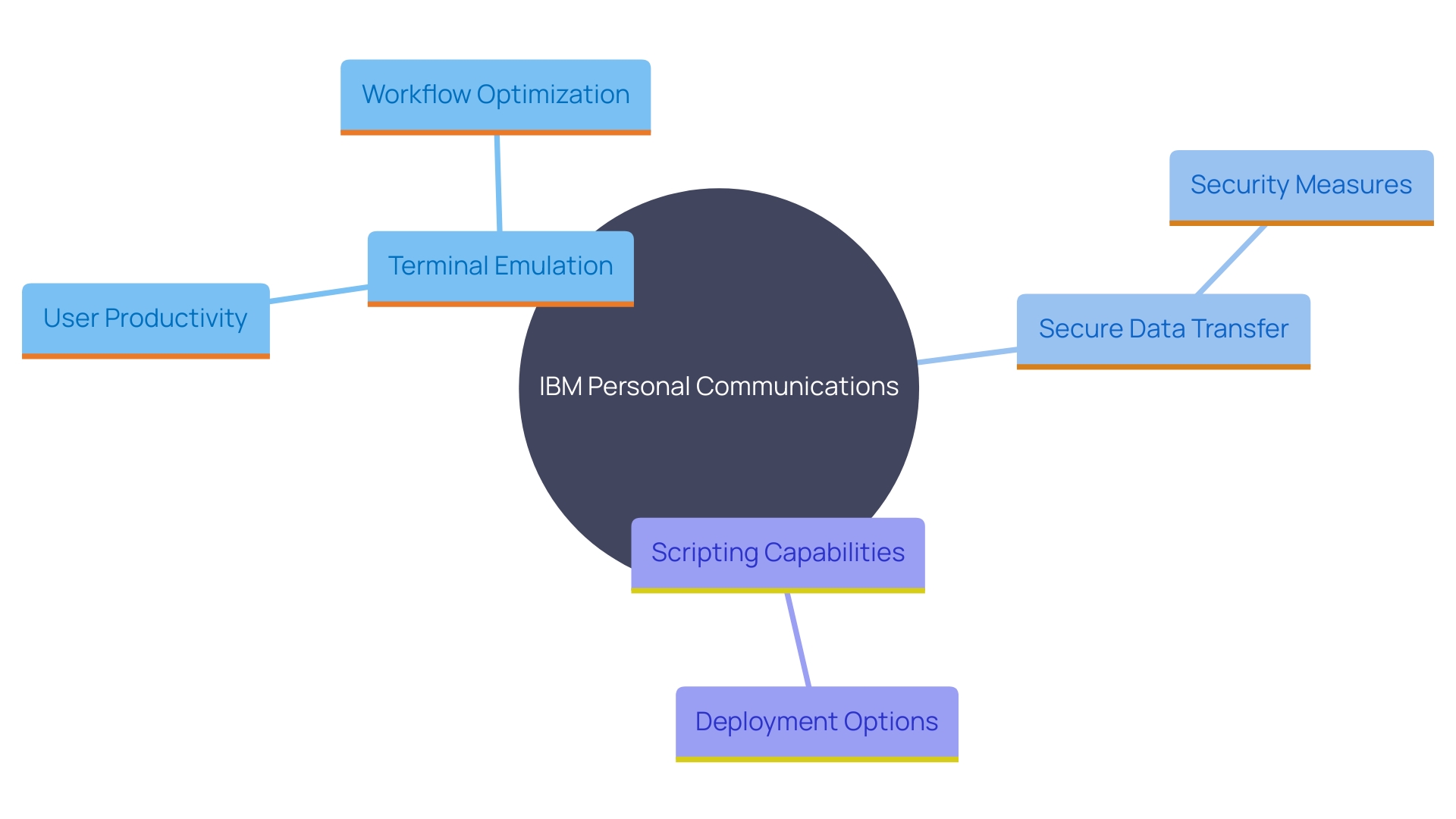
Security and Connectivity
In today’s digital landscape, security is paramount. IBM’s software addresses this need by incorporating comprehensive security protocols designed to protect against unauthorized access and data breaches. The solution supports secure connections over various networks, including VPNs, ensuring that data transmitted between users and systems remains confidential. Furthermore, the integration of TLS and SSL protocols provides an added layer of security, allowing for secure communications across all endpoints.
The importance of secure communication cannot be overstated, especially in light of recent findings. For instance, an analysis of WeChat’s proprietary encryption protocol, MMTLS, revealed several weaknesses due to deviations from standard cryptographic practices. This emphasizes the essential requirement for strong security protocols similar to those put in place by IBM, which conform to recognized standards to avoid weaknesses.
Moreover, the cyber threat landscape is constantly evolving, with Gartner reporting that a company’s attack surface can see over 300 new services monthly, contributing to significant exposure risks. By utilizing advanced security protocols, IBM ensures that sensitive information stays safeguarded against these constant threats.
Incorporating insights from cybersecurity experts, it’s clear that focusing on secure, encrypted communications is essential for mitigating risks. As highlighted in a recent webinar, comprehending and tackling key threats and developments in cybersecurity is crucial for entities to stay ahead of potential attacks. ‘IBM’s method for secure connectivity exemplifies this proactive stance, providing peace of mind in a complex digital environment.’.
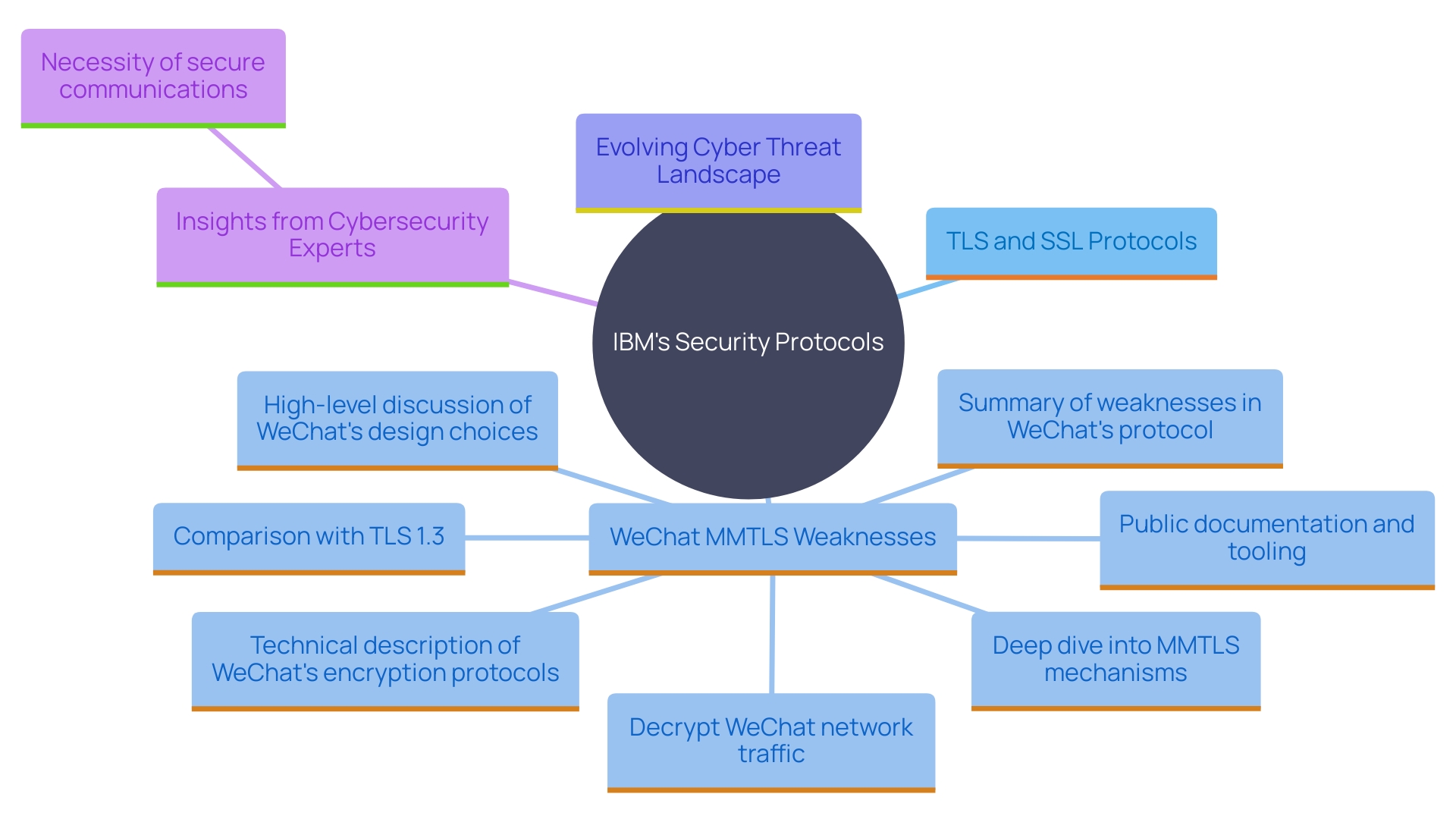
Integration and Automation
Incorporating IBM Personal Communications with the current IT infrastructure provides a transformative benefit for entities striving to enhance their operations. This integration facilitates seamless connectivity with various enterprise applications, enabling automated workflows that drastically reduce the need for manual intervention. By leveraging built-in automation features, businesses can significantly enhance efficiency, minimize errors, and ensure consistent data updates across all systems. This capability is especially beneficial for companies looking to modernize their legacy systems without causing disruptions to current processes.
For example, a large U.S. financial services company faced significant performance issues and delays due to its monolithic application architecture. By modernizing its application architecture and incorporating automation, the company was able to streamline workflows, reduce costs, and improve performance. This case highlights the broader potential of automation to spur economic growth, boost productivity, and minimize losses, even as it displaces certain jobs.
Despite the clear benefits, implementing automation projects can be challenging. Statistics show that 90% of automation projects fail due to technical issues, 37% due to implementation costs, and 25% because of a lack of overall vision or strategy. Moreover, the third biggest challenge to implementing automation is resistance to change. However, by adopting a wide variety of integration techniques and a platform approach that supports multiple methods, entities can overcome these obstacles and achieve significant operational efficiencies.
The ability to integrate advanced technologies like AI and cloud with existing systems creates a well-coordinated environment that optimizes data and application portability. As businesses continue to adopt these technologies, they must evaluate how they align with long-term organizational needs to leverage their full potential effectively. This strategic approach to integration not only addresses the current state of data problems and implementation challenges but also sets the foundation for future growth and innovation in the automation landscape.
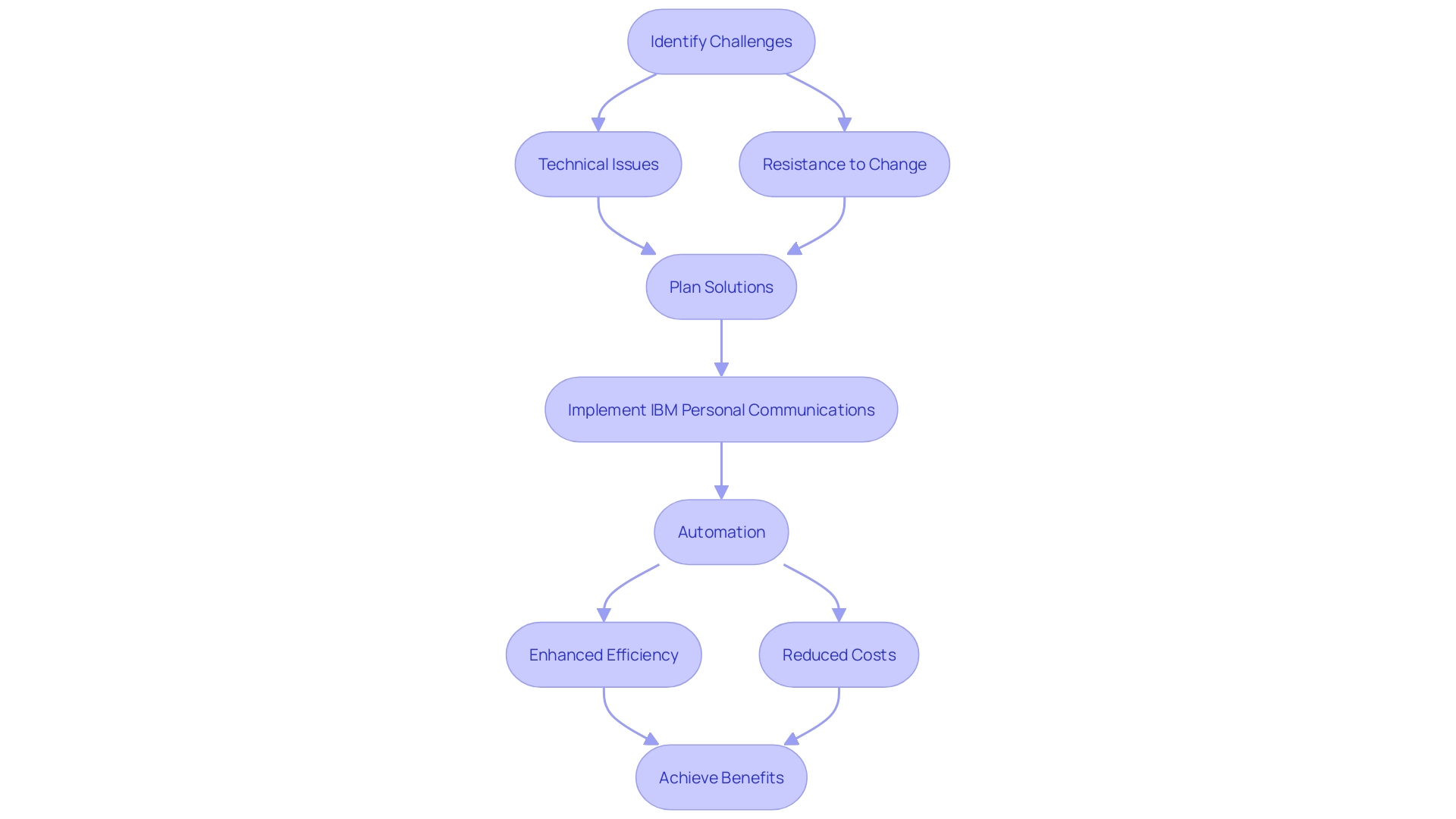
Modern IT Environment Considerations
As companies evolve, their IT environments become increasingly complex. IBM’s software is created to adjust to these changes, providing versatility and scalability to satisfy the needs of contemporary businesses. With its support for virtualization and cloud-based deployments, businesses can deploy this solution seamlessly across various platforms and devices. This adaptability ensures that entities can maintain productivity regardless of their operational environment, whether on-premises or in the cloud, facilitating a smoother transition into advanced technological landscapes.
Supporting this scalability, IBM’s hybrid cloud platform and Red Hat OpenShift have been pivotal for over 4,000 government and corporate entities in critical infrastructure areas such as financial services, telecommunications, and healthcare. These entities rely on IBM to streamline business processes, reduce costs, and gain a competitive edge in their industries.
Moreover, the push towards modernization is evident in examples like Lincoln Financial’s migration from legacy systems to a dynamic cloud-based architecture. As Rob Klaczak, Senior Vice President at Lincoln Financial, notes, the primary goals were to reduce operating costs, manage expenses from specialized software, and transition to a more flexible environment. This transformation, completed in under two years, highlights the efficiency and agility that modern IT solutions can offer.
IBM Individual Interactions not only supports current IT needs but also prepares organizations for future advancements. This includes the growing demand for AI-driven solutions that can automate tedious tasks, freeing up employees for more meaningful work. As demonstrated by an engineering team that automated data extraction from 2,000 PDF documents, AI integration can significantly enhance productivity and provide greater value to the company.
In a landscape where inflation and digital modernization efforts are driving IT leaders to revisit cloud costs, IBM Personal Communications stands out by offering a comprehensive, scalable, and cost-effective solution that aligns with the strategic goals of modern enterprises.
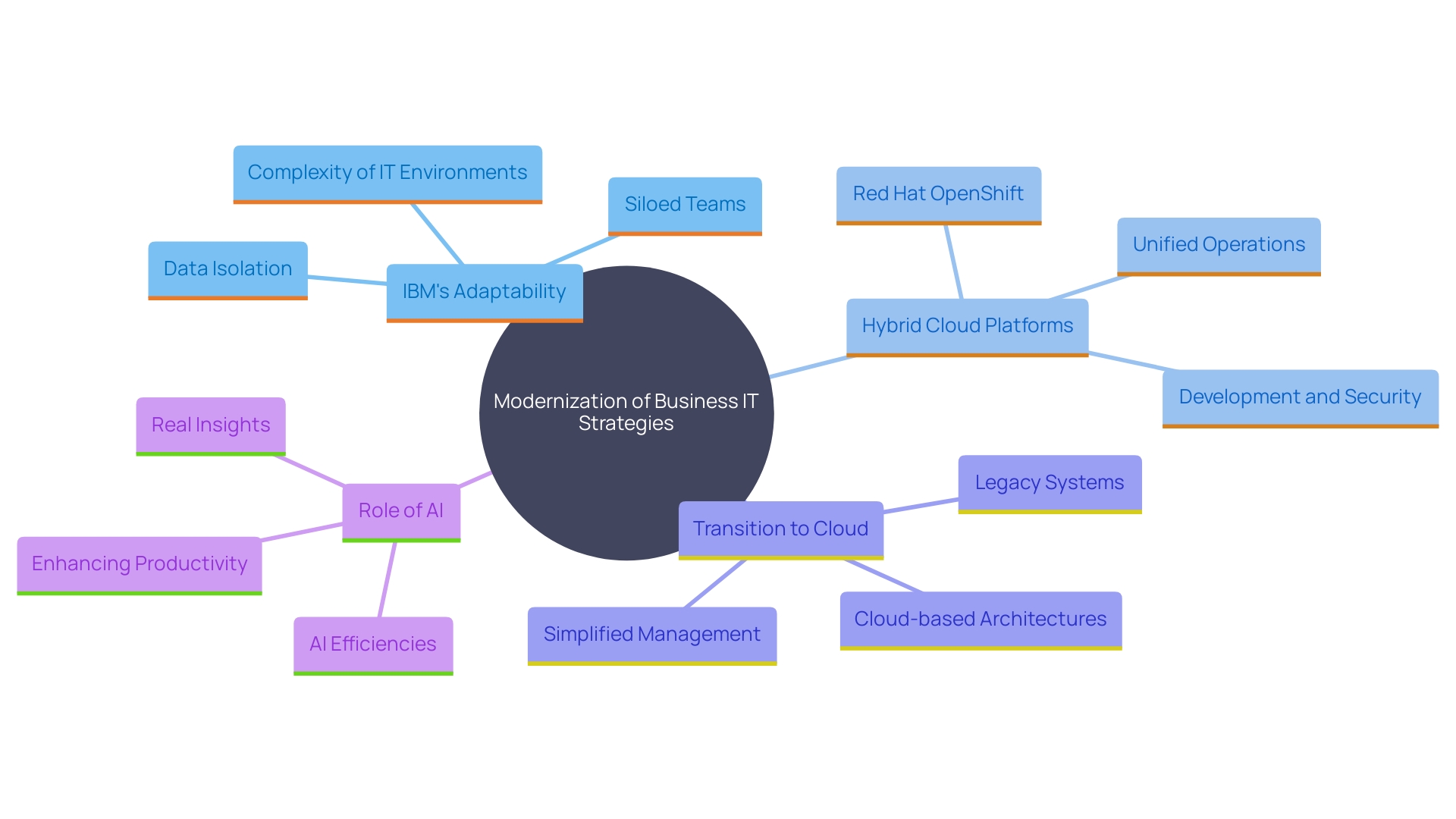
Conclusion
Embracing IBM Personal Communications presents a strategic advantage for organizations seeking to enhance operational efficiency and security. By leveraging its suite of advanced features, including terminal emulation, secure data transfer, and integrated scripting capabilities, businesses can modernize their legacy systems while maintaining stringent security standards. The adaptability of the solution, whether deployed on-premises or in the cloud, provides the necessary flexibility to meet diverse operational needs.
Security remains a top priority in today’s digital landscape, and IBM Personal Communications addresses this challenge with robust protocols designed to protect sensitive information. By supporting secure connections and adhering to established standards, organizations can safeguard their data against evolving cyber threats. This proactive approach ensures that businesses can operate with confidence, knowing that their information remains protected in a complex environment.
The integration and automation capabilities of IBM Personal Communications further transform organizational workflows. By facilitating seamless connectivity with enterprise applications, the solution reduces manual intervention and minimizes errors, driving efficiency across operations. As businesses modernize their IT infrastructure, the ability to incorporate advanced technologies such as AI and cloud solutions will be crucial in optimizing processes and fostering innovation.
In a rapidly changing IT landscape, IBM Personal Communications positions organizations for future growth. Its scalability and support for hybrid cloud environments enable businesses to adapt and thrive, ensuring they remain competitive. By adopting this comprehensive solution, companies can not only address current operational challenges but also prepare for the technological advancements of tomorrow, ultimately driving productivity and success in an evolving digital world.
Introduction
The Robotic Process Automation (RPA) market is witnessing unprecedented expansion, driven by the escalating demand for automation solutions across diverse industries. Predictions indicate a remarkable annual growth rate exceeding 30%, as companies seek to enhance operational efficiency, cut costs, and improve accuracy. The advent of hyperautomation, integrating RPA with AI, has further revolutionized the landscape, enabling the automation of complex tasks that previously required extensive manual intervention.
This transformative technology is set to bolster the industrial automation sector, which is projected to grow significantly in the coming years.
Moreover, the COVID-19 pandemic has accelerated RPA adoption, highlighting its resilience and flexibility in maintaining business continuity. Sectors such as healthcare, finance, and supply chain management have particularly benefited, with RPA streamlining operations and enhancing agility in response to disruptions. The rise of Intelligent Process Automation (IPA), combining RPA with advanced AI technologies, is enabling businesses to automate intricate processes, thereby driving productivity and innovation.
As RPA tools proliferate, establishing robust governance and standardization frameworks becomes crucial. Companies are increasingly prioritizing the creation of comprehensive guidelines to ensure compliance, mitigate risks, and optimize performance. This strategic approach to RPA governance is essential for sustaining growth and maximizing the benefits of automation in the evolving digital landscape.
RPA Market Expansion: Forecasts and Predictions
The Robotic Process Automation (RPA) market is on the verge of substantial expansion, driven by the rising need for mechanized solutions across different sectors. Analysts project a soaring compound annual growth rate (CAGR) of over 30% for the global RPA market. This surge is driven by organizations striving to enhance operational efficiency, reduce costs, and improve accuracy in their processes.
The integration of RPA with AI technology, referred to as hyperautomation, has transformed the landscape of automated processes. This mixture of mechanized functions tackles the complexity and variability of tasks, such as invoice analysis, which previously posed challenges. Hyperautomation’s ability to handle diverse document variations without extensive pre-programming exemplifies its transformative potential.
Supporting this trend, the industrial automation sector is experiencing substantial expansion, with forecasts predicting a 9.3% annual increase, reaching £227.6bn by 2030. This increase is fueled by advancements in technology and heightened demand across multiple sectors, including manufacturing, oil and gas, and power generation. The manufacturing sector alone accounts for over 30% of the market, driven by the need for operational resilience and supply chain stability amidst geopolitical tensions.
Robert McElmurry, Director of Business Intelligence at the Association for Advancing Automation (A3), emphasizes the importance of RPA and hyperautomation in the broader context of digital transformation. He notes, ‘As businesses continue to embrace digital transformation, RPA will play a crucial role in automating repetitive tasks and streamlining workflows.’
In conclusion, the RPA market’s exponential growth, coupled with the innovative potential of hyper automation, positions it as a pivotal force in the ongoing evolution of industrial automation. This transformation not only enhances efficiency but also aligns with global efforts toward operational resilience and sustainability.
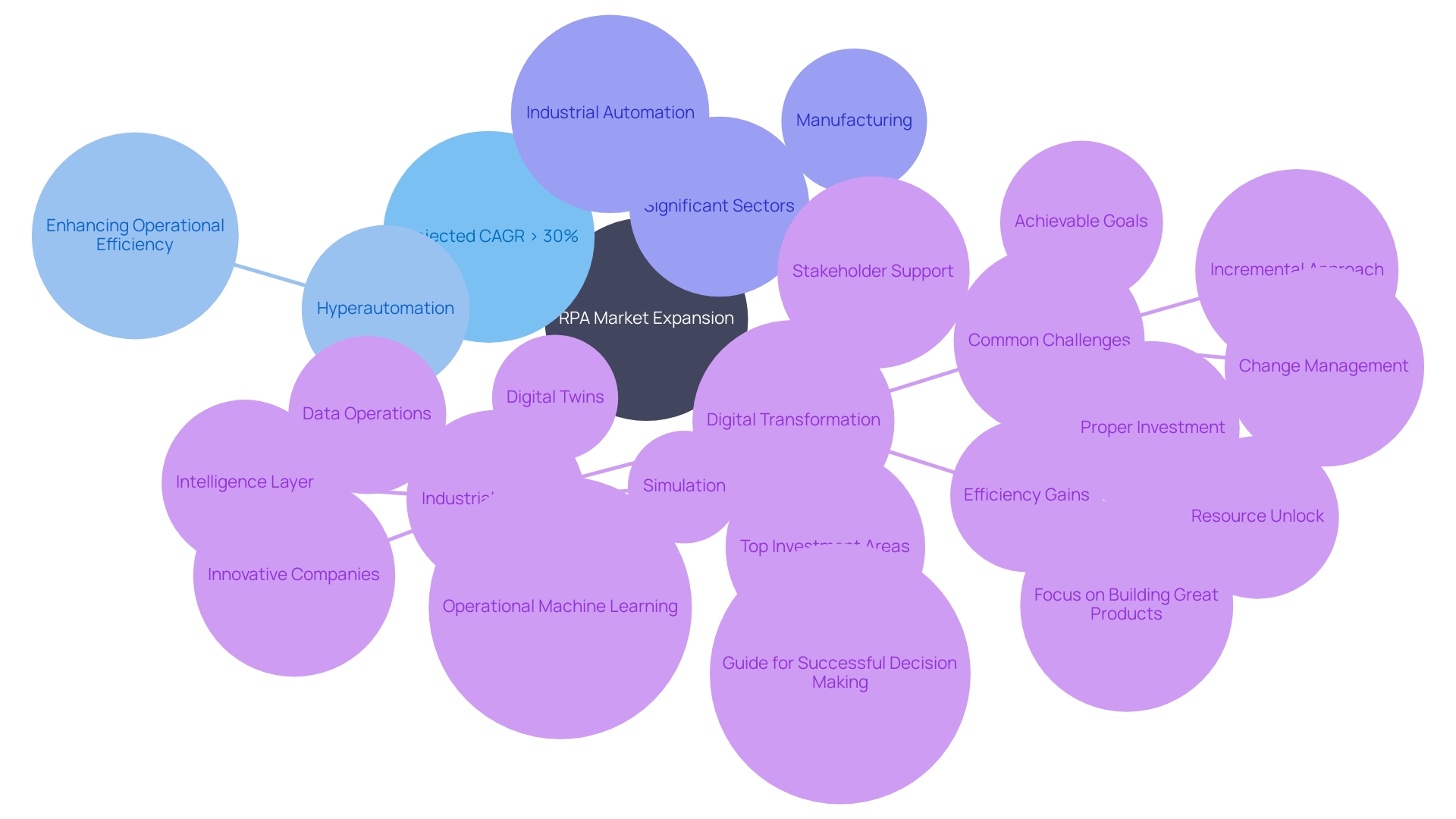
Impact of COVID-19 on RPA Adoption
The COVID-19 pandemic has sped up the adoption of Robotic Process Management (RPA) as organizations sought to adjust to remote work and maintain business continuity. Companies that had already integrated RPA solutions were better positioned to pivot during the crisis, showcasing the technology’s resilience and flexibility. This shift has opened new avenues for RPA deployment across various sectors, including healthcare, finance, and supply chain management.
For instance, in the healthcare sector, the integration of RPA has been pivotal. Companies like Ambience have leveraged partnerships to boost their products to new heights by enhancing interoperability and data integration with healthcare systems. This rapid adoption, sometimes within just two to six weeks, has underscored the importance of RPA in improving operational efficiency and reducing the time required for system integration.
In finance, RPA has transformed the revenue cycle by automating routine tasks, allowing staff to focus on more strategic initiatives. Amy Raymond, Senior Vice President of Revenue Cycle Operations at AKASA, emphasizes, “The use of technology is no longer simply an option in the revenue cycle — it is an imperative.” These technologies drive significant improvements in revenue yield, cost reduction, and staff efficiency.
The supply chain sector has also seen significant advancements with RPA. The use of technology has allowed companies to streamline operations, enhance agility, and respond more effectively to disruptions. As organizations continue to prioritize RPA investments, they build more agile operations capable of withstanding future disruptions, ensuring a robust and resilient business model.
The market for robotic operating systems is expected to grow significantly, with projections indicating a rise from $534.2 million in 2022 to $1.8 billion by 2032. This growth highlights the increasing recognition of RPA’s value across various industries, further solidifying its role as a critical component in modern business operations.
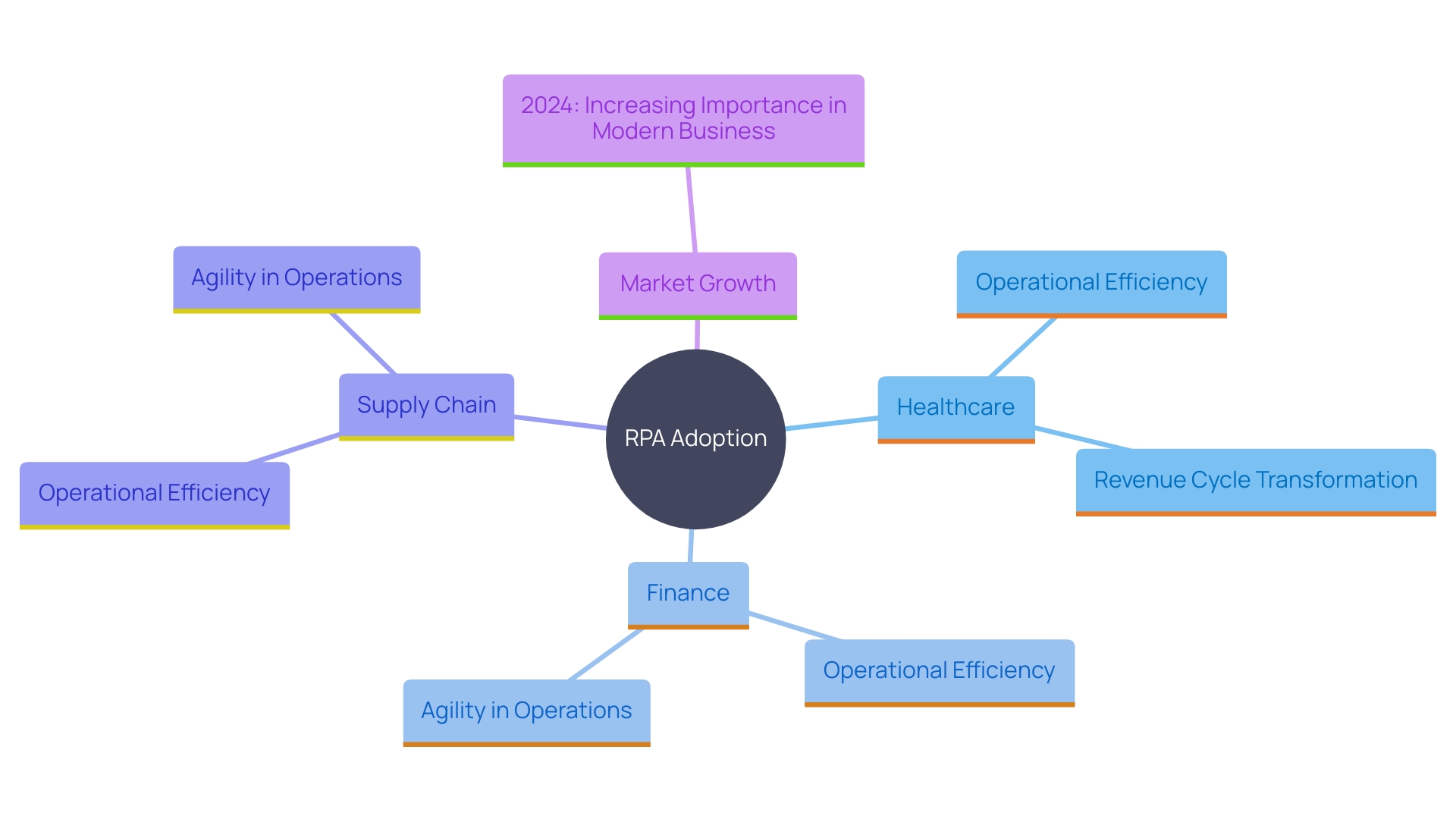
Rise of Intelligent Process Automation (IPA)
As organizations work to improve their mechanization capabilities, the emergence of Intelligent Process Automation (IPA) is becoming more and more important. IPA merges Robotic Process Automation (RPA) with advanced technologies like artificial intelligence, machine learning, and natural language processing. This powerful combination enables more complex decision-making and sophisticated data analysis, allowing businesses to automate not only repetitive tasks but also intricate processes.
For instance, Titan Industries used IPA to streamline their order-to-cash process by addressing credit blocks. By integrating AI-powered solutions, they accelerated decision-making and reduced delays in order fulfillment, particularly for reliable customers. This example underscores how IPA can resolve bottlenecks, enhancing operational efficiency and customer satisfaction.
Furthermore, IPA’s scalability is evident in scenarios where manual data extraction from thousands of documents was automated, freeing employees to focus on more creative and impactful work. This not only improved productivity but also demonstrated how the same AI models could be applied across various business units, amplifying the overall value.
The shift towards IPA marks a pivotal evolution in RPA, unlocking greater potential for businesses. It empowers organizations to focus on high-value activities, transforming their operational landscape and positioning them for success in the competitive market. With 83% of companies prioritizing AI in their strategies, the adoption of IPA is poised to drive transformative changes, enhancing efficiency, productivity, and innovation.
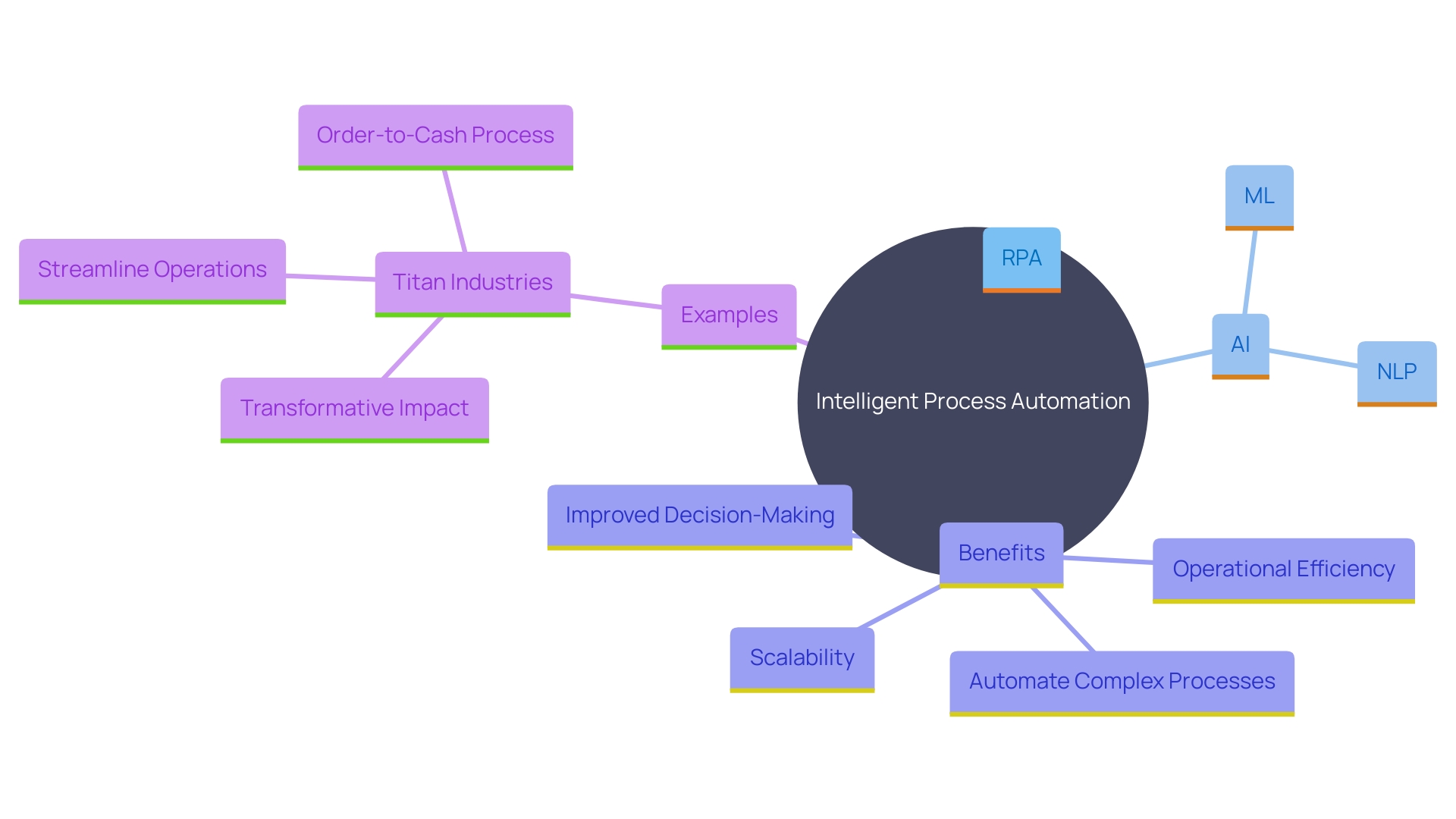
RPA Governance and Standardization: A Growing Priority
As RPA tools and implementations continue to expand rapidly, the need for robust governance and standardization becomes increasingly vital for organizations. Establishing clear guidelines and best practices for RPA usage is essential to ensure compliance, mitigate risks, and optimize performance. Companies are increasingly recognizing the importance of creating a centralized governance framework that encompasses RPA strategy, tool selection, and performance monitoring. According to Blake Jensen, SVP of Quality Assurance at HUYABIO International, companies are exploring risk assessment approaches that enable them to be more efficient and keep up with technology advancements, which aligns with the necessity for a comprehensive governance framework. Additionally, good data governance practices can significantly improve the day-to-day operations, efficiency, and effectiveness of a team or program, as demonstrated by the internal WWT project, the RFP Assistant. This focus on governance will help organizations maximize the benefits of RPA while minimizing potential pitfalls, ensuring sustainable growth in their automation journey.
Conclusion
The Robotic Process Automation (RPA) market is set for substantial growth, with projections indicating an annual increase of over 30%. Organizations are embracing RPA to improve operational efficiency and reduce costs. The combination of RPA with artificial intelligence, known as hyperautomation, is revolutionizing the automation landscape by enabling the handling of complex tasks that were previously labor-intensive.
The COVID-19 pandemic has accelerated the adoption of RPA, as businesses sought solutions to maintain continuity and adapt to remote work. Key sectors, including healthcare, finance, and supply chain management, have leveraged RPA to enhance operational agility and streamline processes in response to disruptions.
Moreover, the rise of Intelligent Process Automation (IPA) further enhances the capabilities of RPA by integrating advanced technologies such as machine learning and natural language processing. This allows organizations to automate not only repetitive tasks but also more complex processes, fostering innovation and productivity.
To maximize the benefits of RPA and IPA, establishing strong governance and standardization is critical. Implementing clear guidelines and best practices ensures compliance, mitigates risks, and optimizes performance. A robust governance framework will enable organizations to navigate the complexities of the digital landscape effectively.
By prioritizing these strategies, businesses can achieve sustainable growth and thrive in an increasingly competitive environment.
Introduction
In the rapidly evolving landscape of operational efficiency, Robotic Process Automation (RPA) stands out as a transformative force reshaping businesses’ approach to repetitive tasks. By facilitating automation without the need for extensive coding, RPA is not only streamlining processes but also significantly enhancing overall productivity. From notable improvements in production speeds at St. James Winery to resolving bottlenecks in the finance department of Mass General Brigham hospital system, RPA’s impact is evident across various industries.
This technology allows companies to operate continuously, reduce human errors, and shift employee focus from mundane activities to more strategic initiatives. As organizations grapple with increasing demands and labor shortages, the adoption of RPA emerges as a sustainable solution, ensuring higher accuracy, reduced costs, and improved operational efficiency. This article delves into the essentials of RPA, its key components, and step-by-step implementation strategies to help businesses unlock its full potential.
Understanding RPA and Its Benefits
Robotic Process Automation (RPA) is transforming the manner in which organizations manage repetitive activities by automating them without requiring extensive coding. This technology is not only transforming operational processes but also enhancing overall efficiency. For instance, companies like St. James Winery have seen significant improvements in production speeds and margins by integrating RPA into their operations. This automation enables businesses to function around the clock, removing the necessity for overtime compensation or temporary personnel during busy periods, and ensuring greater precision by minimizing human mistakes in activities such as data entry and report creation.
A notable example is the finance department of Mass General Brigham hospital system in Boston, which faced bottlenecks in tracking healthcare providers. By forming an automation group and reorganizing workflows, they created a tool that automated data gathering and arrangement, allowing employees to concentrate on more strategic activities. This kind of implementation showcases how RPA can handle large volumes of data efficiently and integrate seamlessly with existing software systems.
The benefits of RPA extend beyond efficiency and cost savings. It allows employees to redirect their attention from routine activities to more strategic initiatives, fostering innovation and creativity. According to a recent Gallup survey, while 67% of workers never use AI tools at work, those who do report significant gains in productivity and efficiency.
By automating regular activities, RPA enables companies to sustain greater precision, lower expenses, and enhance overall efficiency. As organizations continue to face increasing demands and labor shortages, the adoption of RPA offers a sustainable solution for maintaining competitive edges and achieving operational excellence.
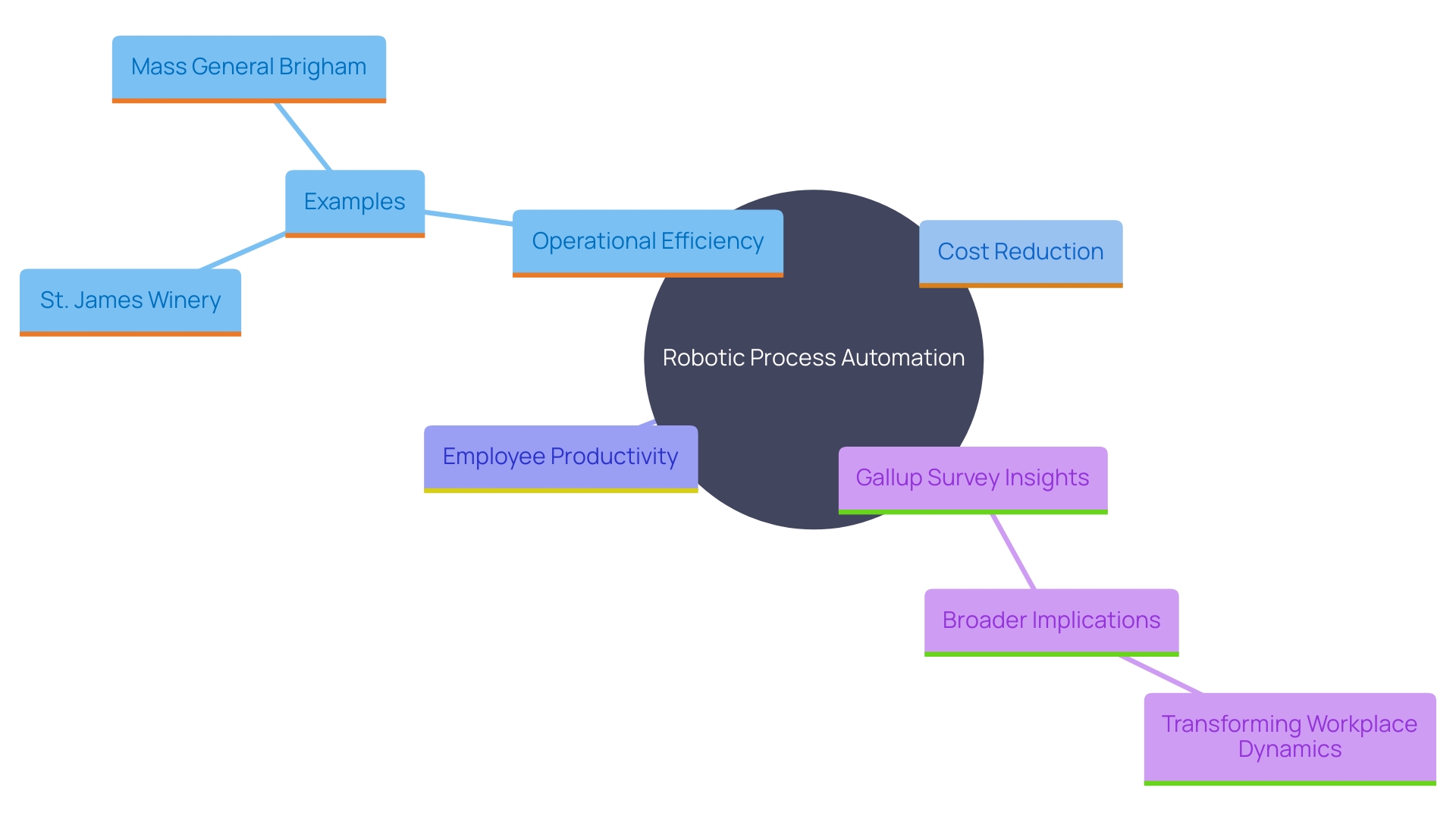
Key Components of RPA Bots
RPA automation tools are composed of several essential components, including the RPA software, user interface, and backend systems. The RPA software allows bots to engage with applications in a way akin to human users, automating repetitive activities such as data entry and form filling. This interaction at the user interface level is one of the core strengths of RPA, as it allows for seamless integration with existing systems, minimizing the need for manual intervention.
Understanding these components is crucial for the effective deployment of RPA solutions. For instance, at Delivery Hero, the implementation of RPA helped address the issue of employees getting locked out of their accounts. Before automation, the IT team would handle around 800 requests per month, each taking an average of 35 minutes to resolve. By automating the identity verification and access restoration process, Delivery Hero significantly reduced the downtime for employees, enhancing overall productivity.
Similarly, Spordle, a leading Sports Management ERP, leverages RPA to streamline customer support processes. By automating repetitive activities, the customer support team, directed by Gilles Taillon and Kim Thomas, can concentrate on more complex issues, ensuring high customer satisfaction and current knowledge bases.
Moreover, enterprises like Wesco are exploring the integration of RPA with advanced technologies such as AI and machine learning to unlock new levels of efficiency and productivity. The utilization of these cutting-edge technologies, combined with strategic partnerships and expert guidance, can elevate automation initiatives to new heights, as noted by industry experts.
In summary, the key to successful RPA deployment lies in a thorough understanding of its components and strategic integration with existing processes. By doing so, organizations can achieve significant improvements in operational efficiency and productivity.
Step 1: Identifying Tasks for Automation
The initial phase in executing RPA is to recognize activities that are repetitive, rule-based, and time-consuming. It’s essential to start with smaller, manageable activities before scaling up to more complex workflows. Engage with employees to understand their daily routines and pinpoint bottlenecks in their processes. This collaborative approach ensures the chosen activities for automation will lead to substantial efficiency gains. Employing tools like the Task Automation Index can assist in ranking activities based on their automation potential, taking into account elements such as standardized input, well-defined rules, repetitiveness, data dependency, and objective outputs. Continuous monitoring of these automated processes is crucial to document results and refine strategies, ensuring ongoing improvements and maximized benefits.
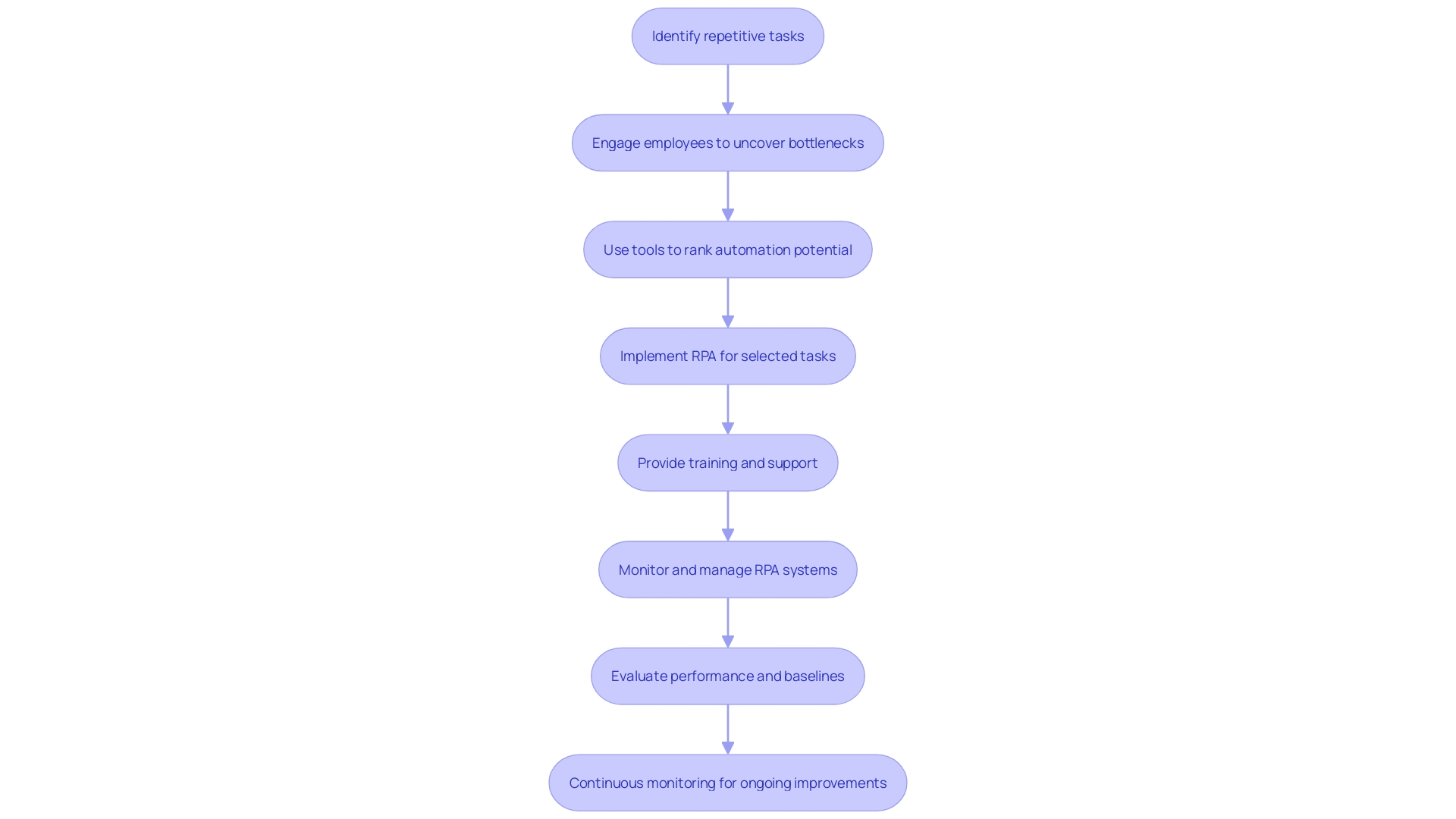
Step 2: Designing the RPA Workflow
Once tasks are identified, the next step is to create the process for the RPA bot. This includes mapping out each step of the process, determining decision points, and establishing the inputs and outputs. A well-structured process will assist in creating a more efficient bot. For instance, the engineering team at Dubber achieved notable success utilizing Temporal for their process orchestration, which enabled them to outline sequences of steps efficiently. Likewise, the execution of SmartFlow, an AI-driven RPA system, illustrates how sophisticated tools can adjust to new situations without human involvement, utilizing computer vision and natural language processing to improve efficiency in processes.
Case studies such as Rivian’s illustrate the importance of collaboration across dispersed teams, where specialized talents in different locations must work together efficiently. These efforts emphasize the necessity for strong and flexible processes to manage intricate, multi-location operations effortlessly. Additionally, experts emphasize that automation is not entirely hands-off; monitoring and management are crucial for ensuring stability and optimizing the return on investment. This is reflected in the results from Computational Management, which advises dividing tasks into fundamental components and utilizing task specification templates to choose the most appropriate AI solutions for incorporation into processes.
In practice, a collaborative method in creating the process, involving both analysts and those accountable for the activities, ensures that all steps are well-documented and easily understood. This method not only simplifies the automation process but also makes it adaptable to changes and improvements over time, thereby enhancing operational efficiency and productivity.
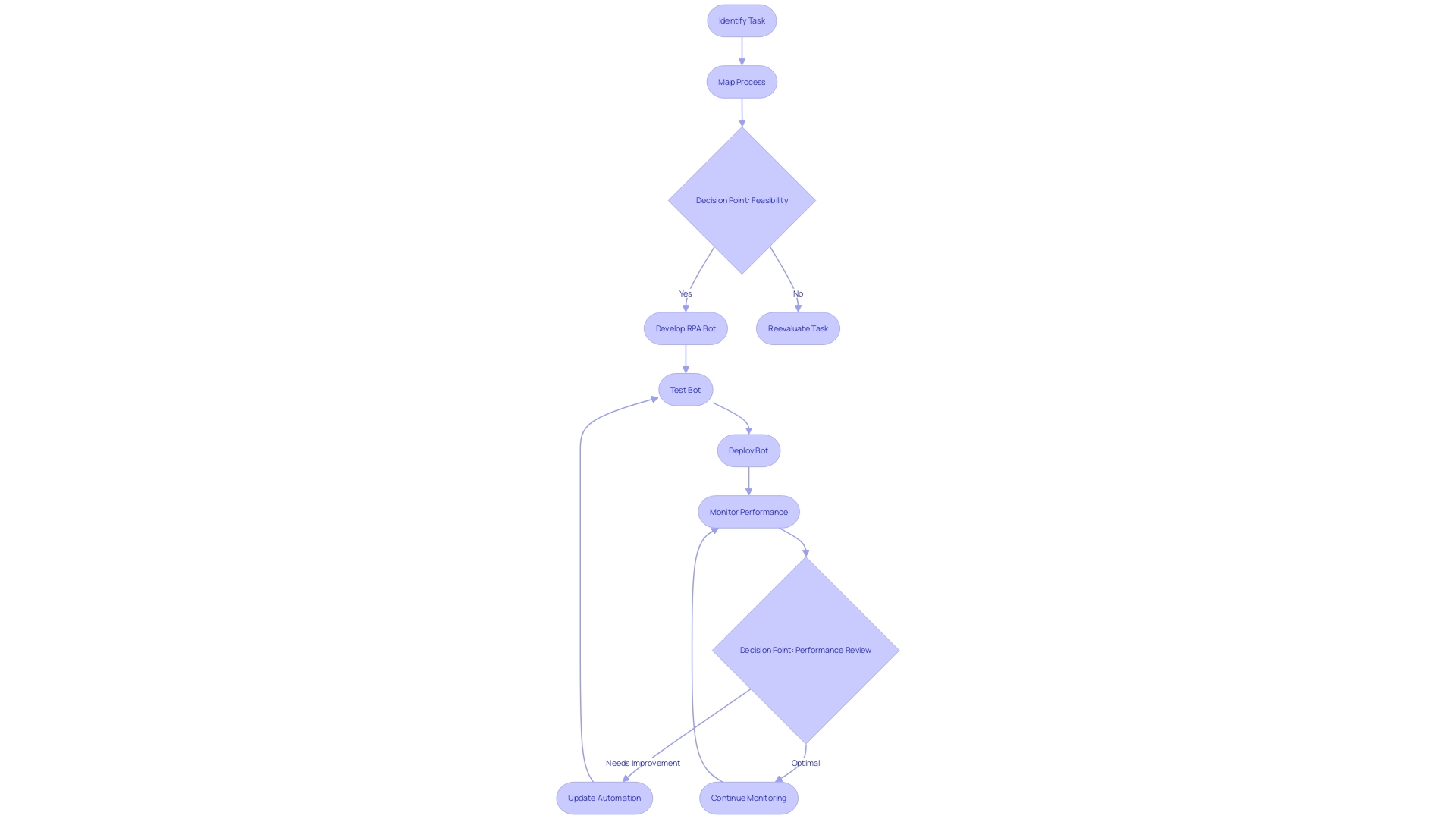
Step 3: Developing the RPA Bot
After creating the process, the next step is to develop the RPA bot using the chosen RPA platform. This process entails setting up the bot to conform to the established procedure, merging it smoothly with current systems, and guaranteeing strong exception management. Incorporating integrations may require fine-tuning to manage permissions and access controls effectively, as observed with SuccessFactors API, where Role-Based Permissions (RBP) were essential for initiating processes. Moreover, it is vital to monitor the bot’s performance and health, similar to how Amazon CloudWatch provides metrics and logs to proactively identify and resolve issues. By 2025, the automation market is anticipated to attain $18.45 billion, emphasizing the increasing significance of these technologies in improving productivity and operational efficiency.
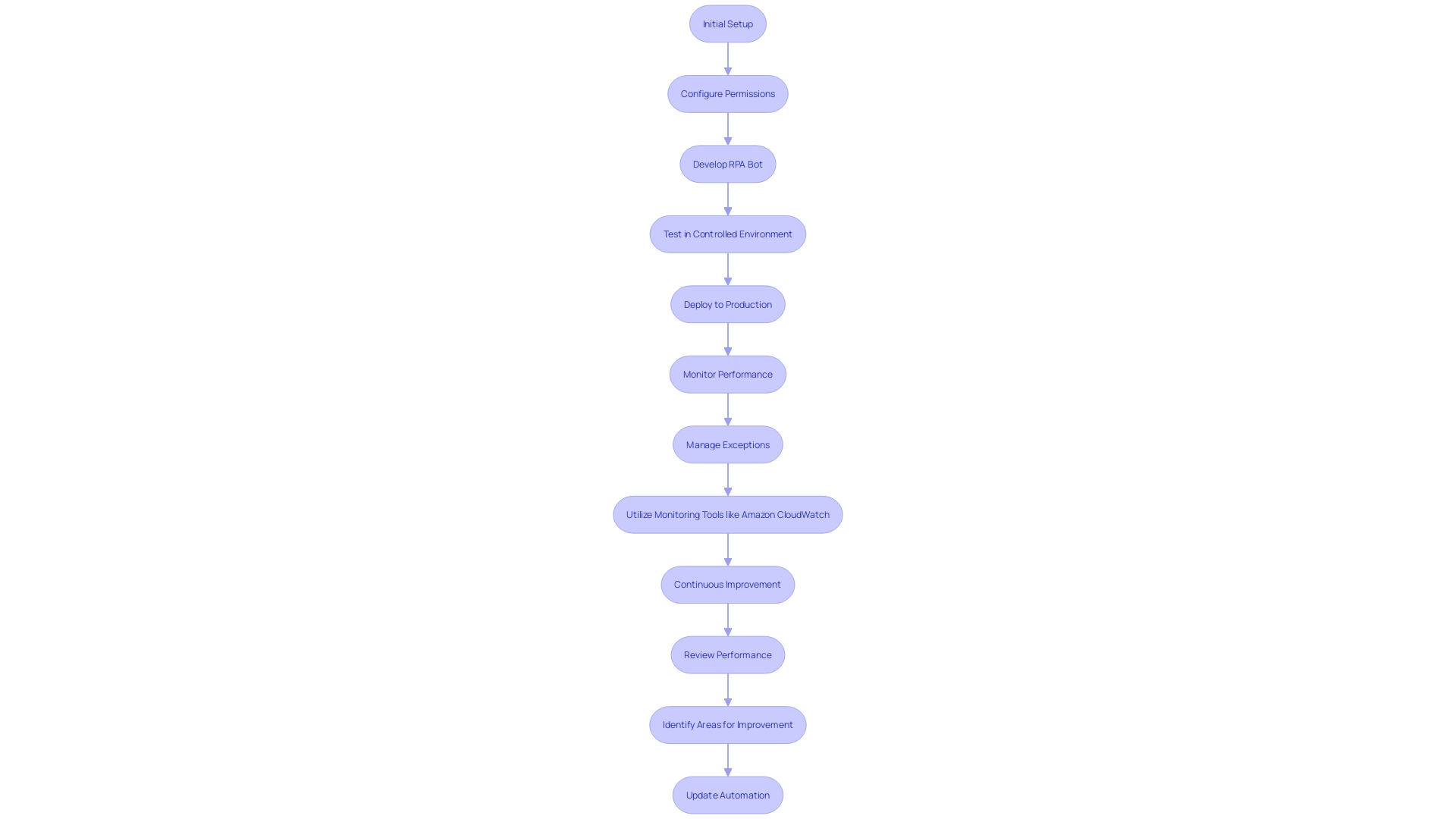
Step 4: Testing the RPA Solution
Before deploying the RPA bot, thorough testing is necessary to ensure it operates as expected. This involves a multi-step approach, beginning with clear planning and preparation. Defining the scope, tool selection, and framework setup are crucial initial steps. Just like setting the GPS before a road trip, you must clearly define your objectives, scope, and metrics for success before starting your RPA testing.
Testing isn’t just about functionality; it encompasses the bot’s interactions with databases, networks, and other applications, offering a comprehensive view of the system’s health. Unit testing focuses on individual components, while end-to-end testing examines the entire workflow in a simulated environment that mirrors the production setup. This ensures the bot can handle tasks without errors and adapt to changes in the software environment.
Designing test cases for RPA is akin to preparing for a cooking show. You need the right ingredients (test data), the right tools (automation scripts), and a well-thought-out recipe (test case). Considering that RPA tools engage with various systems, your test cases ought to encompass all potential situations, including edge cases. This meticulous approach not only identifies issues that need resolution before full-scale implementation but also saves time and money by preventing costly errors in live environments.
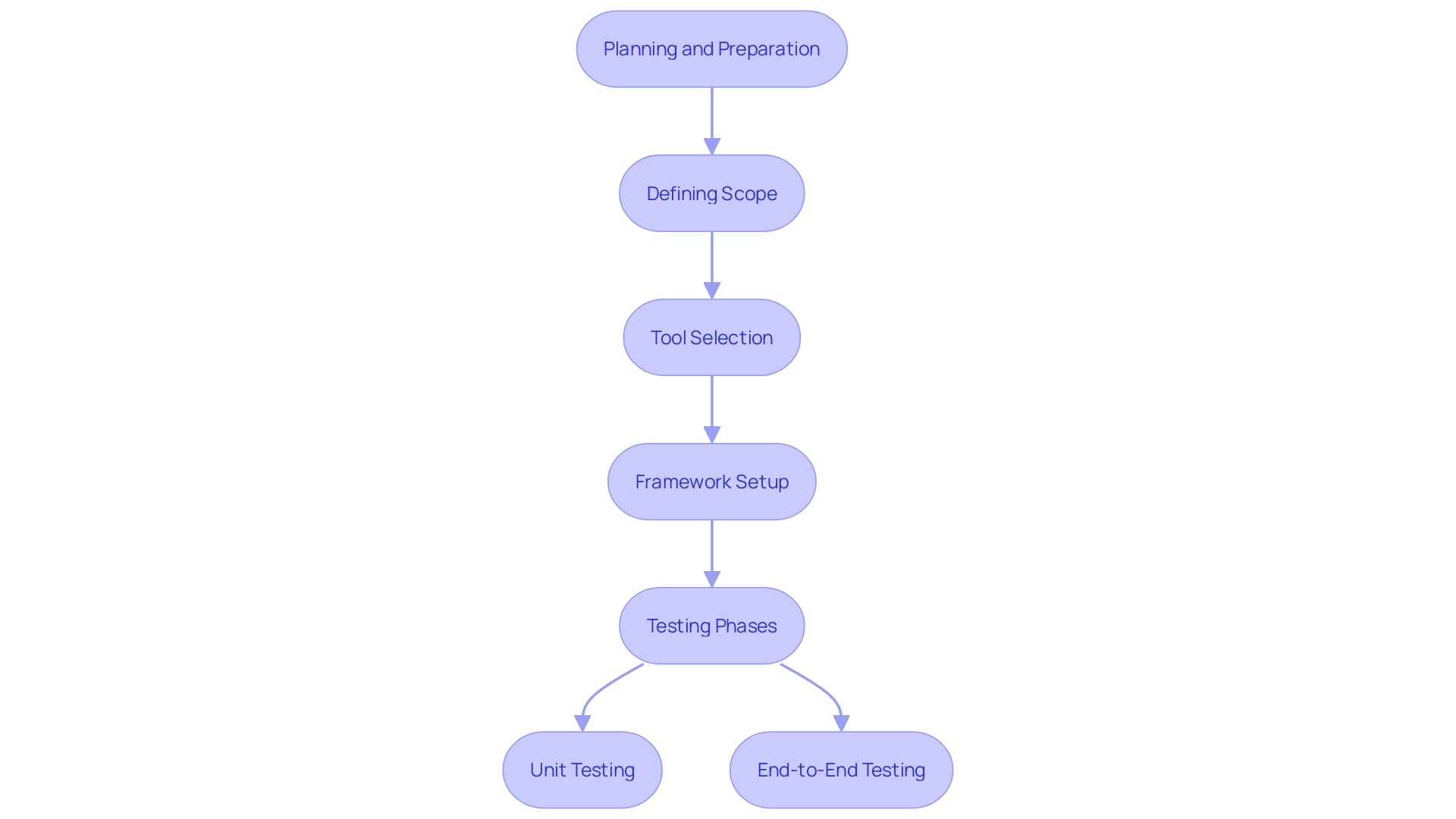
Step 5: Deploying and Monitoring the RPA Bot
After successful testing, the RPA bot can be deployed into the production environment. However, continuous monitoring is essential to ensure the bot performs as intended and to quickly address any errors or changes in the underlying processes. Just like any other sophisticated system, RPA is not a ‘set it and forget it’ solution. Organizations need to actively manage and monitor these automated systems to close any operational and governance gaps.
As seen with Electrolux Group’s collaboration with ABB, the implementation of automation significantly improved their production line’s efficiency and safety. The introduction of the YuMi cobot automated the gas leak detection process, eliminating repetitive manual operations and enhancing accuracy. This case highlights the importance of continuous oversight and adaptation to maintain optimal performance and leverage the full benefits of RPA.
Monitoring also aids in recognizing and managing distribution shifts, ensuring that the automated systems adjust to changes in the environment and continue to operate properly. For instance, Bosch’s AI-based energy management system in Changsha continuously retrains algorithms to improve success rates, demonstrating the necessity of ongoing adjustments and refinements.
In conclusion, while RPA bots can transform operational efficiency, their success hinges on diligent monitoring and management. This approach not only ensures seamless operation but also maximizes the return on investment by maintaining the stability and effectiveness of the automation.
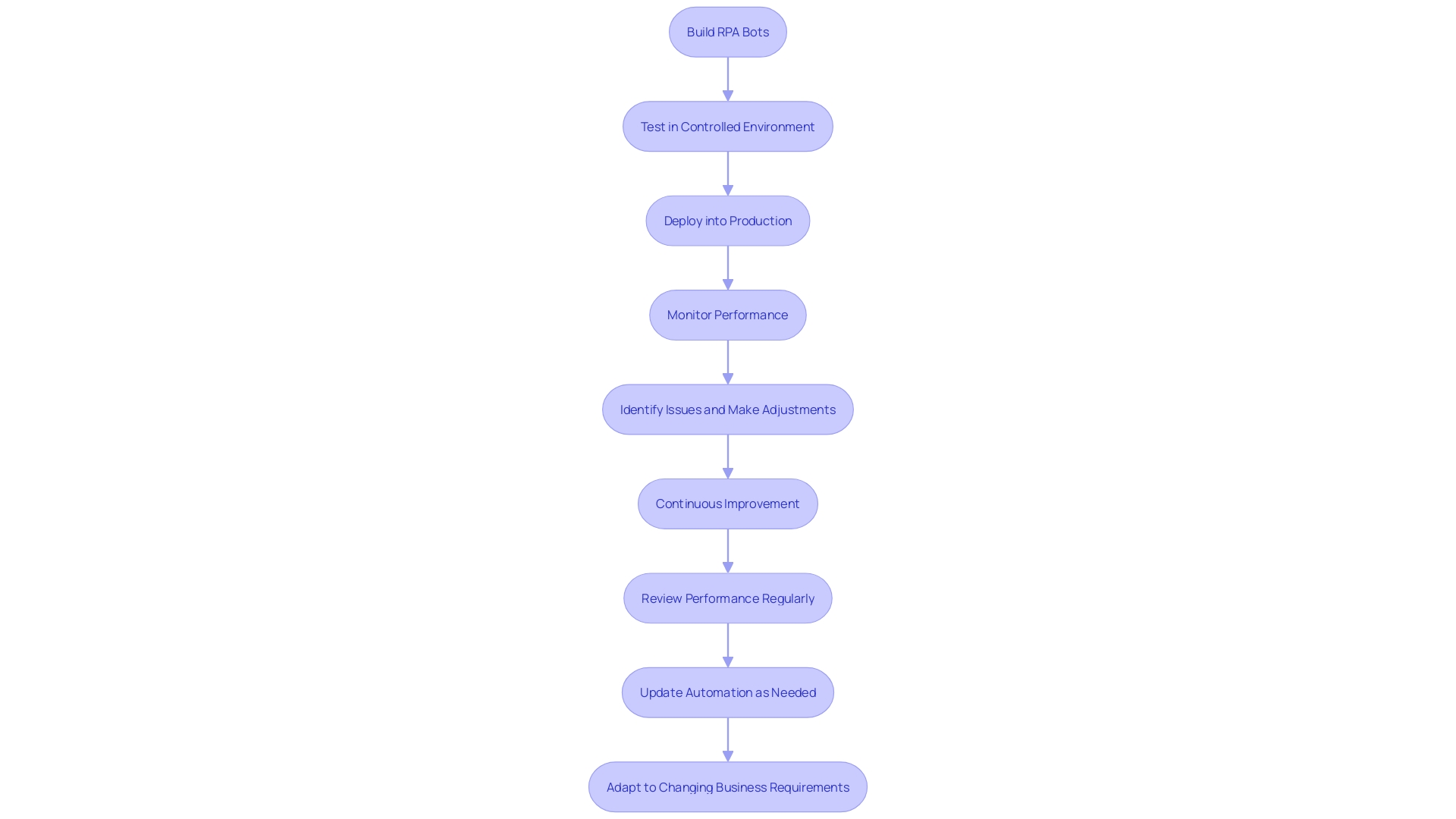
Measuring Success and ROI of RPA Implementation
To evaluate the effectiveness of RPA implementation, it’s crucial to establish key performance indicators (KPIs) and measure the return on investment (ROI). These KPIs should include metrics like time savings, error reduction, and overall productivity improvements. For instance, the finance department of the Mass General Brigham hospital system in Boston faced significant inefficiencies with manual data collection. By implementing an RPA tool, the department automated data gathering and reduced the workload on employees, resulting in substantial time savings and enhanced productivity.
Additionally, it’s important to recognize that RPA isn’t a set-it-and-forget-it solution. Continuous monitoring and management are necessary to ensure consistent performance. The latest research indicates that 90% of automation projects fail due to technical issues, implementation costs, or lack of an overall vision. Therefore, a comprehensive framework for managing RPA, including roles, responsibilities, and processes, is essential for success.
Organizations such as Protaform are leveraging Industry 4.0 advancements with smart sensors and automated data collection to enhance production planning and control, demonstrating the transformative potential of effective KPI management. By focusing on these key areas, organizations can clearly demonstrate the value of RPA, driving efficiency and productivity improvements across their operations.
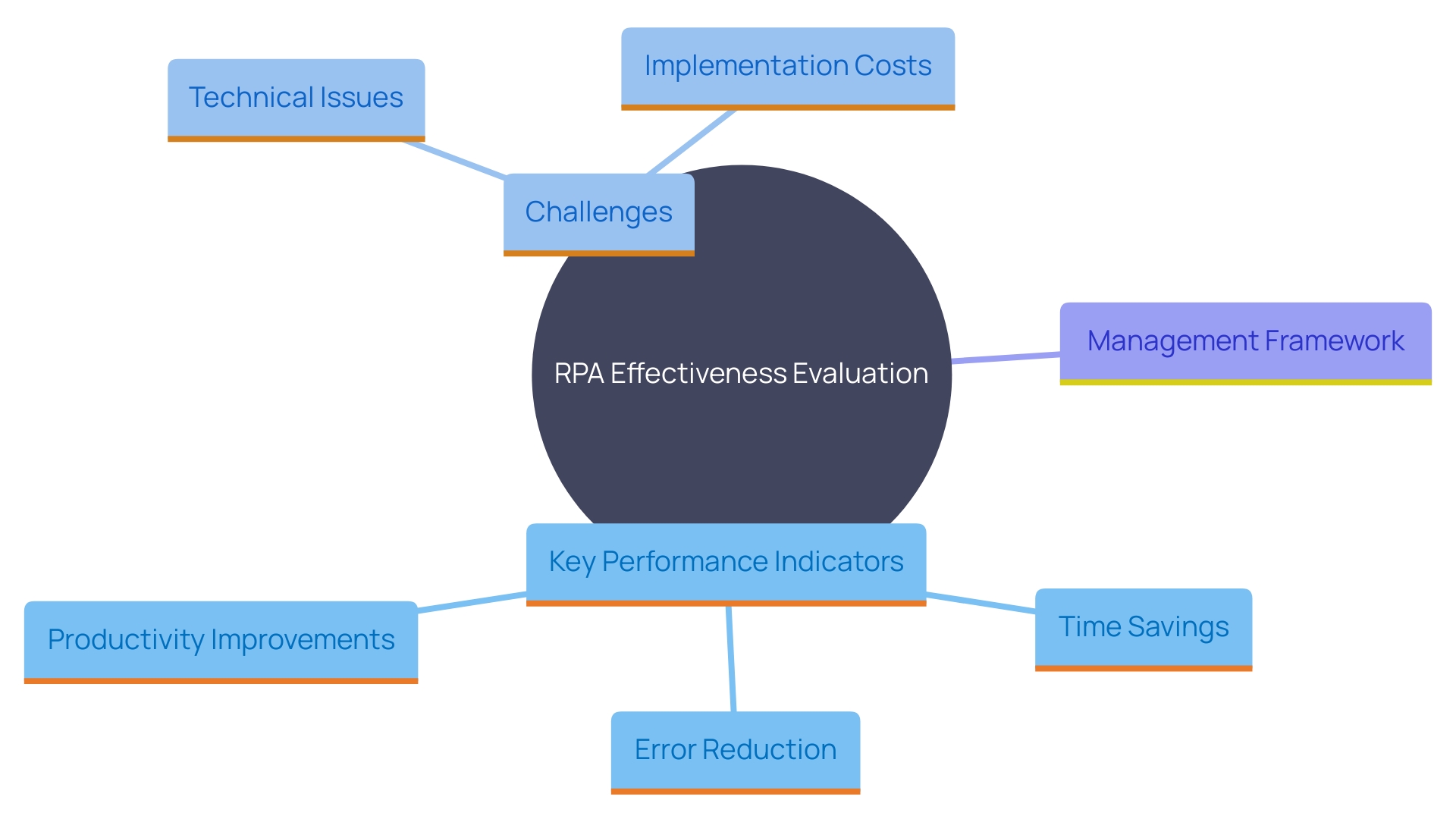
Conclusion
Robotic Process Automation (RPA) is transforming how organizations manage repetitive tasks, significantly enhancing operational efficiency and productivity. By automating processes without extensive coding, companies like St. James Winery and Mass General Brigham hospital system have reduced human errors and freed employees to focus on more strategic initiatives, fostering innovation.
Understanding RPA’s key components is essential for effective implementation. By utilizing user interface interactions and backend systems, organizations can streamline processes and save time. Success stories from Delivery Hero and Spordle highlight how RPA enhances productivity and customer satisfaction through routine task automation, with advanced technologies like AI further boosting effectiveness.
Implementing RPA requires a structured approach, from identifying tasks for automation to ongoing monitoring after deployment. Each phase, including workflow design and testing, necessitates careful planning to ensure optimal performance. Continuous oversight is crucial for adapting to changes and maintaining automation effectiveness.
Measuring success through key performance indicators (KPIs) and return on investment (ROI) ensures that RPA initiatives yield meaningful benefits, driving long-term improvements.
Adopting RPA addresses immediate operational challenges and positions organizations for sustainable growth in a competitive environment. By leveraging this transformative technology, businesses can enhance agility, reduce costs, and provide greater value to their customers.
Introduction
Artificial Intelligence (AI) is revolutionizing how organizations operate, offering unprecedented opportunities to enhance efficiency and productivity. However, transitioning from concept to full-scale implementation is fraught with challenges and risks. This article delves into the strategic importance of AI Proof of Concept (PoC) projects, illustrating their role in mitigating risks and providing scalable solutions.
It explores the critical steps in identifying the need for an AI PoC, highlights common challenges encountered, and shares real-life success stories of AI PoC implementations. Furthermore, it outlines best practices for building a robust AI PoC and discusses strategies for scaling these initiatives for full implementation. By understanding and leveraging these insights, organizations can unlock the potential of AI to drive significant improvements in their operations.
Benefits of AI PoC: Reducing Risks and Ensuring Scalability
Implementing an AI Proof of Concept (PoC) allows organizations to validate their AI initiatives on a small scale before committing significant resources. This method mitigates risks by providing insights into the feasibility and potential impact of the AI solution. For example, the engineering team of a company automated the extraction of key values from over 2,000 PDF documents, a task that was previously done manually and consumed significant time. The AI solution not only streamlined this process but also freed up employees to focus on more creative and meaningful work. This successful PoC demonstrated scalability as it was later applied to other business units for various purposes, showcasing how AI solutions can evolve and integrate seamlessly with existing systems. Additionally, leveraging a small-scale PoC helps in building the necessary skills within the team, which is essential for more complex AI projects. As AI initiatives grow, transitioning to more sophisticated skills becomes crucial, further enhancing operational efficiency and productivity.
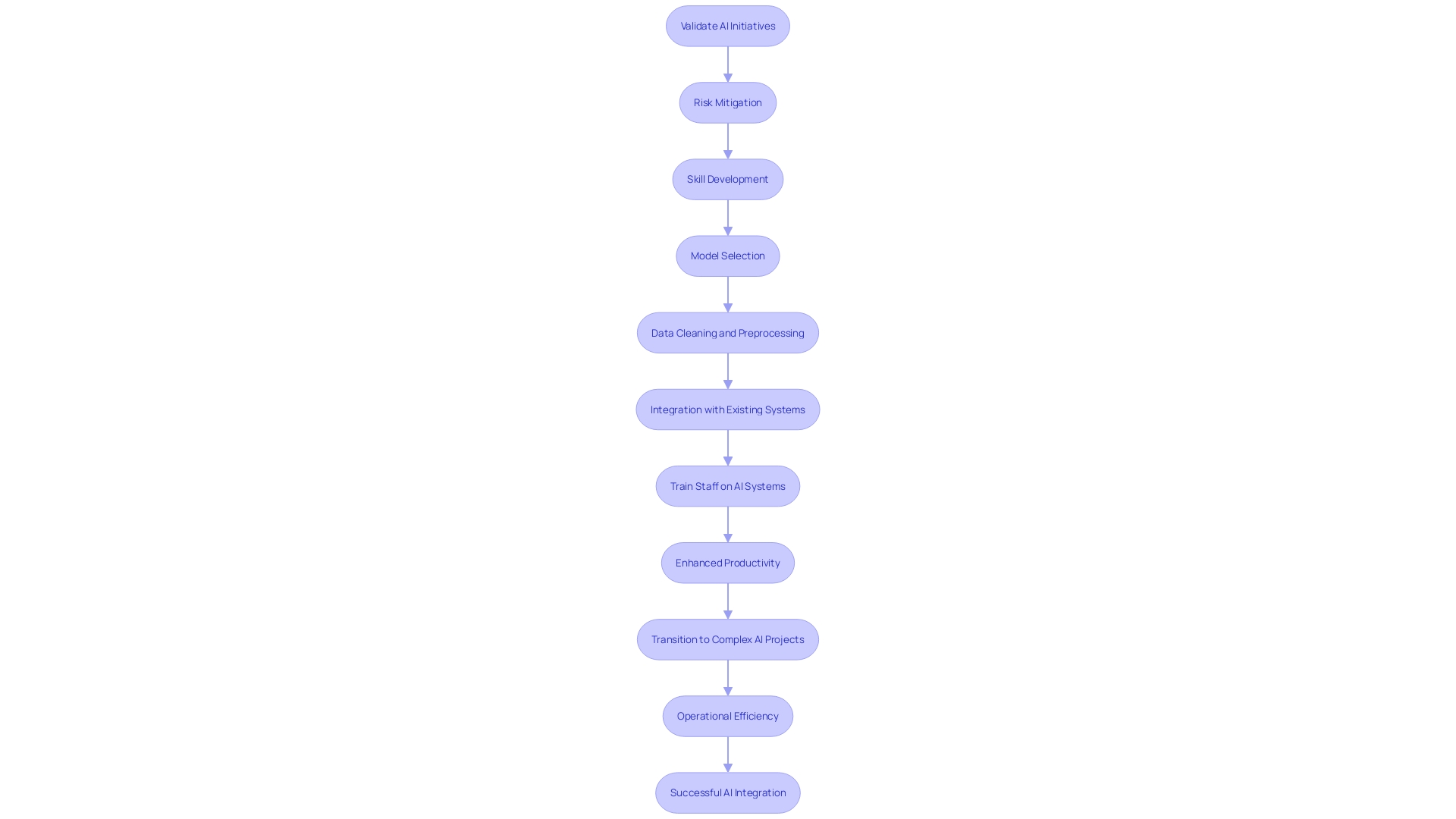
Identifying the Need for an AI PoC
Organizations aiming to implement AI Proof of Concepts (PoCs) must first conduct a thorough evaluation of their specific issues and strategic objectives. This involves a detailed analysis of existing processes to pinpoint inefficiencies and identify areas where AI can provide significant value. For instance, Microsoft’s AI Strategy Roadmap emphasizes the importance of understanding technology, business, and organizational perspectives to meet goals effectively.
Engaging stakeholders across various departments is crucial to this process, ensuring a comprehensive understanding of the operational landscape. This collaborative approach aligns the PoC with the overall strategic goals, increasing the likelihood of successful implementation. According to a survey conducted by Ipsos, the most predictive factor for AI success is clear communication between developers and business experts. This aids in expressing the business obstacles, desired outcomes, and success metrics accurately.
Additionally, addressing potential skill gaps is essential. Early AI initiatives often reveal bottlenecks, such as a disconnect between senior executives and employees or a lack of necessary training. Continuous learning and skill development, inspired by practices like DevOps, are vital. As AI initiatives grow more complex, acquiring or developing sophisticated skills becomes imperative.
For AI Pics, it’s also important to consider the ROI and potential challenges, as highlighted by OODA. High upfront costs and low initial returns can be deterrents. However, with a well-structured strategy, entities can mitigate these issues and steer towards positive outcomes. Evaluating the effectiveness of key interventions and maintaining robust, flexible strategies can help navigate the diverse pathways of AI development.
Ultimately, success with AI PoCs lies in a well-rounded approach that includes strategic planning, stakeholder engagement, continuous learning, and effective communication. By focusing on these areas, organizations can unlock sustainable value and drive significant improvements in operational efficiency.
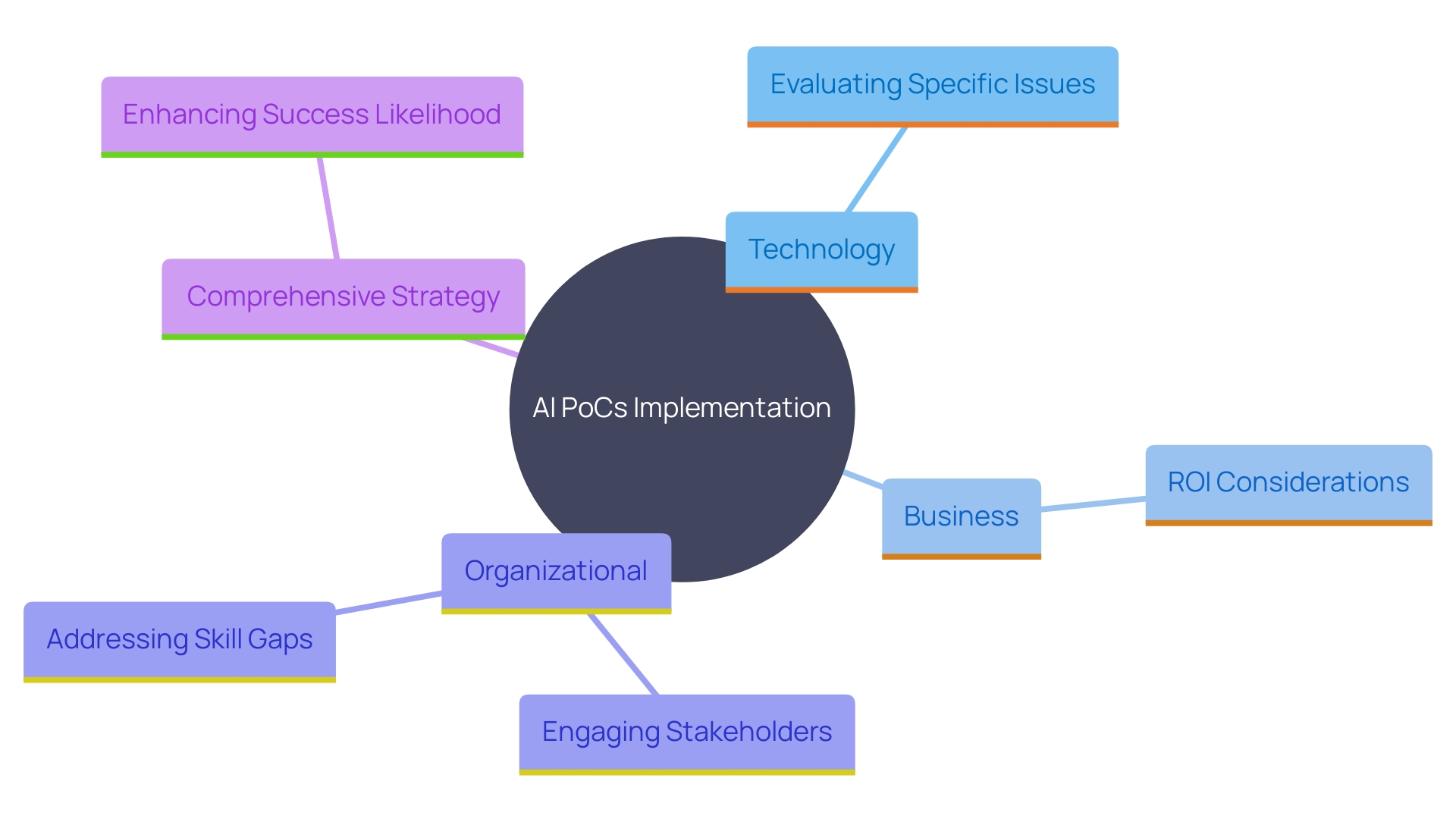
Common Challenges in AI PoC Projects
AI Proof of Concept (PoC) projects frequently encounter multiple obstacles, including data quality issues, lack of stakeholder buy-in, and integration complexities with existing systems. To overcome these challenges, it is crucial to establish clear communication channels among team members and stakeholders. Hosting knowledge-sharing meetings and workshops can facilitate these interactions, as demonstrated by the success of face-to-face and hybrid meetings, which ensured inclusivity for all team members, including clinicians with demanding schedules.
Moreover, comprehensive training is indispensable. For instance, the project team’s systematic method to product-specific training ensured that all users received the necessary guidance at the appropriate phase of deployment. This method not only enhanced user competence but also fostered a culture of innovation and collaboration. As highlighted by the University of Notre Dame Center for Research Computing, the adoption of data-centric and ethical methods is fundamental to building trust in AI systems, which is crucial for gaining stakeholder support.
Furthermore, addressing integration complexities requires a well-defined AI strategy that aligns with organizational structures and goals. This involves not just understanding the desired AI applications but also anticipating future data requirements and creating a dynamic data management approach. For instance, creating a structural ontology can offer a strong framework that evolves with the entity’s needs, ensuring continuity and adaptability in AI initiatives.
By leveraging these strategies—effective communication, thorough training, and strategic data management—organizations can navigate the challenges of AI PoC projects and pave the way for successful AI integration.
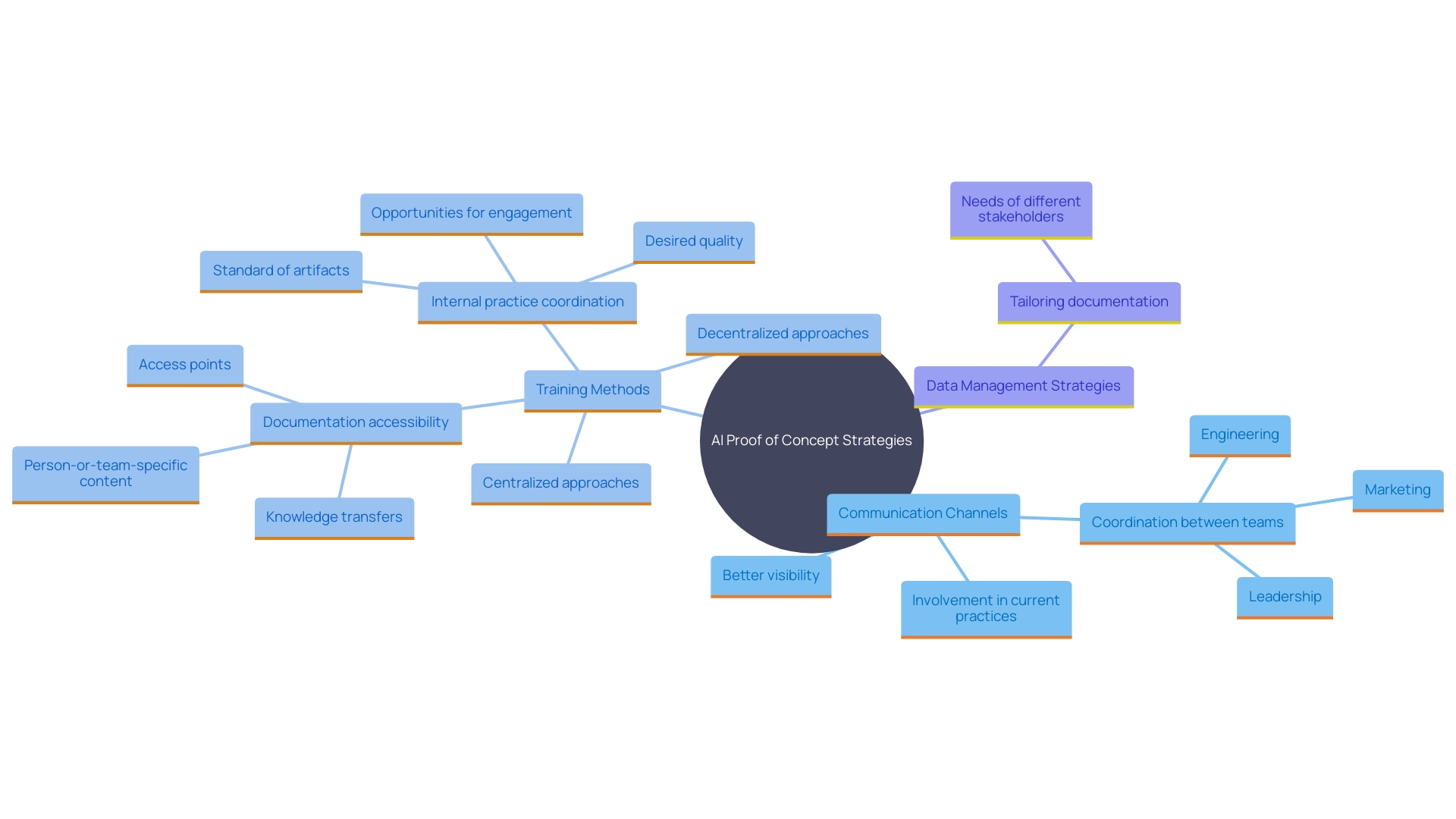
Success Stories: Real-Life Examples of AI PoC Implementation
Many entities have successfully implemented AI PoCs to drive significant improvements. For instance, a major retail brand utilized an AI PoC to optimize inventory management, resulting in a 20% reduction in excess stock. Similarly, Walles.Ai’s advanced fraud detection algorithms helped a leading financial institution significantly reduce fraudulent activities, protecting assets and enhancing customer trust. Additionally, a manufacturing company employed Walles.Ai’s smart manufacturing capabilities to monitor machine performance, identify bottlenecks, and streamline workflows, achieving notable increases in production efficiency and profitability. In healthcare, Walles.Ai’s predictive analytics enabled a healthcare organization to forecast patient admission rates, optimize resource allocation, and improve patient outcomes while reducing operational costs. These real-world success stories highlight the diverse applications and tangible benefits of AI solutions.
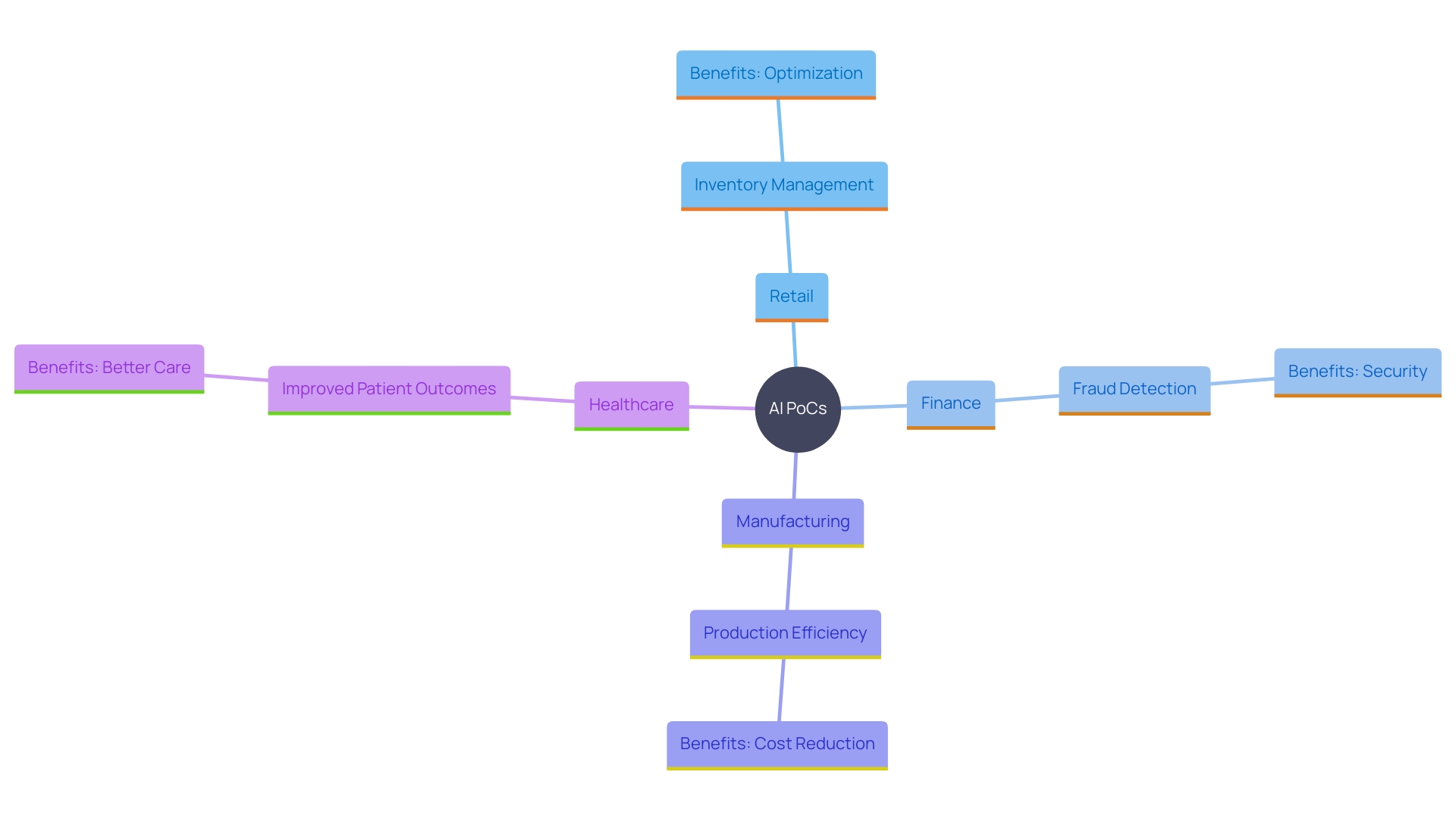
Best Practices for Building an AI PoC
Developing an effective AI Proof of Concept (PoC) requires a strategic approach that begins with clearly defined objectives and the right evaluation metrics. Setting these objectives guarantees that the PoC is in accordance with your overall business strategy and tackles the pertinent issues. Furthermore, data quality is paramount; the data used must be accurate, complete, and representative of the target audience or business objectives. This alignment makes it possible to draw meaningful insights and measure success effectively.
Collaboration with cross-functional teams plays a crucial role in enhancing the relevance and impact of the PoC. Subject matter experts (SMEs) bring essential knowledge for curating and preparing datasets that reflect specific challenges and scenarios. By providing SMEs with intuitive data annotation tools and efficient data management systems, entities can ensure that datasets are accurate and comprehensive, laying a solid foundation for AI/ML applications.
Additionally, adopting a repetitive method is vital. This method leverages principles from agile development, focusing on continuous learning and incremental improvements. The iterative process allows for ongoing refinement based on feedback and performance metrics, fostering continuous improvement. As Eric Boyd, Corporate Vice President of Azure AI Platform, notes, “The most successful organizations tend to have a mindset of experimentation and learning so they can see what’s working and systematically tackle any issues that arise.”
Incorporating structured, repeatable processes such as A/B testing can further enhance the PoC’s effectiveness. This approach compares different versions of AI models or user interfaces to determine which performs better, thereby optimizing outcomes. By focusing on iterative development and continuous learning, organizations can better anticipate and address potential barriers to implementation and success, ultimately driving more significant business value from AI initiatives.

Scaling AI PoC for Full Implementation
Achieving successful AI Proof of Concept (PoC) is only the beginning; scaling it for comprehensive implementation demands meticulous planning. Organizations must thoroughly evaluate their infrastructure needs, develop a detailed rollout strategy, and actively involve additional stakeholders to ensure alignment and support. For instance, the Customer Service Engine (CSE) case study demonstrated the critical role of engaging various departments to handle complex customer service cases effectively. By creating feedback loops between human agents and the AI system, the CSE could continuously learn and improve, achieving a 90% resolution rate within six weeks.
Ongoing observation and assessment throughout the scaling stage are essential to tackle unexpected issues and enhance return on investment. Real-time monitoring and activity logging, as outlined in recent AI visibility measures, are essential to maintain oversight and enhance transparency. This ensures the deployment remains adaptive and responsive to evolving needs.
Moreover, interdisciplinary approaches are crucial to maintain reliable and sustainable AI infrastructure, as emphasized in recent studies. Integrating insights from different fields helps tackle challenges and build robust systems capable of long-term success. According to the latest statistics, although 90% of surveyed companies are investing in AI, only 54% have solutions in production, highlighting the importance of thorough planning and stakeholder engagement to bridge the gap between experimentation and real-world application.
Incorporating expert insights, such as those from OODA’s international team, can further support strategic planning and risk management, ensuring AI initiatives are not only effectively scaled but also sustainable and aligned with organizational goals.
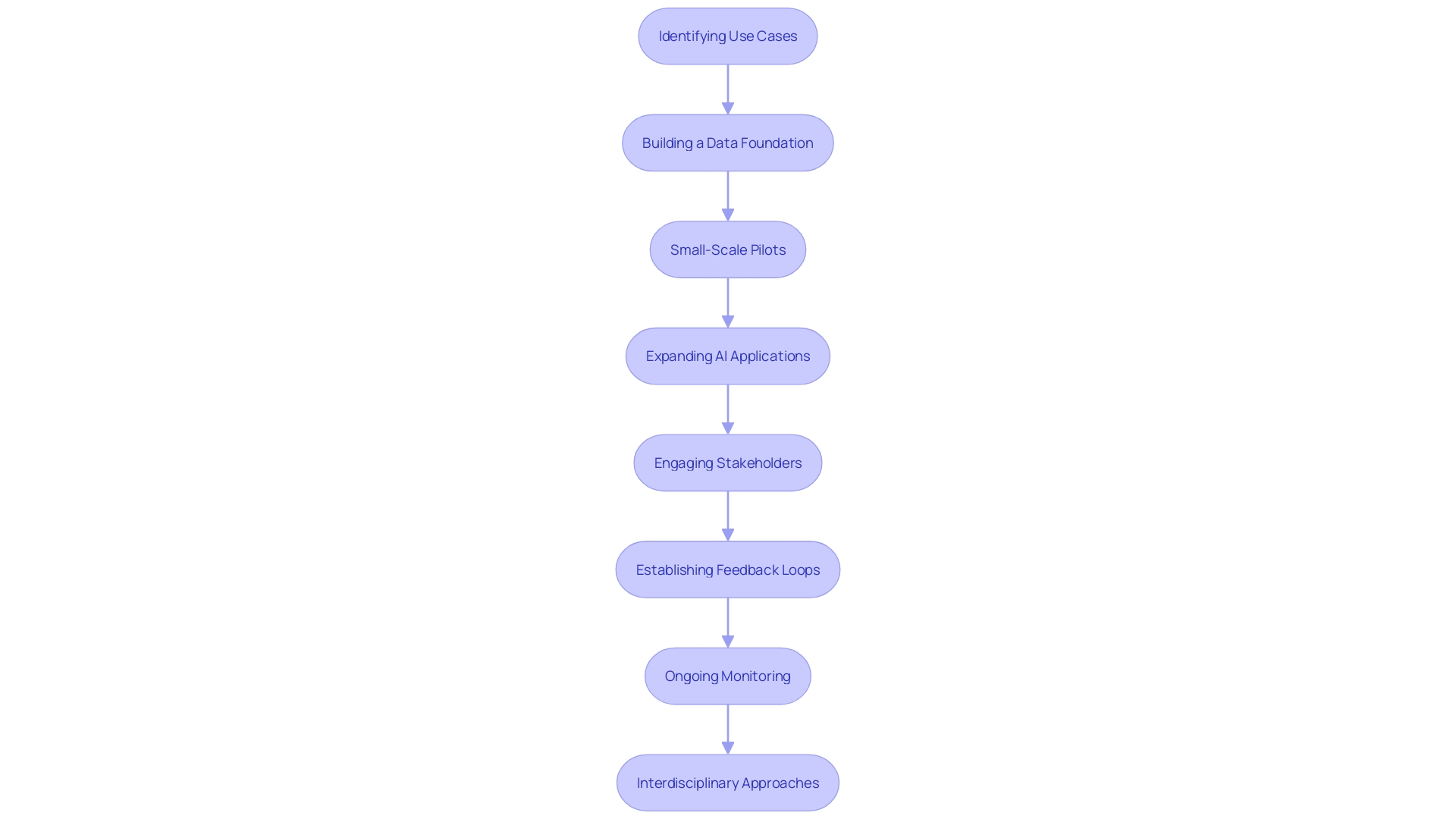
Conclusion
Implementing AI Proof of Concept (PoC) projects is a strategic way for organizations to validate AI initiatives while minimizing risks. These small-scale implementations allow for assessing feasibility and impact, as demonstrated by numerous success stories that showcase enhanced productivity and streamlined operations. Initial projects build team capabilities, preparing them for more complex AI applications that can drive long-term efficiency improvements.
Identifying the need for an AI PoC involves a thorough evaluation of existing processes and stakeholder engagement. Clear communication and collaboration across departments are essential for aligning PoC efforts with strategic objectives, while addressing skill gaps and fostering continuous learning are crucial for overcoming initial challenges.
To navigate common obstacles in AI PoC projects, organizations should focus on effective communication, comprehensive training, and strategic data management. Creating a collaborative environment and utilizing iterative development practices help tackle integration complexities and build trust in AI systems, ensuring successful and sustainable outcomes.
Scaling an AI PoC for full implementation requires meticulous planning and active stakeholder involvement. Continuous monitoring and evaluation, along with interdisciplinary insights, are vital for optimizing initiatives and ensuring alignment with organizational goals. By adopting a strategic approach to AI PoC projects, organizations can harness the transformative potential of AI, leading to significant operational improvements and sustainable competitive advantages.
Introduction
In today’s fast-paced business environment, the quest for operational efficiency is relentless, and Robotic Process Automation (RPA) has emerged as a powerful tool to meet this demand. By automating routine and repetitive tasks, RPA not only boosts productivity and accuracy but also offers significant cost savings and enhances overall business performance. Companies like St. James Winery have already reaped the benefits of automation, achieving higher production speeds and better margins.
This article explores the multifaceted advantages of RPA, from improved accuracy and enhanced customer experience to scalability and employee satisfaction. Discover how integrating RPA can transform operations, ensuring businesses stay competitive and responsive to market fluctuations while fostering a more engaging work environment for employees.
Increased Productivity
Robotic Process Automation (RPA) significantly enhances productivity by automating repetitive tasks, enabling workers to concentrate on more strategic initiatives. For instance, St. James Winery, a leading wine producer in the U.S., adopted mechanization due to increased growth and a lack of available labor, resulting in higher margins. RPA can handle large volumes of data efficiently and accurately, eliminating the need for overtime pay or temporary staff during peak seasons. The use of RPA not only boosts productivity but also improves accuracy by reducing human errors in tasks such as data entry and report generation. This substitution reduces costs and creates a positive productivity effect. Furthermore, workers who are motivated to move up in their careers and solve complex problems are more likely to see new technologies as beneficial. For example, the Omron TM Series Collaborative Robot showcases how human-robot collaboration can revolutionize production lines, enhancing flexibility and efficiency. By automating routine tasks, RPA empowers employees to drive higher output within the organization.
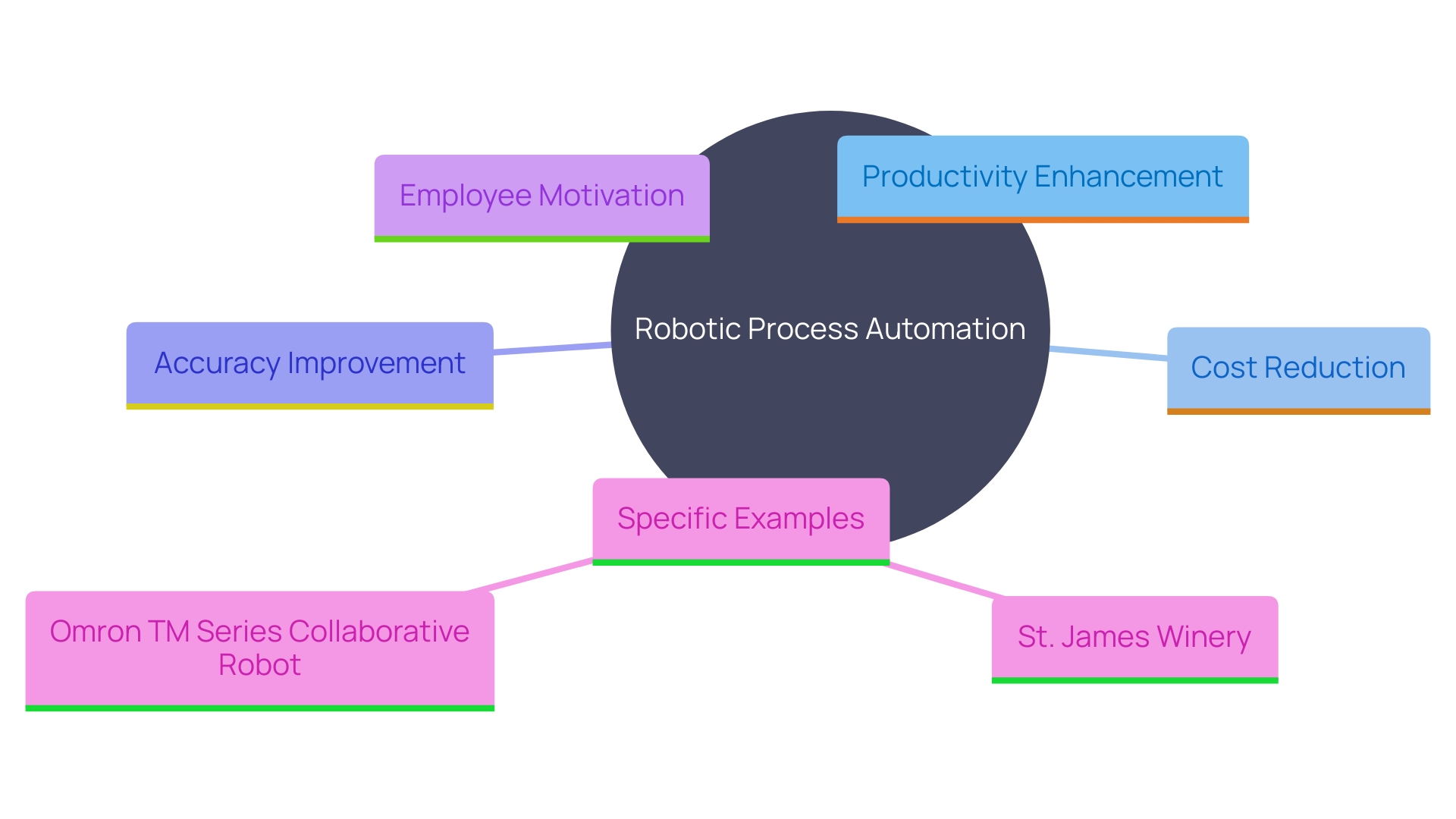
Cost Savings
Implementing RPA can lead to significant cost savings by reducing reliance on manual labor and minimizing errors. For instance, St. James Winery in Missouri, a prominent wine manufacturer, has attained increased production rates and improved profit margins through mechanization. They measure ROI in terms of labor per case and have already seen substantial benefits. As companies allocate resources more efficiently, they can enhance profitability and stay competitive in the market. The global robot operating systems market is anticipated to reach $1.8 billion by 2032, growing at a CAGR of 12.9%. This surge reflects the growing adoption of mechanization technologies across various industries. Moreover, embracing Robots-as-a-Service (RaaS) agreements can provide adaptable, economical solutions for processes, where organizations only pay for what they use, including deployment, integration, and maintenance expenses. This model allows companies to optimize operational efficiency without the burden of significant capital investments.
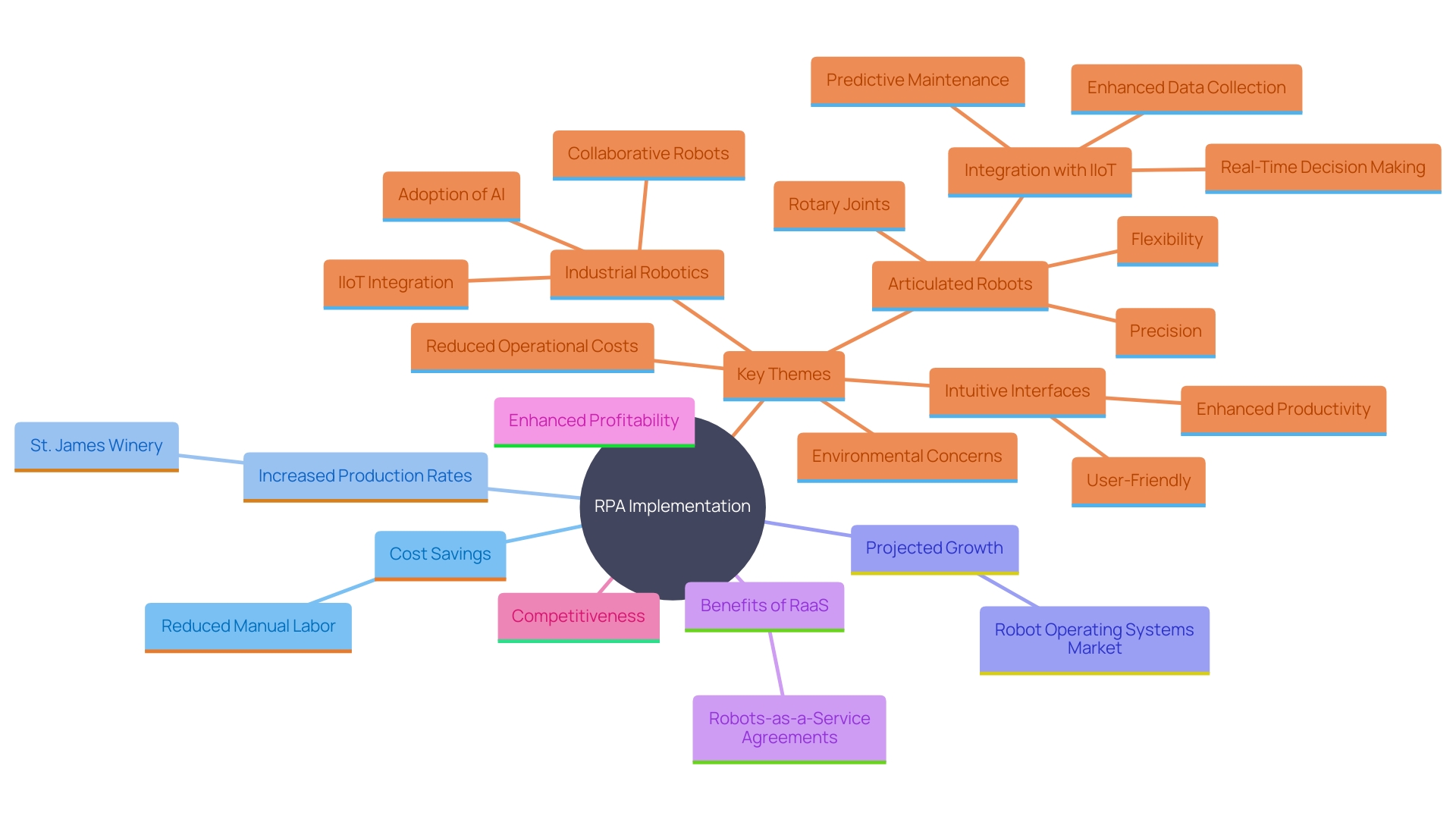
Improved Accuracy and Quality
Robotic Process Automation (RPA) enhances task accuracy, significantly reducing human error. For instance, St. James Winery implemented automation to address labor shortages and increased production demands. As a result, they achieved higher production speeds and better margins, demonstrating the reliability and effectiveness of RPA. Consistent quality in processes not only boosts product and service reliability but also supports overarching organizational goals such as cost reduction, efficiency improvement, and competitive advantage. By 2026, the Industrial Automation Services Market is expected to grow to $264.69 billion, emphasizing the strategic importance of adopting these technologies.
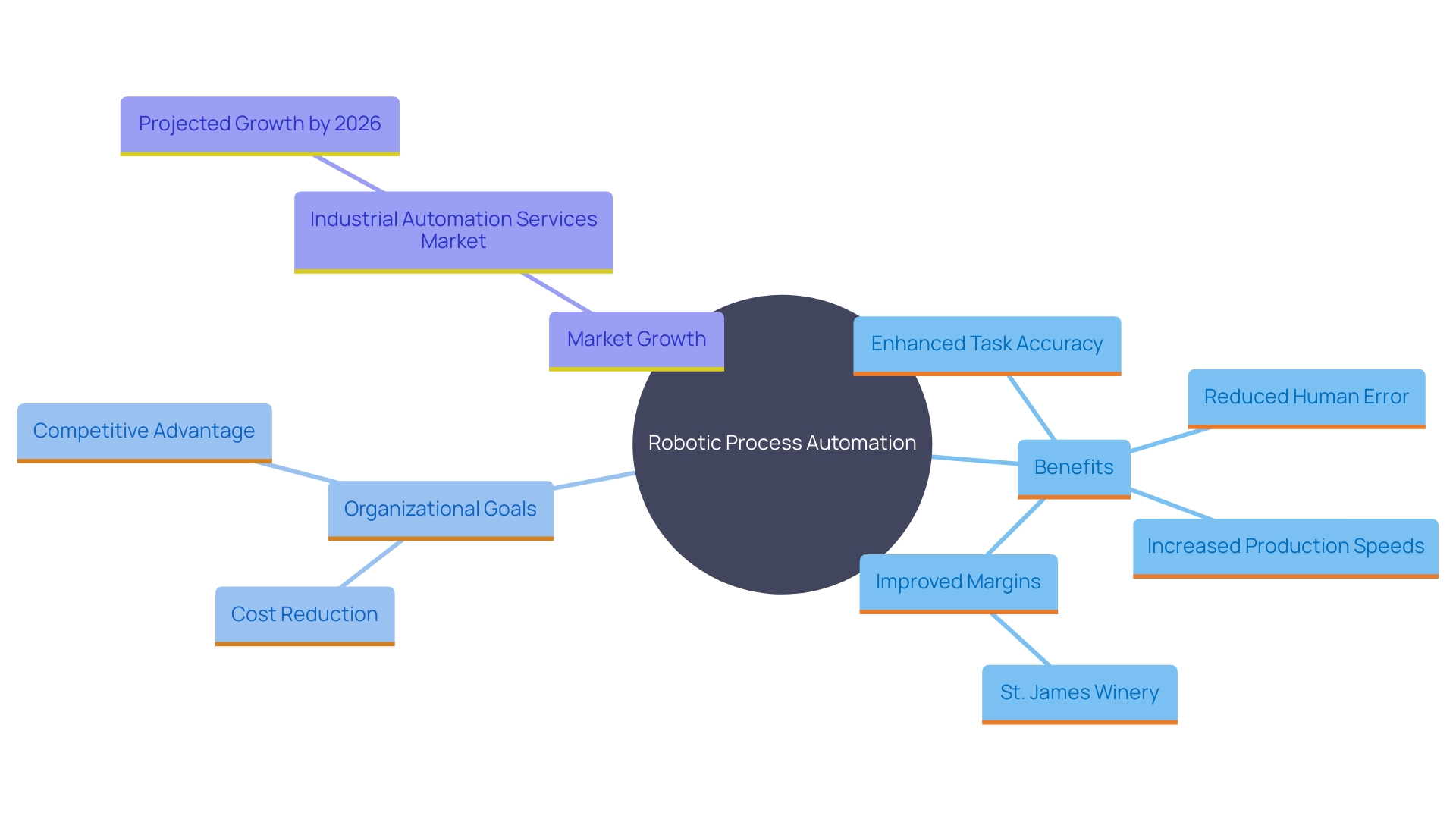
Enhanced Customer Experience
By utilizing Robotic Process Automation (RPA) to handle routine tasks, organizations can significantly enhance their responsiveness to customer inquiries. This not only accelerates response times but also improves the accuracy of the information provided. Such efficiency is crucial, given that 88% of customers value excellent service as much as a company’s products or services, according to Salesforce’s State of the Connected Customer report. Furthermore, RPA’s ability to operate 24/7 without errors ensures that customer interactions are consistent and reliable, which is vital for maintaining high customer satisfaction and loyalty. Businesses such as St. James Winery have experienced directly the advantages of mechanization, attaining increased production rates and improved margins by incorporating RPA into their processes. This demonstrates that investing in technology not only meets current demands but also positions enterprises for future growth and efficiency.
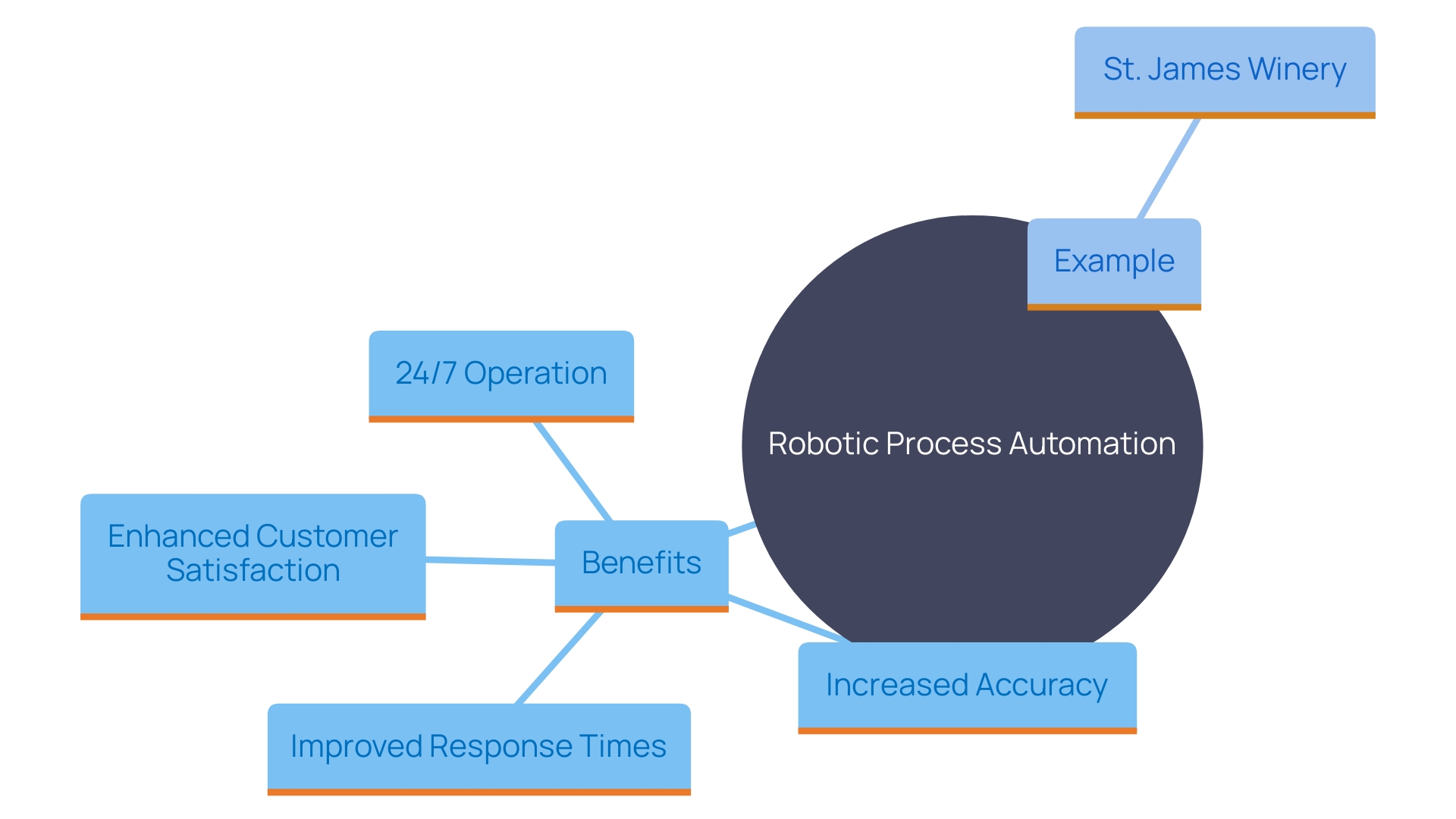
Scalability and Flexibility
Robotic Process Automation (RPA) solutions offer unparalleled scalability, enabling organizations to swiftly adapt their automation processes to meet varying demands. This adaptability is crucial for supporting organizational growth and responding to market fluctuations. For instance, the finance department at Mass General Brigham hospital in Boston faced significant inefficiencies in tracking healthcare providers. By implementing RPA, they automated data collection and organization, which streamlined their workflow and highlighted actionable insights for the team. Such flexibility not only enhances efficiency but also ensures that businesses remain competitive amidst economic challenges and shifting market conditions.
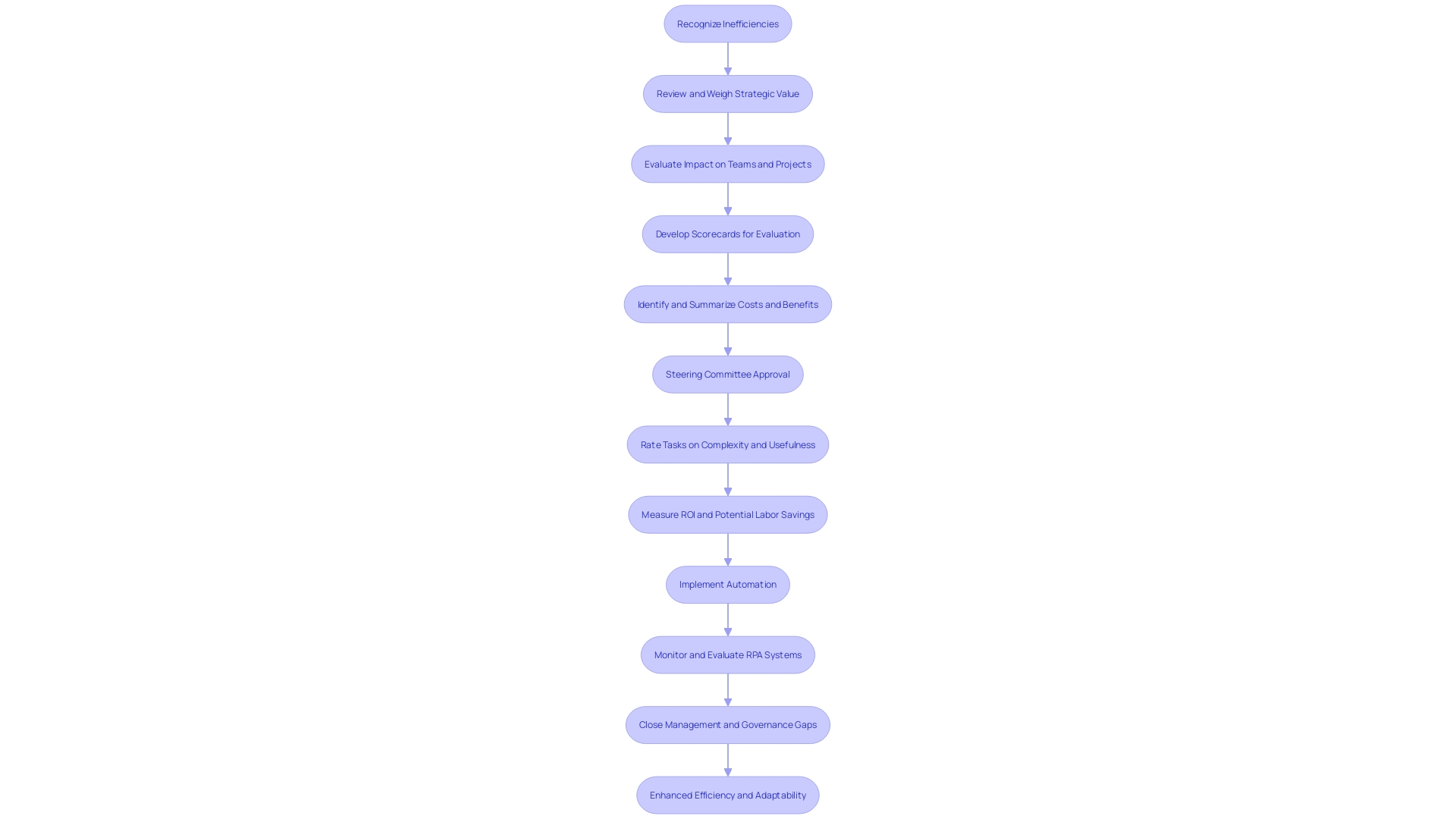
Employee Satisfaction and Engagement
By liberating staff from tedious duties, Robotic Process Automation (RPA) promotes a more stimulating work atmosphere. This shift allows staff to concentrate on innovative and significant tasks, greatly improving their job satisfaction and retention. For instance, Delivery Hero, a global delivery platform with over 53,000 staff members, faced the challenge of workers getting locked out of their accounts. Each recovery process took an average of 35 minutes, leading to significant downtime. By implementing RPA, Delivery Hero’s IT service delivery team, led by Dennis Zahrt, removed this bottleneck, allowing staff to remain productive and engaged.
Moreover, a global report by Quinyx highlights that 60% of shipping and distribution employees believe that future technologies will improve job quality, allowing them to complete tasks more efficiently. This sentiment is echoed by Llinos Roberts, product lead at Stena Line, who emphasizes the company’s commitment to leveraging technology to enhance job satisfaction. In contrast, concerns about job displacement due to mechanization persist, as highlighted by studies indicating that frequent interaction with advanced technologies like AI and robotics can negatively impact workers’ mental health and job satisfaction.
However, the positive impact of RPA on job satisfaction is clear. Employees who work on complex problems and feel valued by their employers are more likely to view new technologies favorably. In the United States, for instance, mechanization has been found to reduce workplace injuries by about 16%, and in Germany, it lowers the physical intensity of work by 4% and the risk of disability by 5%. These improvements contribute to a healthier and more satisfying work environment, ultimately benefiting both employees and the organization.
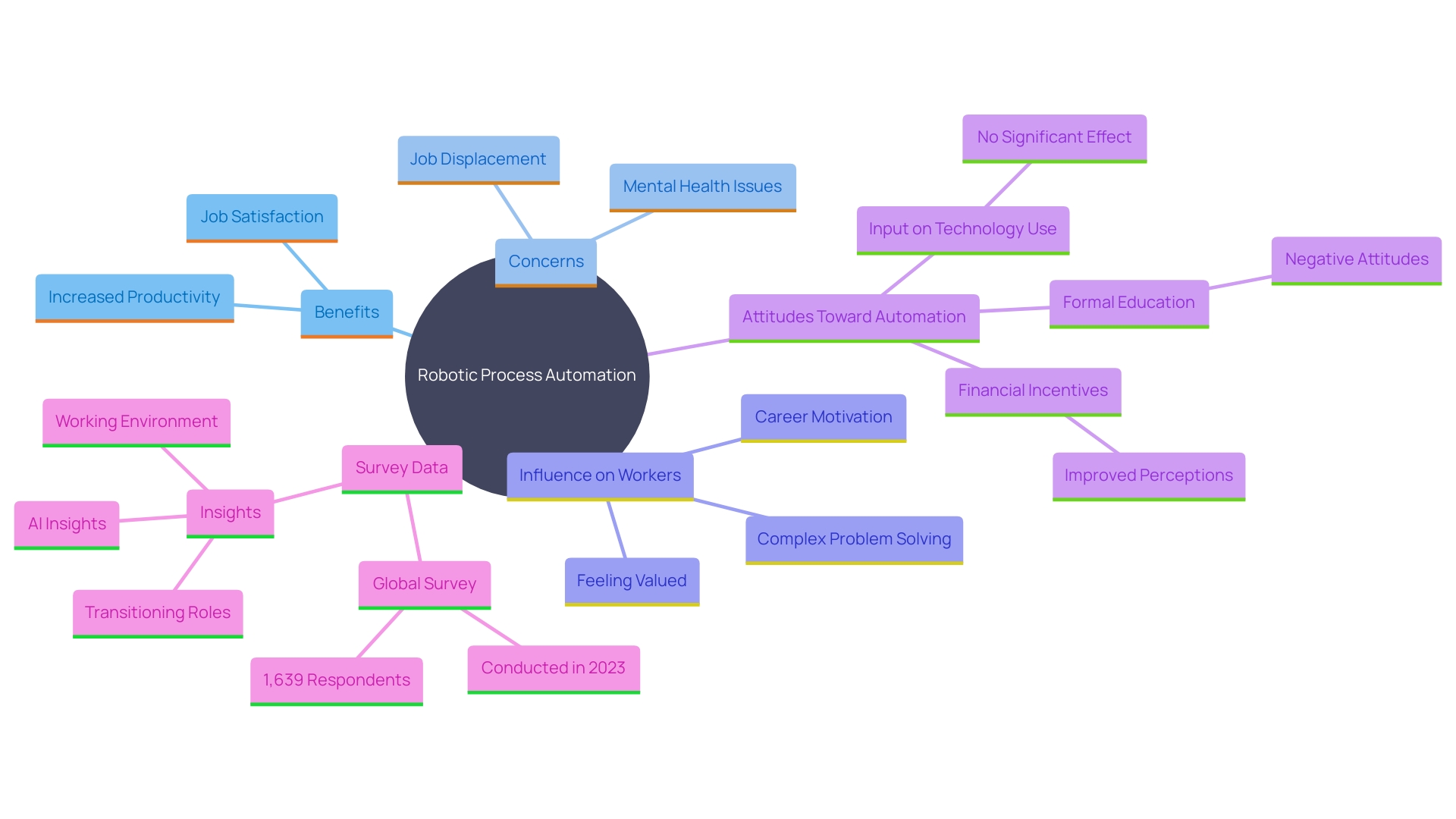
Faster Return on Investment (ROI)
Implementing RPA often leads to swift ROI, as enterprises promptly enjoy the monetary advantages of mechanization. For instance, companies like St. James have achieved higher production speeds and better margins, measuring ROI in terms of labor per case. By incorporating additional mechanization, St. James is poised to further enhance production efficiency and stay competitive in the face of rising demands. As per a Forrester study, 24% of companies faced a 16% to 20% decrease in time to market for new products because of mechanization, while 27% observed enhancements between 11% and 15%. These enhancements not only boost agility but also increase market competitiveness. As Jeff Burnstein, president of A3, noted, the drive for operational efficiency continues to fuel demand for robotics, even amidst economic challenges. This trend highlights the essential function of mechanization in sustaining global competitiveness and enhancing operational processes.
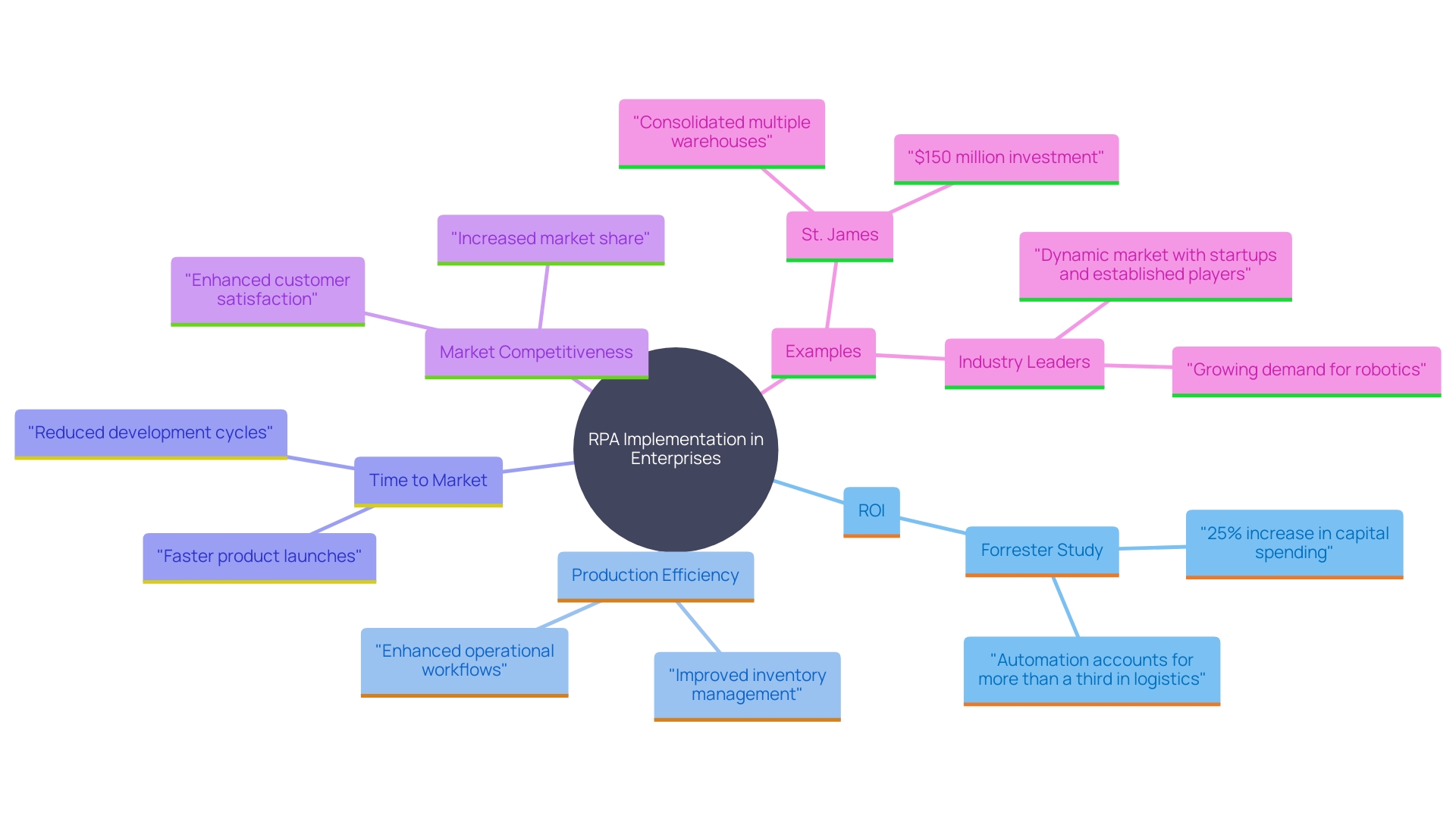
Better Compliance and Regulatory Adherence
Robotic Process Automation (RPA) helps organizations achieve stringent compliance standards by automating processes to ensure consistent and correct execution. This automation also generates detailed audit trails, simplifying regulatory adherence. For instance, M&T Bank, a longstanding and prominent U.S. commercial bank, leverages RPA to maintain compliance with the highest security standards and regulatory requirements, protecting sensitive data and transactions. In another example, Ryanair has standardized its Disaster Recovery process using RPA, eliminating human error and ensuring swift compliance with regulations like the Sarbanes-Oxley Act. By automating such essential processes, organizations can avoid expensive compliance problems and concentrate on their primary operations.
Improved Analytics and Decision-Making
Robotic Process Automation (RPA) enhances data collection and analysis, allowing businesses to make data-driven decisions with greater precision. By automating repetitive tasks, RPA enables the collection of vast amounts of data quickly and accurately. This data can be transformed into actionable insights, leading to more informed decision-making processes. For instance, ABB’s implementation of YuMi® cobots in Electrolux Group’s refrigerator production line significantly improved gas leak detection accuracy and enhanced worker safety by automating 100% of the detection operations. Consequently, employees were redeployed to more valuable roles, showcasing how automation can optimize both productivity and safety. Additionally, leveraging RPA can result in substantial cost savings and efficiency gains. Companies utilizing Dataiku reported an 80% reduction in time spent on manual processes and a three-year ROI of 413%, emphasizing the financial advantages of incorporating RPA into operational activities. As financial institutions harness data analytics for risk management and strategic planning, the ability to transform raw data into actionable insights becomes indispensable for maintaining a competitive edge in today’s data-driven environment.
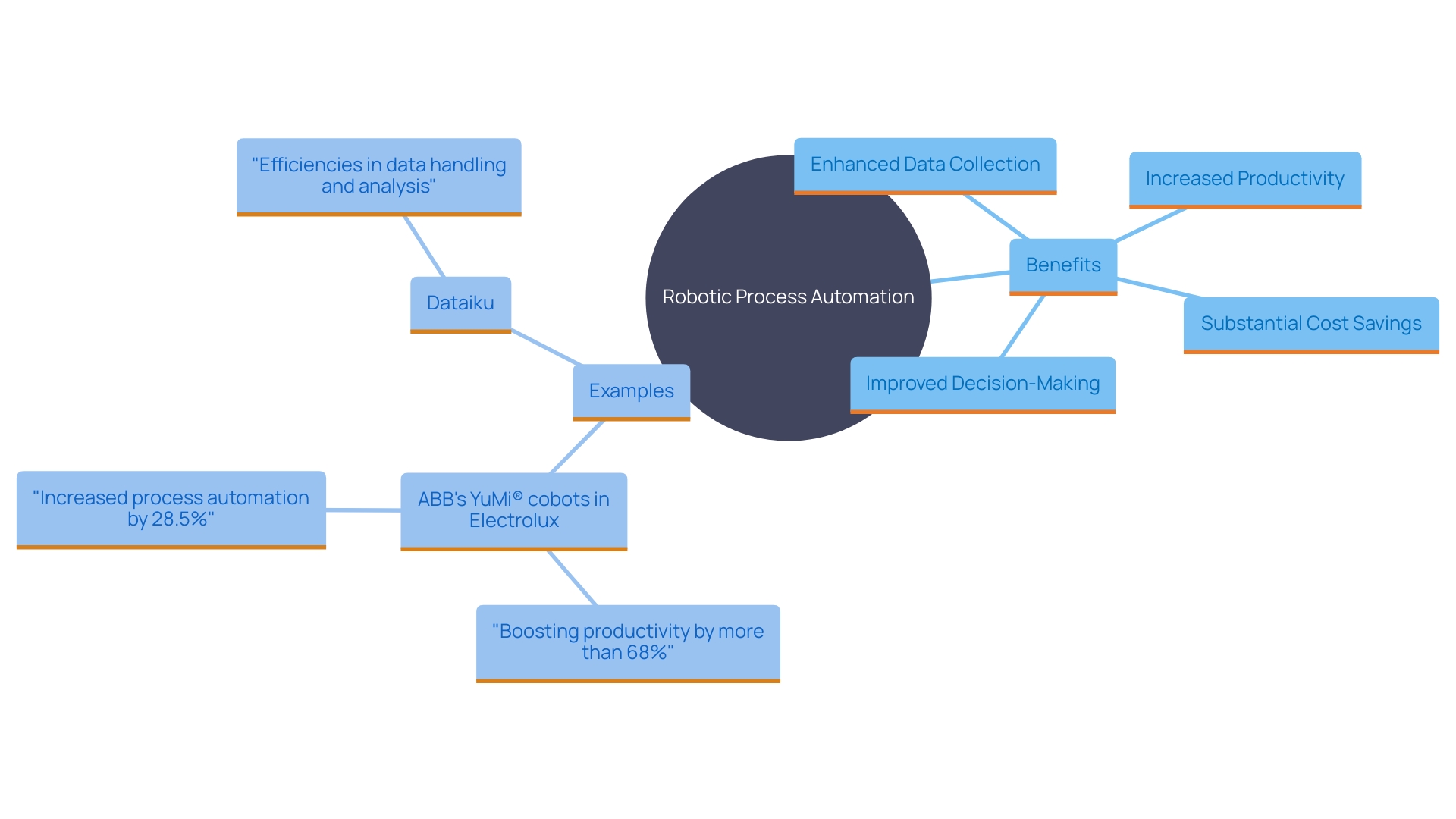
Competitive Advantage
By adopting RPA, businesses can gain a significant competitive edge. Enhanced efficiency and productivity not only allow organizations to innovate faster but also respond more effectively to market demands. For instance, St. James Winery has experienced significant enhancements in production speeds and profit margins by incorporating mechanization, measuring ROI in terms of labor per case. Looking ahead, they plan to expand their automation efforts to keep up with increasing demands.
Moreover, a study from SS&C Blue Prism and Forrester Consulting highlighted that Intelligent Automation (IA) technologies have transitioned from operational to highly strategic tools. Over three years, the composite organization interviewed saw gains in productivity, compliance cost avoidance, and employee experience, yielding an impressive net present value of $53.4 million per customer.
These real-world examples underscore the transformative potential of RPA, as it drives economic growth and fosters a more sustainable future. As businesses continue to embrace these technologies, the flexibility, scalability, and efficiency offered by mobile robots further enhance operational capabilities across various industries.
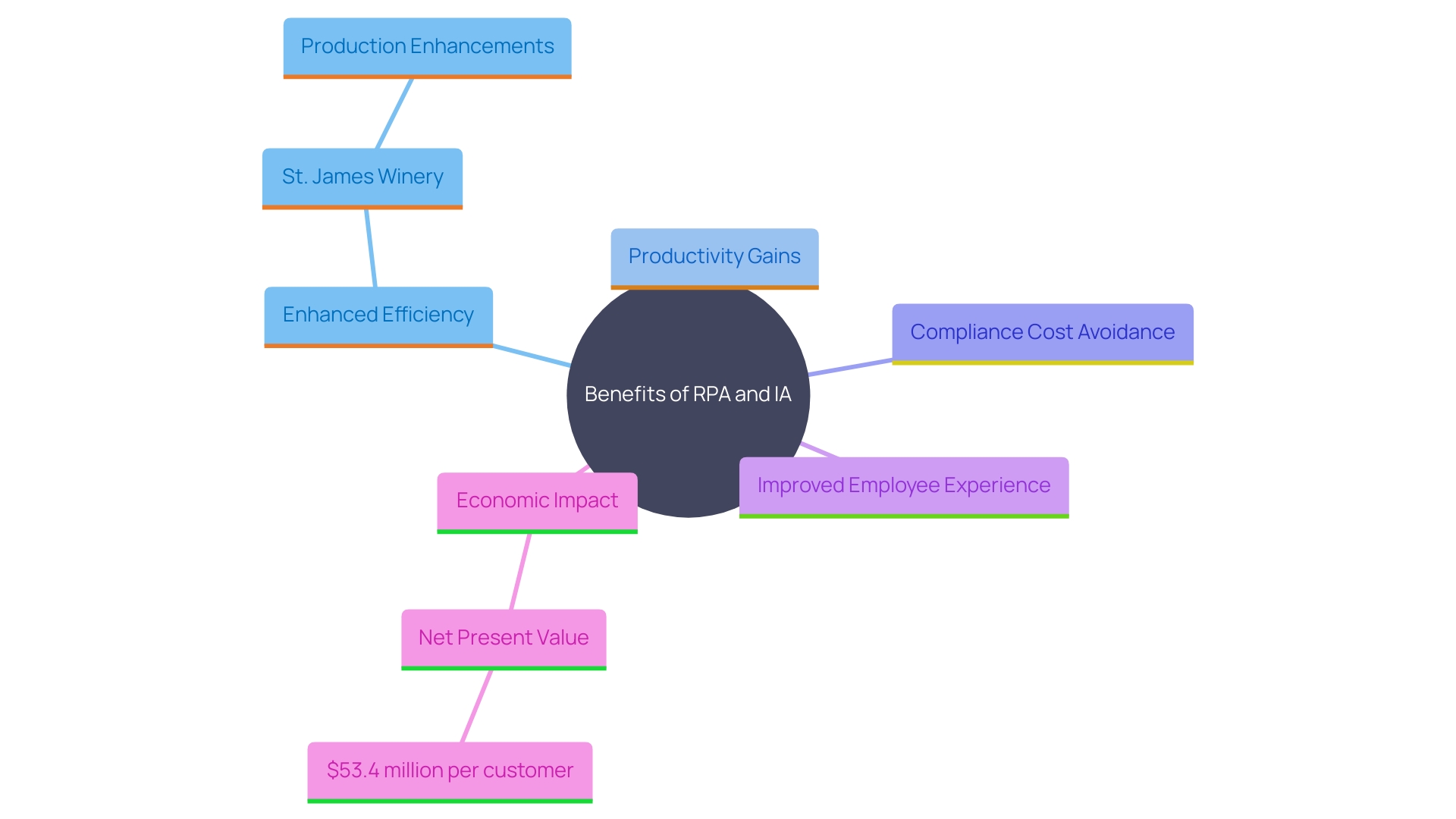
Conclusion
The integration of Robotic Process Automation (RPA) within organizations presents a multitude of advantages that can significantly enhance operational efficiency. By automating repetitive tasks, RPA not only increases productivity but also reduces human error, leading to improved accuracy and quality in processes. Companies like St. James Winery exemplify the transformative effects of RPA, achieving higher production speeds and better margins while allowing employees to focus on strategic initiatives rather than mundane tasks.
Cost savings emerge as a critical benefit, with RPA minimizing reliance on manual labor and enabling businesses to allocate resources more effectively. The adoption of flexible payment models, such as Robots-as-a-Service (RaaS), further enhances the financial viability of automation. As organizations streamline their operations and improve customer experience through faster and more accurate responses, they position themselves for sustained growth and competitiveness in the market.
Moreover, RPA fosters a more engaged workforce by freeing employees from repetitive tasks, allowing them to concentrate on creative and meaningful work. This not only enhances job satisfaction but also contributes to employee retention. With rapid ROI and improved compliance through standardized processes, RPA empowers organizations to make data-driven decisions, ultimately leading to a competitive advantage.
As businesses continue to navigate the complexities of today’s economic landscape, embracing RPA is not just a strategic necessity but a pathway to innovation and operational excellence. The future belongs to those who leverage automation to enhance efficiency, responsiveness, and overall performance, ensuring they remain at the forefront of their industries.
Introduction
In today’s rapidly evolving business landscape, the quest for operational efficiency and enhanced productivity is more critical than ever. Automated workflows stand at the forefront of this transformation, offering a powerful solution to streamline repetitive tasks, reduce errors, and enhance overall accuracy. By leveraging intelligent automation tools, companies can significantly boost productivity, achieve substantial cost savings, and improve employee satisfaction.
Real-world examples, such as the success stories of Delivery Hero and St. James Winery, illustrate the tangible benefits of automation, from faster turnaround times to improved resource management. As industries continue to embrace automation, the strategic importance of these technologies becomes increasingly evident, promising a future of optimized processes, better decision-making, and heightened agility. This article delves into the multifaceted advantages of automated workflows, providing valuable insights into how businesses can harness these innovations to drive efficiency and growth.
Enhanced Efficiency
Automated workflows significantly enhance operational efficiency by streamlining repetitive tasks, thus allowing employees to concentrate on high-value activities. For instance, companies are deploying tools like dashboards, inventory trackers, and alert systems to help human managers oversee processes more effectively. According to a study by SS&C Blue Prism, intelligent processes have led to remarkable gains in productivity, compliance cost avoidance, and employee satisfaction, yielding a net present value of $53.4 million per customer over three years. A real-world example is Delivery Hero, where technology decreased the average account recovery time from 35 minutes, helping 53,000 employees regain access quickly and reduce downtime. Furthermore, the beneficial influence of mechanization on work safety and employee health is clear, with research indicating a 16% decrease in workplace injuries in the U.S. and better health results for low-skilled workers. The industrial automation market is anticipated to expand from $147.06 billion in 2019 to $264.69 billion by 2026, reflecting the growing strategic significance of automation in contemporary operational practices.
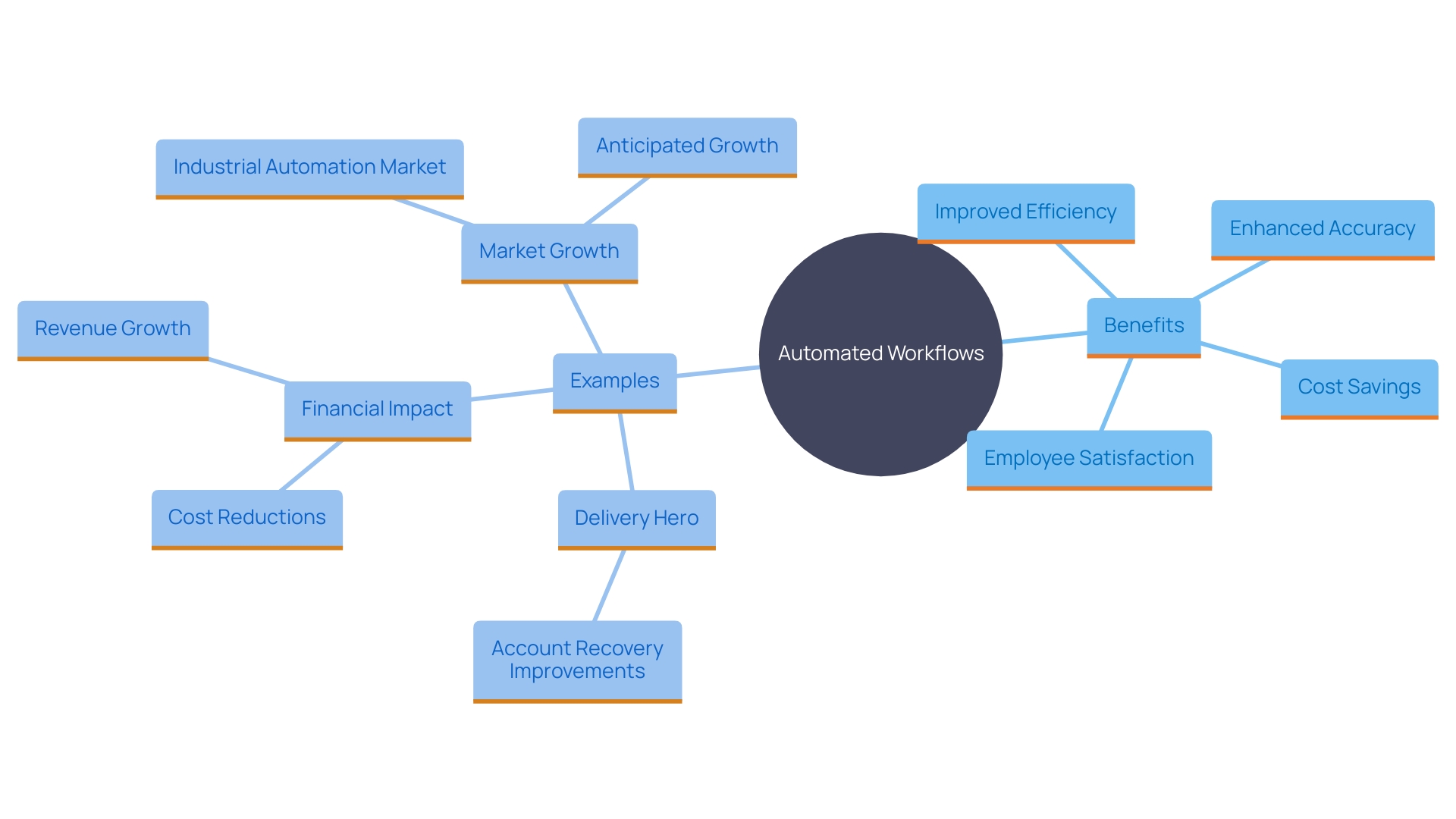
Increased Productivity and Savings
Automating workflows can lead to substantial cost savings for businesses. By reducing the time employees spend on repetitive tasks, companies can reallocate their workforce to more strategic activities that drive revenue and growth. For instance, St. James Winery, a prominent wine producer in the U.S., resorted to mechanization due to increased growth and a lack of available labor. This action not only enhanced their production rates but also led to improved margins, showcasing the concrete advantages of streamlining workflows.
A study by SS&C Blue Prism found that intelligent mechanization technologies can significantly enhance productivity and employee experience, leading to an overall net present value of $53.4 million per customer over three years. Sales professionals, for example, have reported saving over two hours daily by automating tasks such as scheduling meetings and data entry, allowing them to focus more on connecting with customers and closing deals.
The advantages of workflow mechanization are also clear in the wider adoption trends. Over 80% of corporate leaders are hastening the implementation of work process technologies, acknowledging its ability to enhance productivity and lower operating expenses. In fact, companies that successfully implement workflow automation often enjoy a good return on investment by increasing service levels to end-users and minimizing operational losses.
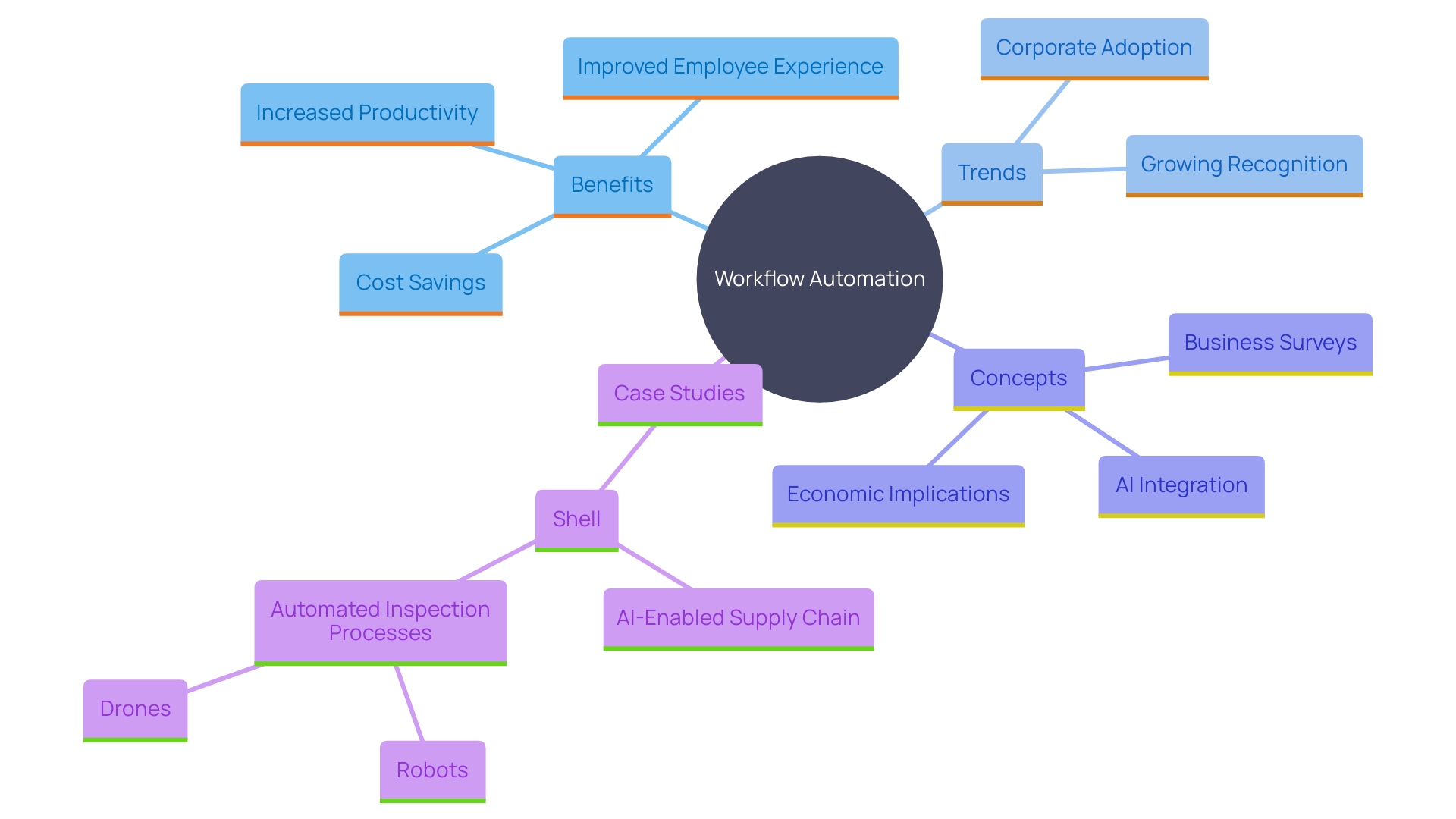
Reduced Errors and Improved Accuracy
Automation significantly reduces human error, ensuring tasks are completed with higher precision. This improvement in accuracy enhances the quality of work and minimizes the risk of costly mistakes that can disrupt business operations. For instance, Ryanair has effectively employed technology in its Disaster Recovery (DR) processes, standardizing procedures to eliminate human error. Furthermore, their auto-remediation strategies, such as automatic web server restarts, emphasize the reliability and efficiency that mechanization provides to critical operations.
Based on a study conducted by Duke University’s Fuqua School of Business, 60% of firms intend to implement mechanization technologies in the upcoming year to improve job performance. The advantages are evident: automating processes not only saves time and decreases expenses but also enhances job satisfaction by enabling employees to concentrate on more strategic activities. Moreover, mechanization guarantees adherence to industry regulations, a vital element for fields such as finance and healthcare.
As Annette Reuther, Head of Growth (Europe), noted, mechanization helps teams manage complex tasks across multiple markets efficiently, from marketing to customer support, thus magnifying their impact. The increasing use of AI technologies in streamlining processes highlights the substantial efficiency improvements organizations can realize. Bank of America analysts predict that AI could boost S&P 500 operating margins by 200 basis points over the next five years, revolutionizing corporate efficiency. These advancements in mechanization technology underscore its transformative potential in improving operational accuracy and overall business performance.
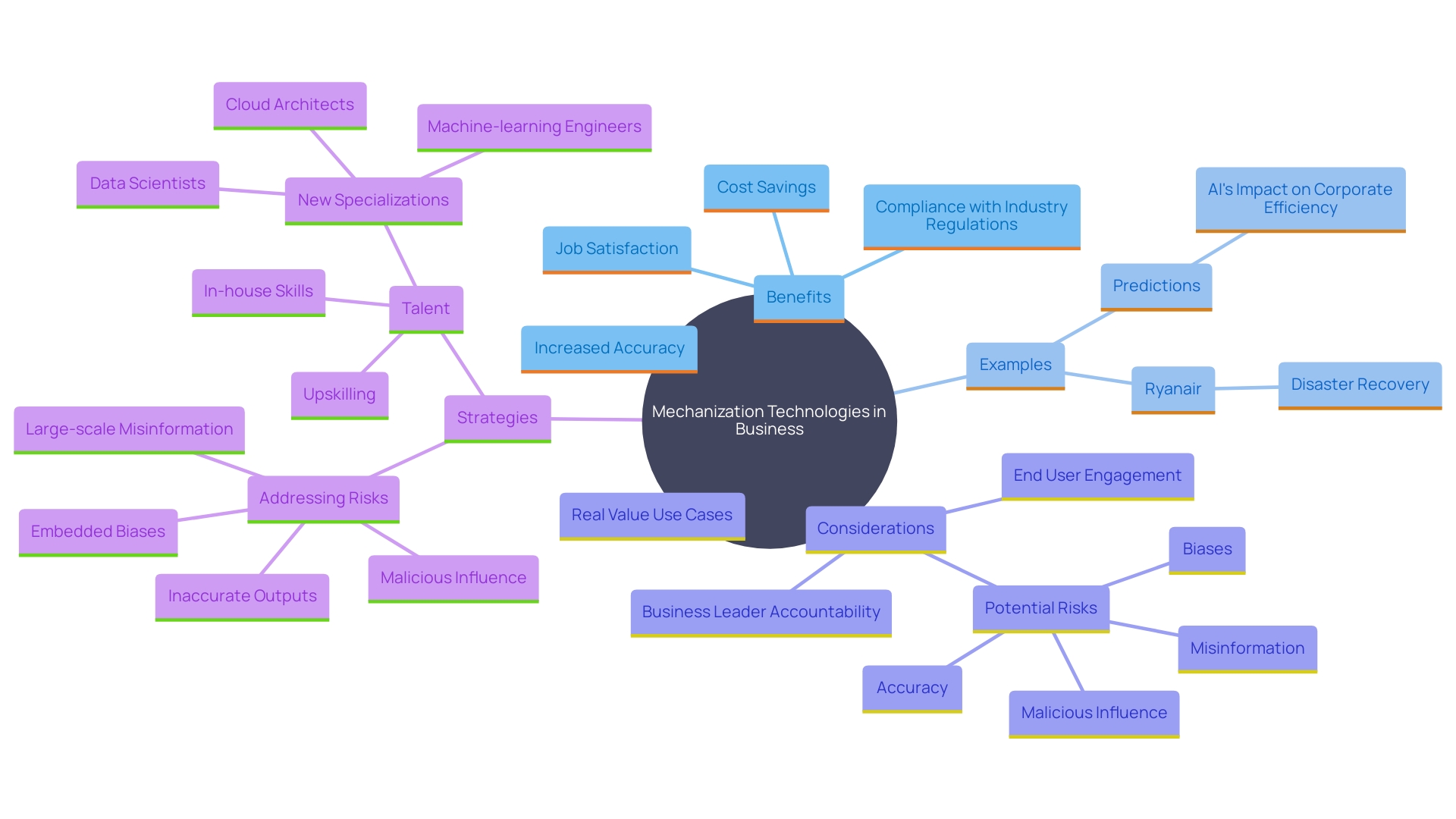
Improved Transparency and Visibility
Automated workflows provide real-time insights into operations, enhancing tracking and monitoring capabilities. This level of transparency is crucial for identifying bottlenecks and inefficiencies, which allows for timely interventions. For instance, Rivian, a global automotive manufacturer, relies on automated workflows to coordinate its dispersed teams across multiple states, from design in California to manufacturing in Illinois. This setup ensures that specialized talent can collaborate seamlessly. Likewise, Ryanair has streamlined its disaster recovery system through systemization, minimizing human error and enhancing response efficiency. In the healthcare sector, a Texas health system implemented a next-generation wireless system to automate non-value-added activities, thereby optimizing staff resources and enhancing patient care. As stated in a McKinsey report, the implementation of automation and AI in organizations is on the increase, with 80% of firms speeding up task automation. This shift not only saves time and money but also improves accuracy and job satisfaction, as seen in various sectors leveraging these technologies effectively.
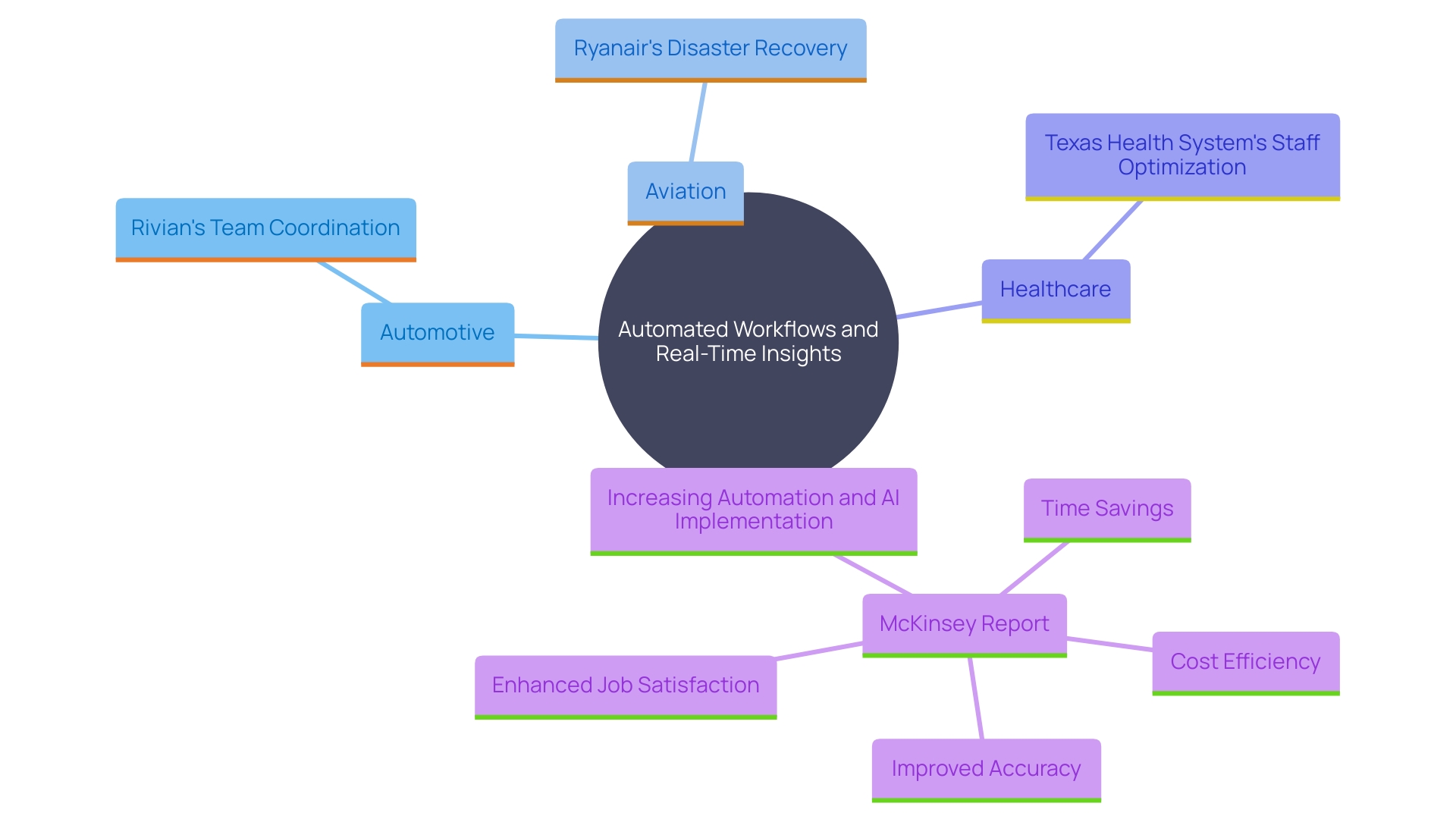
Better Resource Management and Allocation
Automation empowers organizations to allocate resources more effectively by harnessing data-driven insights into workload and performance. For instance, a company leveraged AI to automate the extraction of key values from over 2,000 PDF documents, a task previously performed manually by an employee. This not only freed up the employee to focus on more creative and impactful projects but also provided significant value to the company. The scalable solution was then implemented in various operational units, optimizing processes across the board.
Introducing AI and mechanization solutions permits enterprises to construct a modular tech stack, allowing teams to access essential data and tools promptly. This approach facilitates rapid innovation and seamless upgrades, ensuring optimal utilization of resources. As emphasized by a current workplace example, incorporating mechanization decreased the effort required for overseeing device lifecycles by 90%, enabling the organization to reassign talent to essential functions, thus enhancing productivity.
Statistics show that productivity in the U.S. has grown at a modest rate of 1.4% from 2005 to 2023. However, mechanization can significantly boost this figure by reducing the time and effort required for repetitive tasks. By dismantling internal data barriers, organizations can reveal new opportunities and enhance their financial performance, as shown by enterprises saving thousands, sometimes millions, of dollars through insights discovered by automated processes.
Business insights derived from data analysis are crucial for identifying areas ripe for automation. For example, understanding how fuel usage fluctuates or tracking real-time vehicle locations can help organizations make informed decisions that enhance resource allocation and productivity. By linking data to other organizational applications, companies can attain a more integrated and efficient workflow, ultimately resulting in improved ROI and a more sustainable operation.
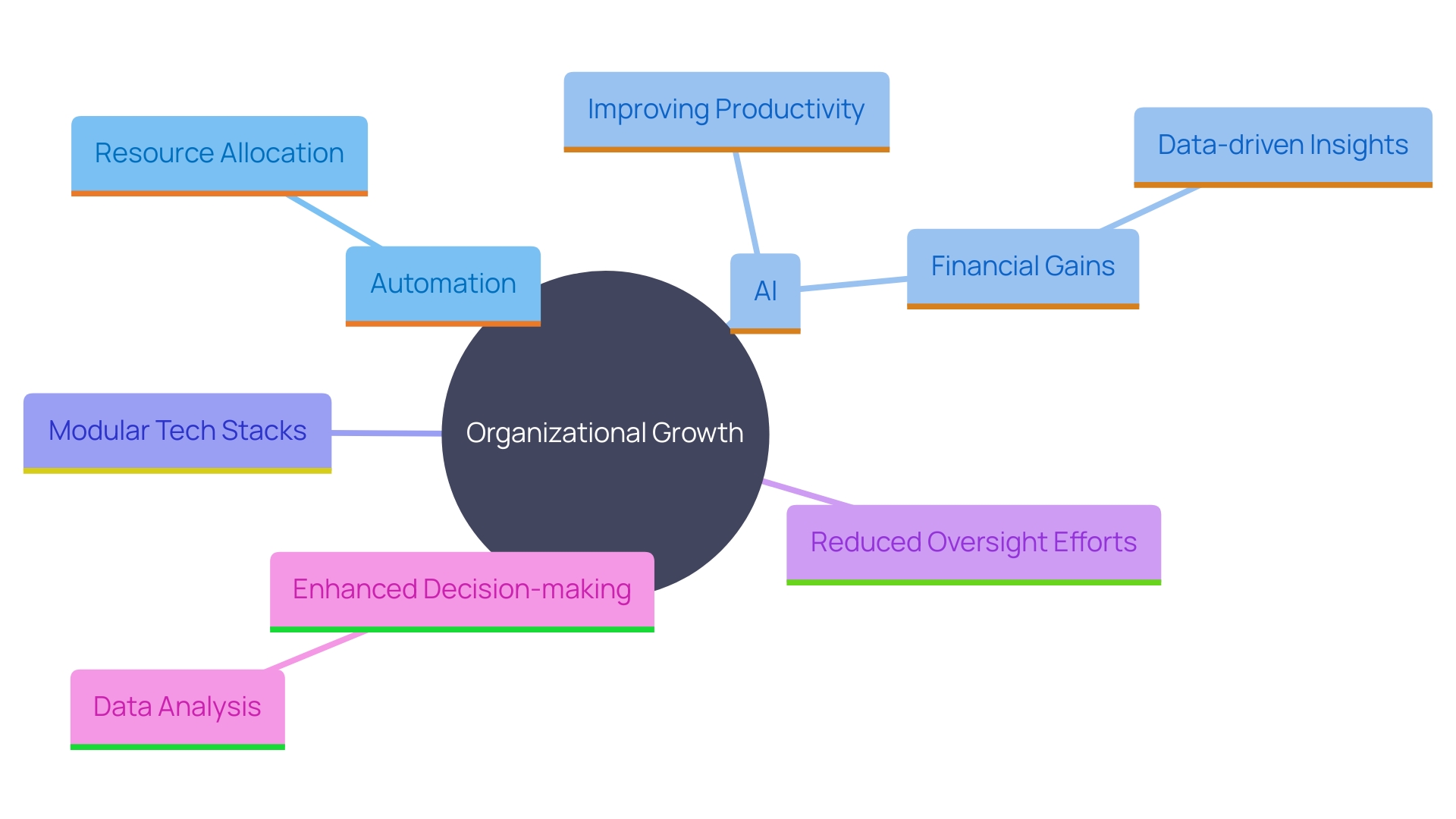
Faster Turnaround Times and Improved Customer Satisfaction
Streamlined processes empower businesses to respond to customer inquiries and fulfill orders with remarkable speed. This efficiency is pivotal in enhancing customer satisfaction and fostering loyalty, as clients increasingly value timely and reliable service. For instance, the Modern Store digital transformation project at Office Depot has revolutionized operational efficiency. By connecting data, assets, and people through in-store handsets and tasking software, 13,000 store associates across 1,500 stores can now spend more time serving customers. This has led to better scheduling, task assignment, and real-time reporting, thereby improving customer service.
Moreover, companies like St. James Winery, which adopted automation to handle increased demand and labor shortages, have seen significant improvements in production speeds and margins. Automation has also allowed them to measure ROI in terms of labor per case, demonstrating tangible benefits in operational efficiency.
Statistics underscore the importance of these improvements. According to a customer service study, 80% of customers believe that the experience a company provides is as important as its products or services, and 83% feel more loyal to brands that respond promptly to their complaints. These figures emphasize that efficient methods and timely service are not merely operational objectives but strategic necessities that drive customer loyalty and business success.
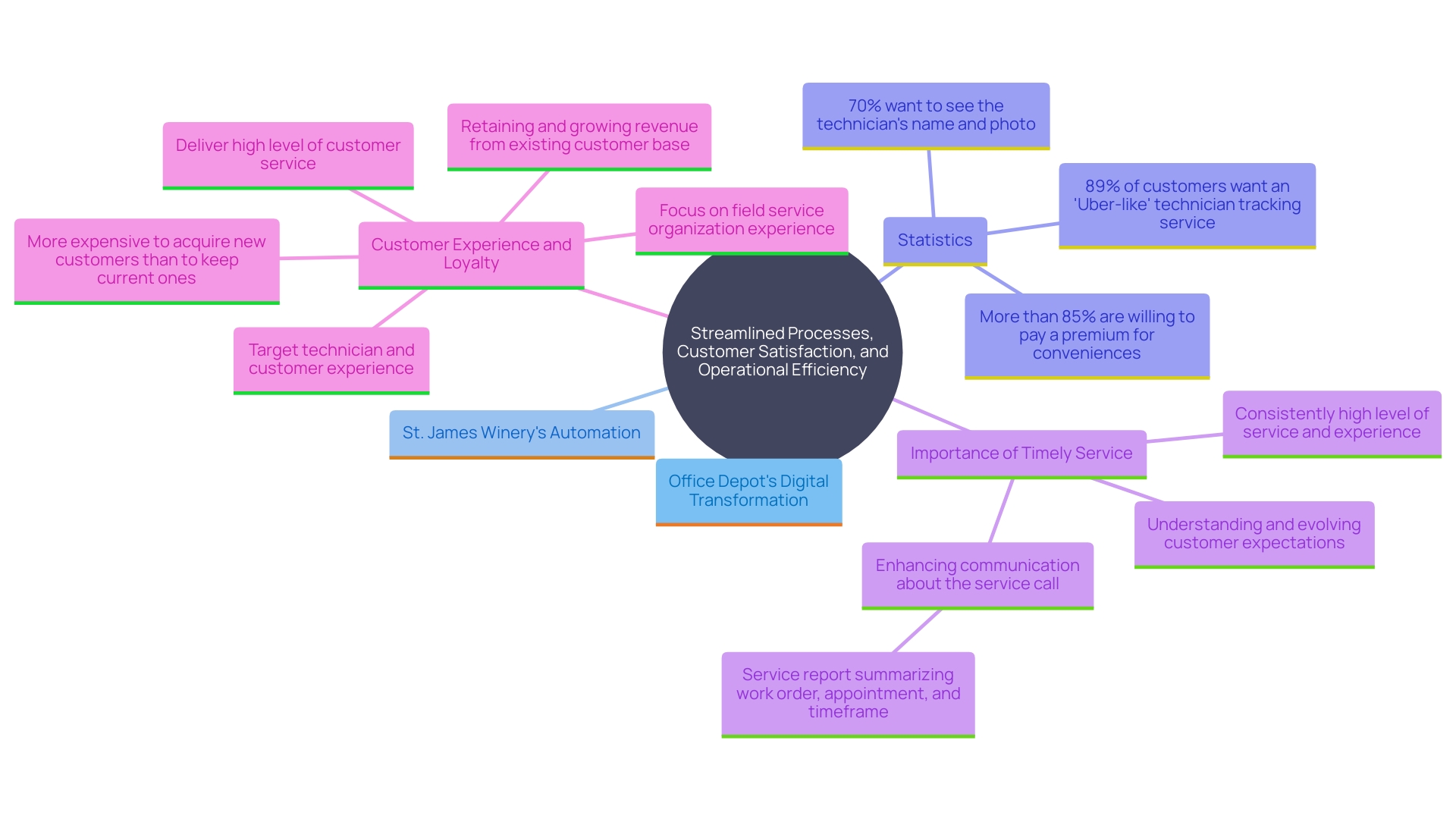
Enhanced Collaboration and Communication
Automated workflows significantly enhance team communication by providing a centralized platform for managing activities. For example, when Delivery Hero faced the challenge of employees getting locked out of their accounts, they implemented an automated system that streamlined the verification and restoration process, drastically reducing downtime. This case illustrates how automated workflows not only enhance collaboration but also ensure that all team members are aligned and well-informed.
Furthermore, tools such as Slack Lists have transformed project and activity management by incorporating these functions directly into a platform where teams are already collaborating. This eliminates the need for switching between multiple applications, thereby reducing inefficiencies and fostering better communication. According to a Gartner report, over 85% of companies using cloud-hosted project management tools such as these have reported faster project delivery times due to improved real-time collaboration and centralized data management.
The success stories of companies like Dubber further emphasize the benefits of automated workflows. By adopting advanced orchestration tools like Temporal, Dubber was able to transition from a basic orchestration tool to one that significantly enhanced their workflow efficiency. This shift enabled them to better manage responsibilities such as abuse detection and customer complaint handling, showcasing the transformative power of well-implemented automation.
In essence, automated workflows provide a robust framework that supports seamless communication and collaboration, ensuring that every team member is on the same page and every task is managed efficiently.
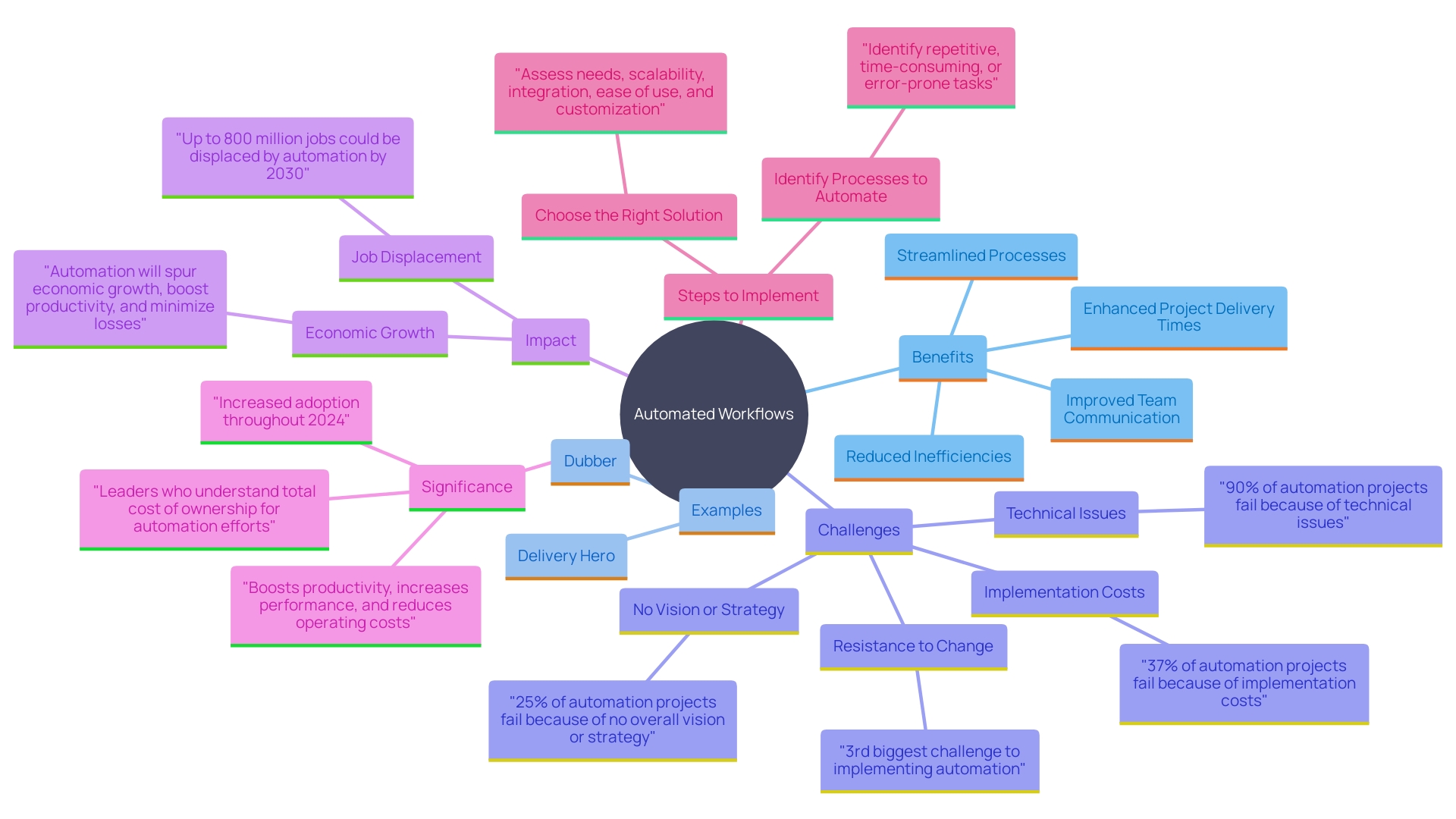
Cost Reduction and Scalability
Automation significantly reduces operational costs by minimizing reliance on manual processes and boosting accuracy. For instance, St. James Winery utilized technology to address labor shortages and enhance production efficiency, resulting in higher margins. Automated systems not only decrease errors but also optimize resource utilization, ensuring tasks are performed with high precision and reducing waste. According to a study by SS&C Blue Prism, organizations saw a net present value of $53.4 million over three years, attributed to increased productivity and cost savings. Moreover, mechanization enables companies to expand operations smoothly without a corresponding increase in expenses, highlighting its strategic significance in contemporary commercial environments.
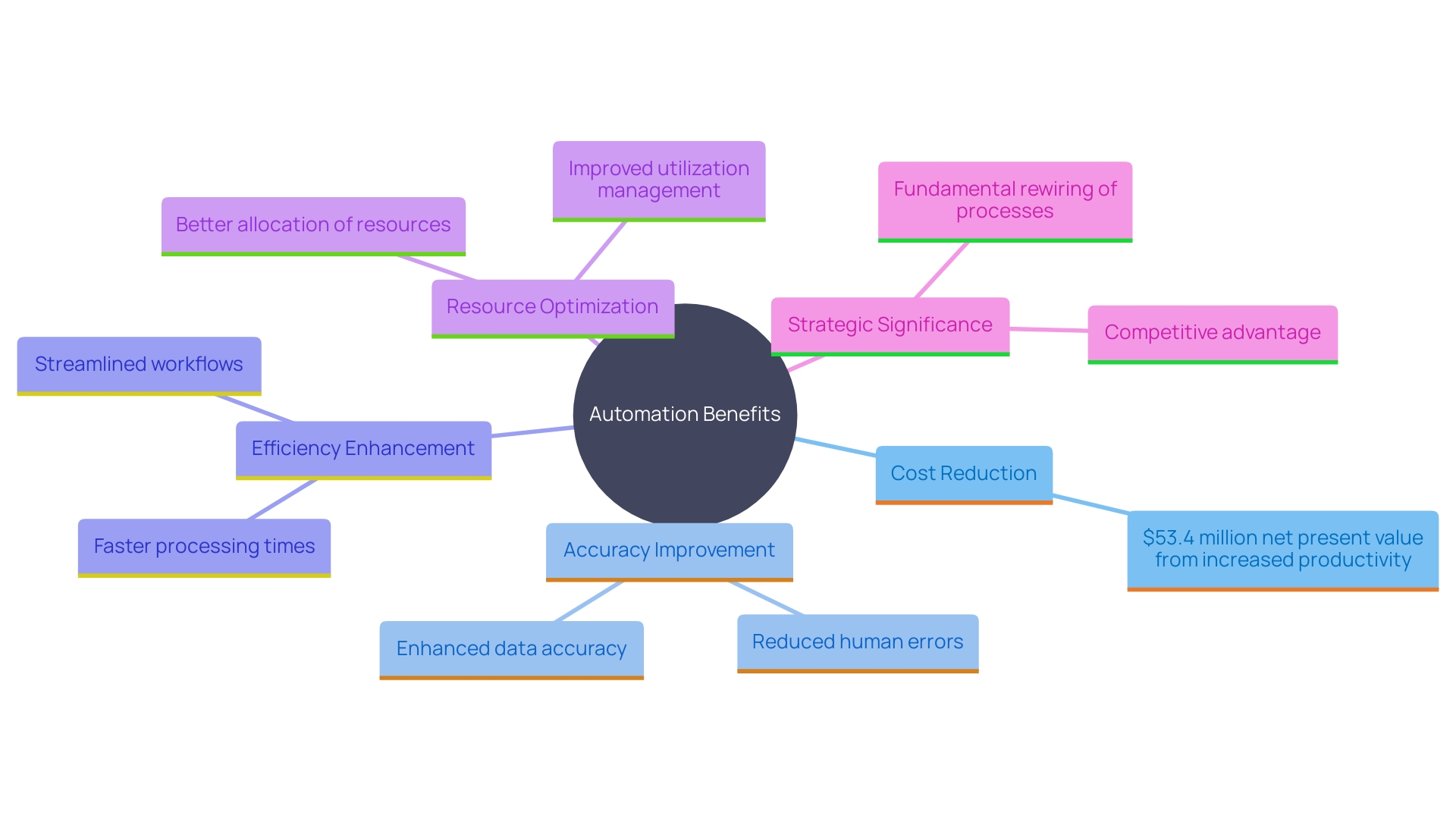
Enhanced Agility and Flexibility
Automated workflows empower businesses to swiftly adapt to evolving market demands and customer needs, ensuring agility and minimizing downtime. For instance, St. James Winery, a leading wine producer in the U.S., turned to mechanization to combat labor shortages and drive growth. Their decision not only improved efficiency but also boosted their margins. The case of Delivery Hero further exemplifies this, as they streamlined their account recovery process, significantly reducing employee downtime and enhancing productivity.
In the broader industrial sector, the demand for mechanization is projected to grow by 9.3% annually, reaching £227.6bn by 2030. This surge is driven by the need for streamlined operations across various industries, including manufacturing, which accounts for over 30% of the market. The transition towards mechanization is a reaction to the difficulties created by inflation, Brexit, and the COVID-19 pandemic, with 94% of IT decision-makers adopting technology modifications to ensure operational continuity and lessen crisis fatigue.
Furthermore, the use of automated processes assists organizations such as Lincoln Financial in shifting from expensive legacy systems to more adaptable settings, lowering operational expenses and facilitating improved decision-making. By concentrating on areas hindered by inefficiencies, companies can remove superfluous layers in procedures and improve overall operational effectiveness, as emphasized by industry specialists.
Despite the challenges, such as resistance to change and technical issues, the benefits of automation are clear. It not only mitigates the risk of job displacement but also spurs economic growth and boosts productivity, making it a crucial strategy for forward-thinking organizations.
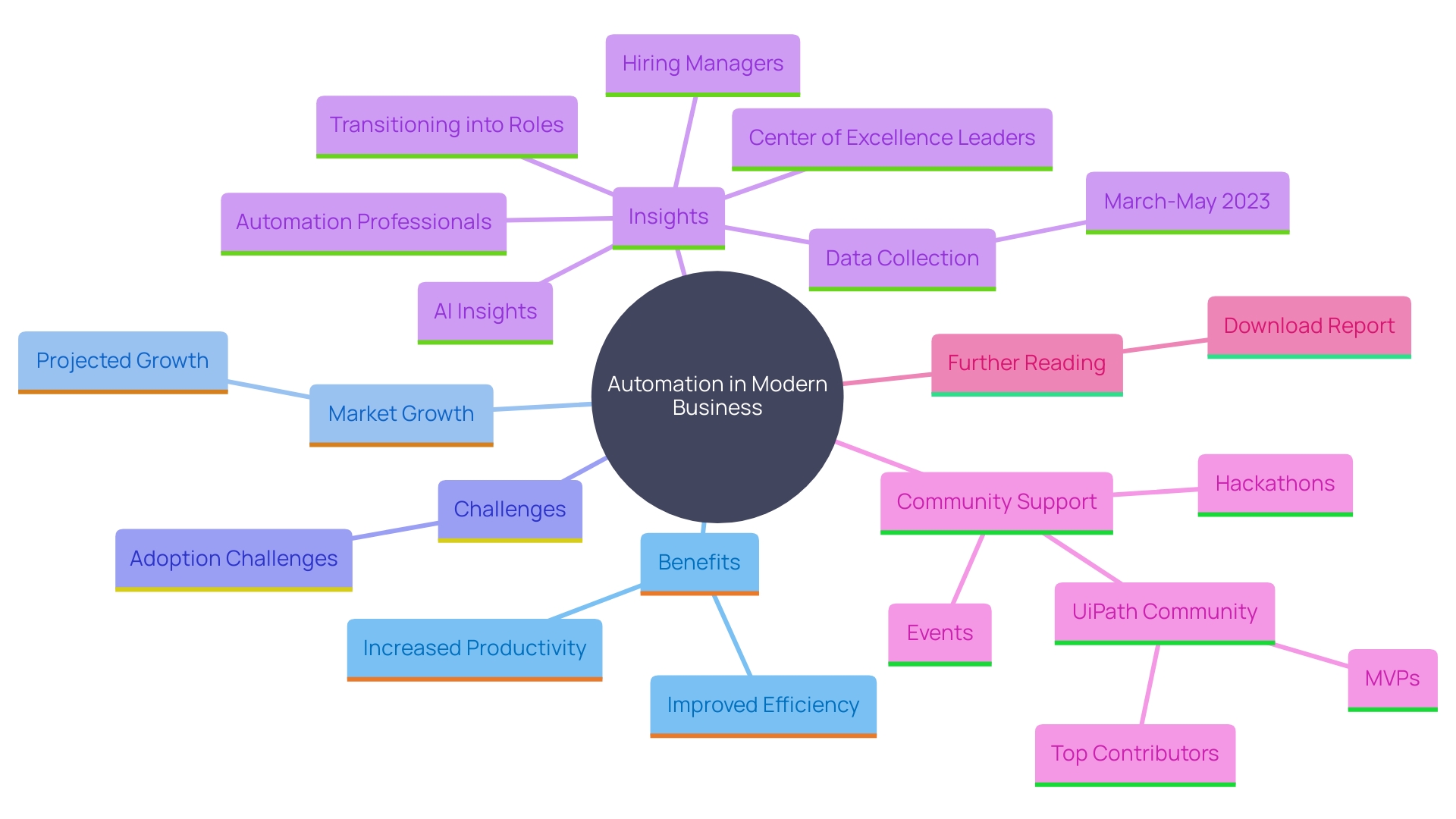
Improved Data Analysis and Performance Measurement
Automation enables the collection of data throughout processes, providing invaluable insights for performance measurement. For instance, Check Technologies achieved a 25% cost reduction through resource optimization and accelerated data processing, thus transforming raw data into actionable insights more efficiently. This agile approach, powered by tools like Airflow, allows businesses to organize and clean data, driving both existing and new feature improvements.
In a world of extraordinary data volumes and complexities, relying solely on human intuition for performance metrics is becoming obsolete. Sophisticated machinery and AI tools assist in redefining key performance indicators (KPIs), ensuring they align better with desired outcomes. As organizations grow, smarter KPIs driven by data and automation become crucial for sustained improvement.
Notably, 69% of managerial tasks are expected to be automated by 2024, highlighting the growing importance of strategic deployment. Automation not only enhances decision-making but also fosters continuous improvement, helping businesses realize significant cost optimization benefits. By integrating automation with AI, companies can make informed decisions that propel them towards their short-term and long-term goals.
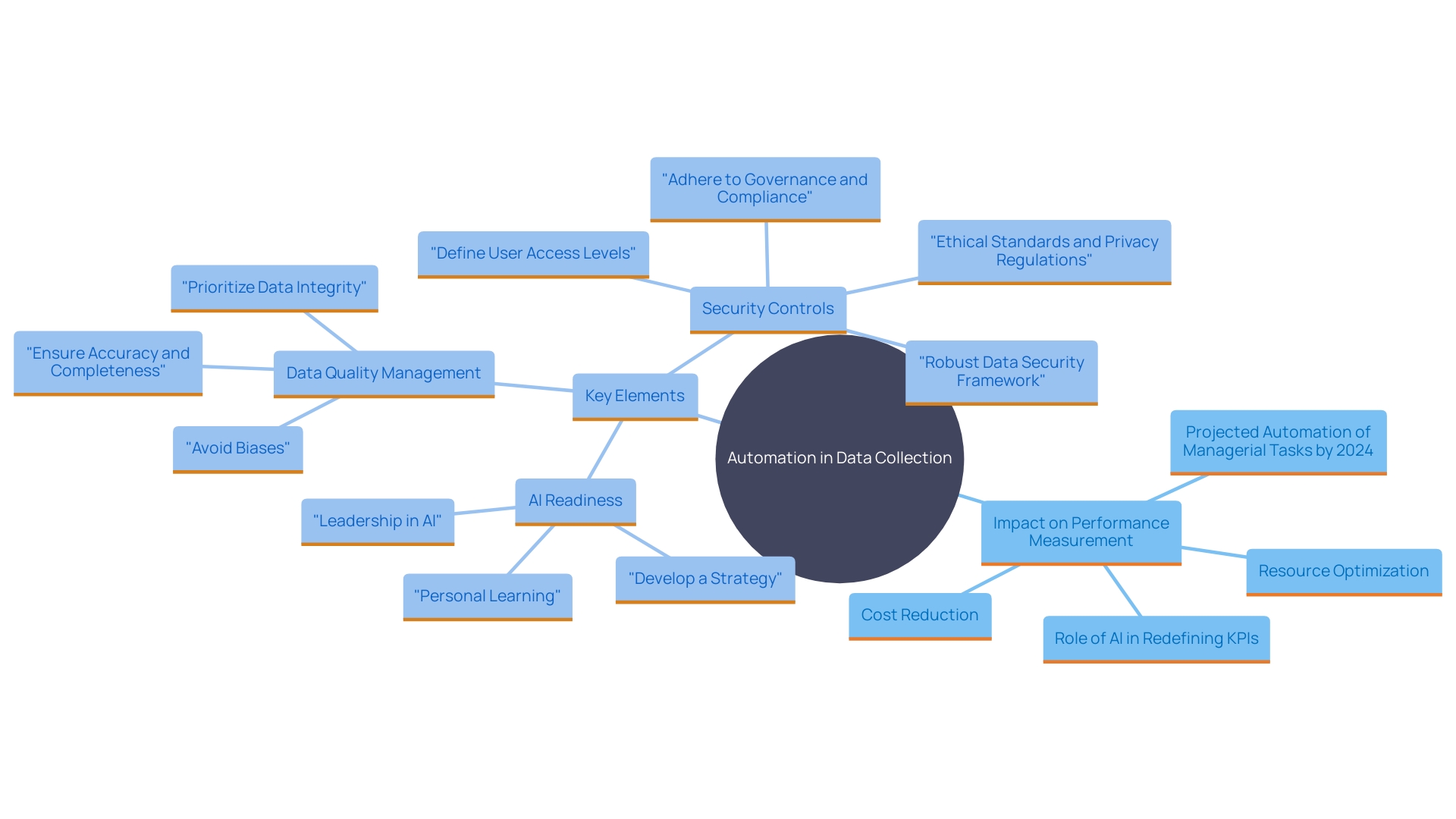
Conclusion
Automated workflows are transforming the business landscape by enhancing efficiency, productivity, and accuracy. By streamlining repetitive tasks, organizations can redirect their workforce to focus on higher-value activities, as seen in the success stories of Delivery Hero and St. James Winery. These examples highlight how automation boosts operational effectiveness while improving employee satisfaction and safety.
The financial benefits of automation are significant, yielding substantial cost savings and improved service levels. With the ability to respond quickly to customer demands, businesses can achieve faster turnaround times and greater customer satisfaction. Real-time insights from automated systems enhance visibility, enabling organizations to identify and resolve inefficiencies proactively.
Furthermore, automation facilitates better resource management and data analysis, offering valuable insights that drive performance improvements. As industries continue to evolve, the strategic importance of automation becomes increasingly clear, allowing organizations to adapt to market changes with agility and flexibility. The integration of advanced technologies like AI amplifies these advantages, positioning businesses for success in competitive environments.
In conclusion, adopting automated workflows is essential for organizations seeking to optimize processes, reduce costs, and enhance overall performance. Companies that effectively implement automation are better prepared to navigate the complexities of modern business, unlock new growth opportunities, and achieve sustainable success.
Introduction
Artificial Intelligence (AI) is no longer a futuristic concept; it is a present reality reshaping the business landscape across various sectors. From automating mundane tasks to providing deep data insights, AI is unlocking unprecedented levels of efficiency and innovation. Take Holiday Extras, for example, where AI seamlessly manages multi-language marketing content and automates the extraction of critical data from thousands of documents, freeing employees to focus on more strategic activities.
This transformative power of AI extends beyond operational efficiency; it fosters a data-driven culture that enhances decision-making and customer experiences.
Executives are increasingly viewing AI as a crucial driver of innovation and risk management, with significant productivity gains reported in core business processes like customer service, research and development, and procurement. As AI becomes integral to strategic initiatives, businesses are poised to benefit from more personalized and cost-effective deployment of marketing and sales resources. The optimism surrounding AI’s potential is not unfounded; its integration is seen as essential for maintaining competitiveness and driving long-term growth.
For traditional businesses, the adoption of AI leverages their domain expertise, established data sets, and strong brand reputation to develop better products and marketing strategies. Companies like Iron Mountain and Infosys illustrate how effectively integrating AI can solve existing problems, boost efficiency, and support revenue growth. Ultimately, embracing AI not only streamlines operations but also cultivates a culture of continuous innovation and data-driven decision-making, essential for thriving in today’s dynamic market.
The Transformative Power of AI
Artificial Intelligence (AI) is changing contemporary enterprises by automating processes, improving decision-making, and providing individualized client experiences. For instance, Holiday Extras uses AI to manage multi-language marketing content efficiently across diverse regions, from German to Polish. This approach is not confined to marketing alone; customer support and other departments benefit from AI-driven scalability and data fluency.
AI’s ability to analyze vast datasets swiftly and accurately is pivotal. At Holiday Extras, AI automated the extraction of key values from over 2,000 PDF documents, freeing up valuable time for employees to engage in more creative and meaningful tasks. This automation not only boosts efficiency but also fosters a more data-driven culture across traditionally qualitative functions, like design.
The incorporation of AI in companies has been associated with productivity increases of 30-40%, as noted at Davos. Executives regard AI as a catalyst for innovation and enhanced risk management, with a minimal impact on individual roles but a significant transformation in operational activities. Leaders are observing 62% of Ai’s value produced in essential operational processes, encompassing client support, research and development, and procurement.
Moreover, AI is key to strategic initiatives, driving long-term growth and innovation. A Marketbridge survey revealed that 52% of C-suite executives see AI as essential for deploying marketing and sales resources more cost-effectively and positioning solutions more personally and relevantly. This sentiment highlights the optimism surrounding AI’s potential to transform the commercial environment.

Key Benefits of AI Integration
Incorporating AI into business functions provides numerous advantages, such as increased operational efficiency, cost savings, and better client satisfaction. AI systems can streamline workflows by automating repetitive tasks, freeing employees to focus on higher-value activities. This leads to more informed decision-making and improved client experiences, ultimately giving companies a competitive edge in a rapidly changing market.
Ashish Gupta, global head of client support at Iron Mountain, emphasizes the significance of addressing current issues with AI. Iron Mountain utilized AI to manage a higher volume of customer care cases, significantly boosting efficiency and supporting anticipated revenue growth. Gupta emphasizes that utilizing data and tools effectively is crucial for achieving these outcomes.
In the wider commercial environment, AI integration is viewed as an essential element for future competitiveness. A Marketbridge survey reveals that 52% of C-suite executives and marketing leaders in B2B companies find AI instrumental in deploying marketing and sales resources more cost-effectively. Additionally, AI-driven insights significantly aid in positioning solutions in a more personalized and relevant manner, directly enhancing market positioning.
Traditional enterprises also possess unique advantages when adopting AI, such as domain expertise, established data sets, and strong brand reputation. These factors enable them to harness Ai’s potential more effectively, leading to better product development and marketing strategies. As Infosys, a leader in digital services, notes, AI and cloud technologies are essential for navigating digital transformation and creating new opportunities for enterprises and communities.
Ultimately, the successful integration of AI not only streamlines operations but also fosters a culture of innovation and data-driven decision-making. By embracing AI, companies can ensure sustainable growth and maintain their competitive edge in an evolving market.
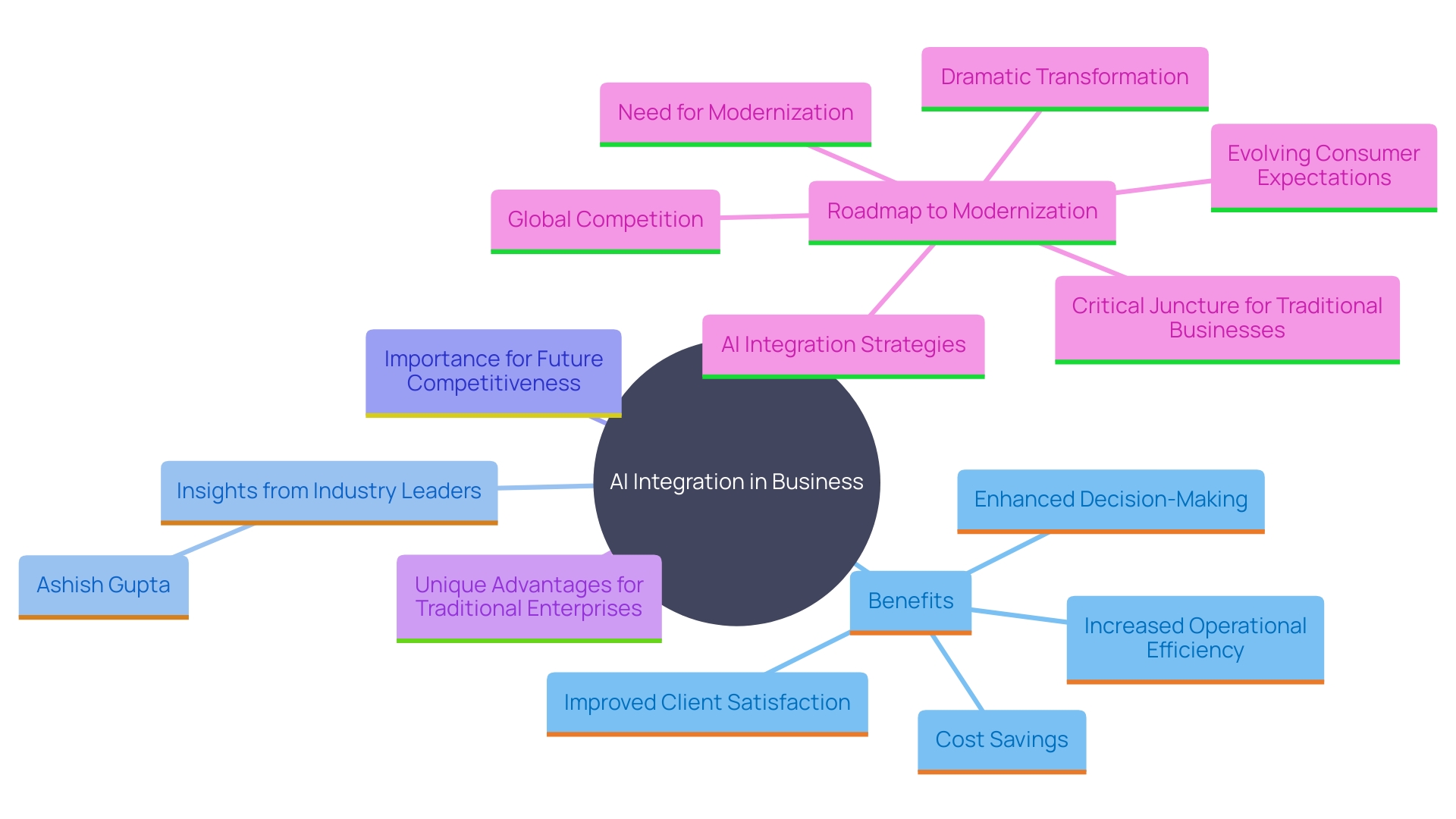
Implementing AI in Professional Services
Implementing AI in professional services effectively requires a strategic approach that includes assessing organizational readiness and pinpointing specific use cases. Organizations should initiate with pilot projects that demonstrate quick wins and build momentum. For example, an engineering department automated the tedious task of extracting key values from over 2,000 PDF documents. This not only saved time but also allowed the employee to focus on more meaningful projects. The scalable solution was later applied to various business units, proving its versatility and value.
Training and reskilling employees are crucial to ensure they can work alongside AI tools, fostering a culture of collaboration between humans and machines. According to Kathrin Dufour, Senior Vice President of Digitization and Technology at Wintershall Dea, having a standardized environment for information access and collaboration is essential in today’s interconnected world. This approach facilitates easier internal and external data exchange, enhancing teamwork and efficiency.
Moreover, organizations must adapt their leadership approaches to harness the combined power of AI and human capabilities. Balancing human and AI skills can create significant productivity and innovation gaps compared to relying solely on human skills. As AI adoption continues to grow, particularly in professional services, it’s evident that understanding and preparing for AI integration is a foundational step towards future competitiveness. Investing in AI readiness now is crucial for capturing the potential benefits of this transformative innovation.
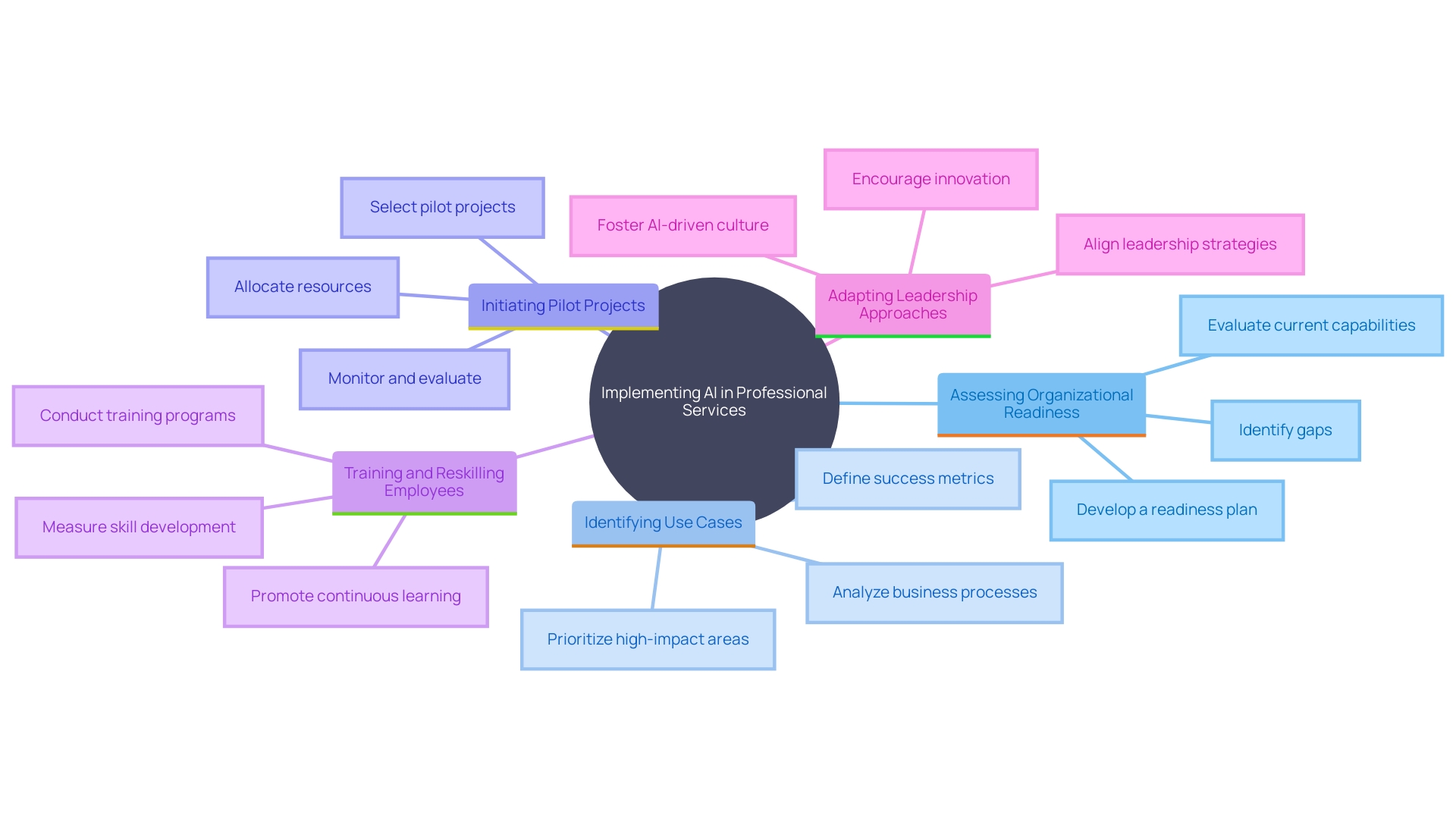
Future Trends in AI for Business
As AI advancements keep progressing, companies must stay ahead of new trends to maintain a competitive advantage. One significant trend is the rise of explainable AI, which enhances transparency in AI decision-making, making it easier for organizations to understand and trust the outcomes generated by AI systems. This trend is crucial as it addresses a common concern among organizations about the ‘black box’ nature of AI.
Another pivotal development is the increasing integration of AI with other technologies, such as blockchain and IoT. This fusion is creating new possibilities for operational efficiency and innovation. For instance, the modular AI software development kit (SDK) built on Bare allows developers to create private, peer-to-peer AI applications that can operate on a diverse range of devices, showcasing the practical applications of combining AI and blockchain.
Moreover, businesses are recognizing the vast potential of AI to transform information management. Traditionally, companies have relied on organized information due to its ease of processing. However, AI is enabling a shift towards unstructured and multimodal data (text, videos, audio), necessitating an evolution in data capturing, processing pipelines, and decision-making processes.
The implications of these trends are profound. For example, a report revealed that companies integrating AI expect cost savings exceeding 10%, primarily through productivity gains in operations, customer service, and IT. This efficiency boost underscores why digital and AI leaders must view transformation as an ongoing journey rather than a final destination. Continuous adaptation to new technologies will be essential for maintaining competitiveness.
In essence, companies that proactively embrace these advancements are not only optimizing their operations but also creating new opportunities for growth and innovation. As one industry expert noted, ‘AI is not a distant goal; it is the prerequisite foundation for future competitiveness. The time to invest in AI readiness is now.’

Conclusion
The integration of Artificial Intelligence (AI) into business operations represents a significant shift in how organizations function, driving efficiency, innovation, and enhanced customer experiences. Companies like Holiday Extras exemplify the transformative impact of AI, showcasing its ability to automate processes and manage complex tasks. This newfound efficiency enables employees to focus on higher-value activities, fostering a culture of creativity and data-driven decision-making.
The benefits of AI extend beyond operational improvements; they encompass strategic advantages that position businesses for long-term growth. With reports indicating productivity gains of 30-40%, AI is recognized as a catalyst for innovation and improved risk management. By leveraging existing data and domain expertise, traditional businesses can harness AI to refine products and tailor marketing strategies, thereby enhancing their competitive edge.
As AI technology continues to evolve, organizations must remain vigilant in adapting to emerging trends, such as explainable AI and the integration of AI with other technologies. This proactive approach will not only optimize operations but also unveil new opportunities for growth. By investing in AI readiness today, businesses can ensure they are well-prepared to navigate the complexities of tomorrow’s market landscape, solidifying their position as leaders in an increasingly dynamic environment.
Introduction
In today’s rapidly evolving business landscape, leveraging Artificial Intelligence (AI) has become a pivotal strategy for enhancing operational efficiency and fostering innovation. Implementing an AI Proof of Concept (PoC) offers organizations a unique opportunity to test and validate AI solutions on a smaller scale before committing to full-scale deployment. This article delves into the comprehensive process of developing and executing an AI PoC, highlighting key steps such as problem identification, data preparation, design and build phases, evaluating outcomes, and strategies for scaling up.
Additionally, it addresses common challenges and provides practical solutions to ensure successful AI integration. By focusing on these critical aspects, businesses can harness the transformative power of AI to drive efficiency, reduce costs, and achieve a competitive edge in the market.
Benefits of AI PoC in Business Strategy
Implementing an AI Proof of Concept (PoC) can significantly elevate business strategies by providing a tangible demonstration of Ai’s potential impact on operations. This process allows entities to test hypotheses, validate assumptions, and measure outcomes before committing to full-scale deployment. By conducting a PoC, companies can pinpoint specific areas where AI can boost efficiency, cut costs, and enhance decision-making processes.
The success of AI PoCs can also drive broader digital transformation initiatives, fostering innovation and competitive advantage. For instance, a Forrester study found that 24% of businesses experienced a 16% to 20% reduction in time to market for new products, while 27% saw improvements ranging from 11% to 15%. These advancements highlight the importance of integrating AI into business operations to enhance agility and market competitiveness.
Moreover, upskilling on AI now is crucial for future preparedness. As highlighted in a Forrester study, “In five years, running a business without AI tools like Copilot would be like trying to run a company today using typewriters instead of computers.” Upskilling ensures that businesses are ready to leverage AI capabilities effectively, accelerating revenue growth and opening doors to additional opportunities.
In summary, AI PoCs are not only a proving ground for AI’s capabilities but also a strategic tool for driving efficiency, reducing costs, and fostering innovation within companies. By focusing on these areas, businesses can create a robust foundation for future AI integration and digital transformation.
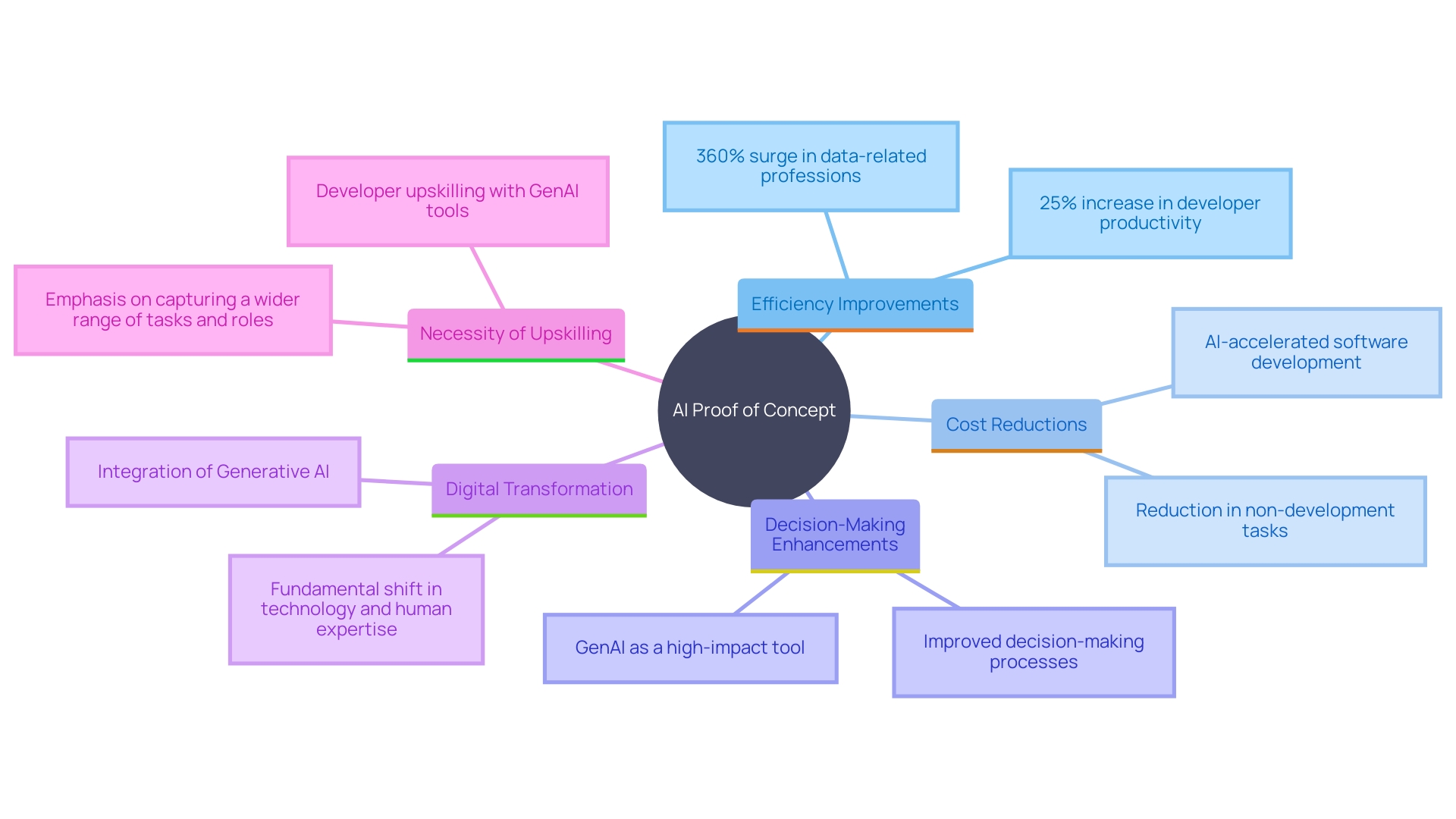
Step 1: Determine the Problems to Solve with AI
The initial step in developing an AI Proof of Concept (PoC) is to clearly define the problems or challenges that the entity aims to address. This involves a comprehensive assessment of existing operational processes and gathering input from stakeholders to identify pain points that could benefit from AI solutions. For instance, the ITS all-staff meeting showcased how engaging employees in generating use cases can reveal innovative opportunities and potential risks associated with AI tools. By prioritizing specific issues, businesses can focus their efforts on developing targeted use cases that align with strategic objectives, ensuring that the AI implementation has a meaningful impact. This approach has been confirmed by entities like a leading bank, which saw a 20% improvement in customer satisfaction through the creation of AI assistants, and a pharmaceutical company, which achieved a 75% increase in operational efficiency. Embracing a strategic focus on AI readiness and aligning AI initiatives with business goals can lead to significant advancements in efficiency and customer satisfaction, as evidenced by these success stories.
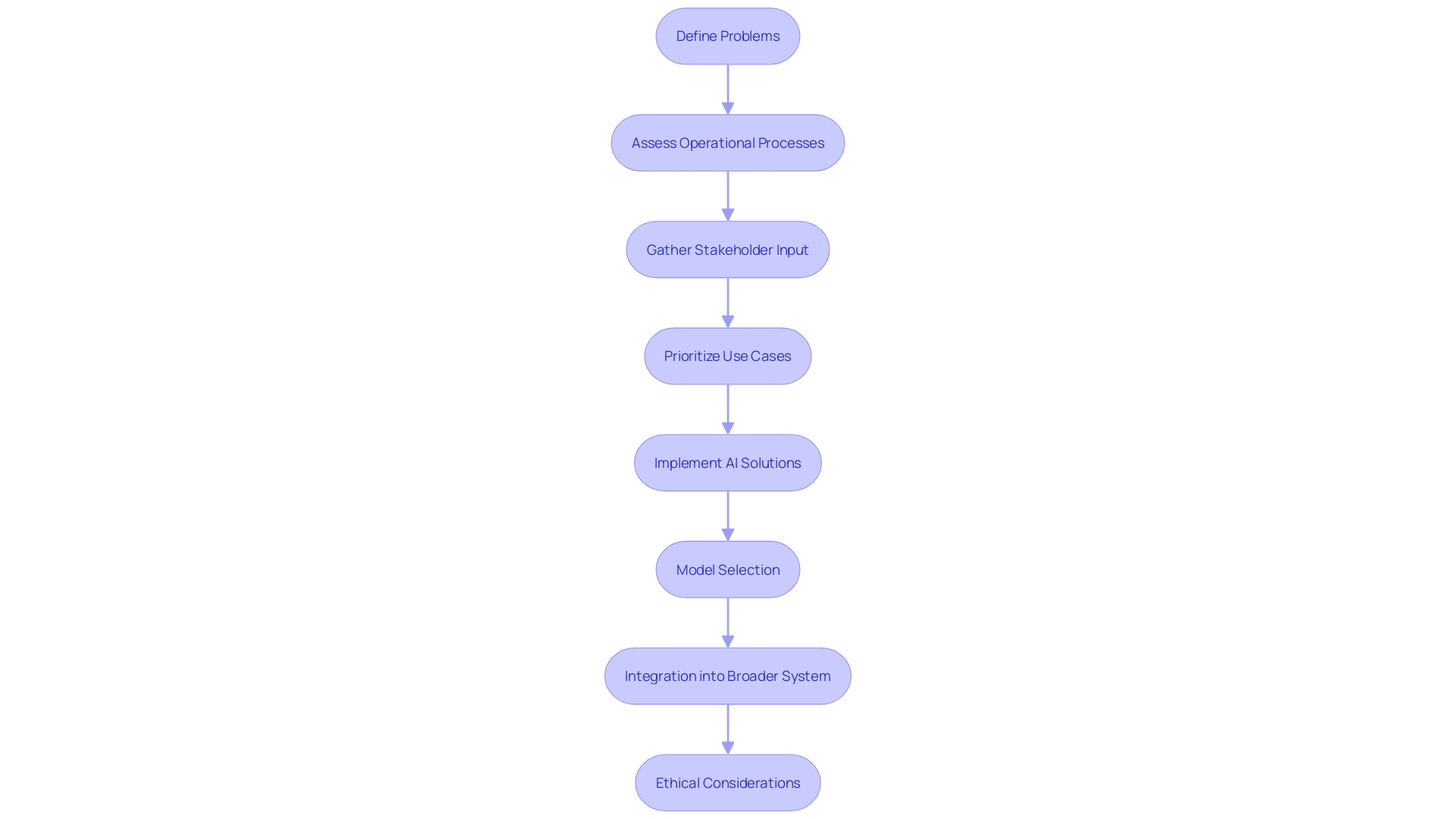
Step 2: Data Selection and Preparation
Data is the backbone of any AI initiative, making careful selection and preparation crucial for the success of a Proof of Concept (PoC). Organizations must identify relevant datasets, ensuring they are of high quality, representative, and sufficient in volume to train AI models effectively. The process begins with information exploration, where organizations can apply machine learning classification models to understand patterns and make informed predictions. For instance, automotive companies developing new car models can use machine learning to predict performance and fuel economy based on different drivetrain configurations.
To ensure the success of AI projects, it is essential to clean and preprocess the information, eliminating inconsistencies and biases. This meticulous manual information preparation is often required, even in today’s digital era, where substantial content is generated daily. Effective information management lays the groundwork for accurate insights and robust predictive capabilities. Implementing a comprehensive information governance framework that prioritizes quality, security, and accessibility is essential for maximizing AI’s effectiveness. This alignment with organizational goals fosters trust in AI-generated insights, ensuring reliable and actionable outputs.
Furthermore, the significance of efficient information management is emphasized in datathons, where participants address issues related to information within a limited period. These events illustrate the necessity of clear guidelines and best practices for information management. Utilizing Natural Language Processing (NLP) and Large Language Models (LLMs) can assist in scaling the evaluation and discovery of pertinent information, boosting the potential of AI initiatives by providing structured content from unstructured text. By emphasizing information quality and efficient oversight, entities can unleash the complete capabilities of AI applications.
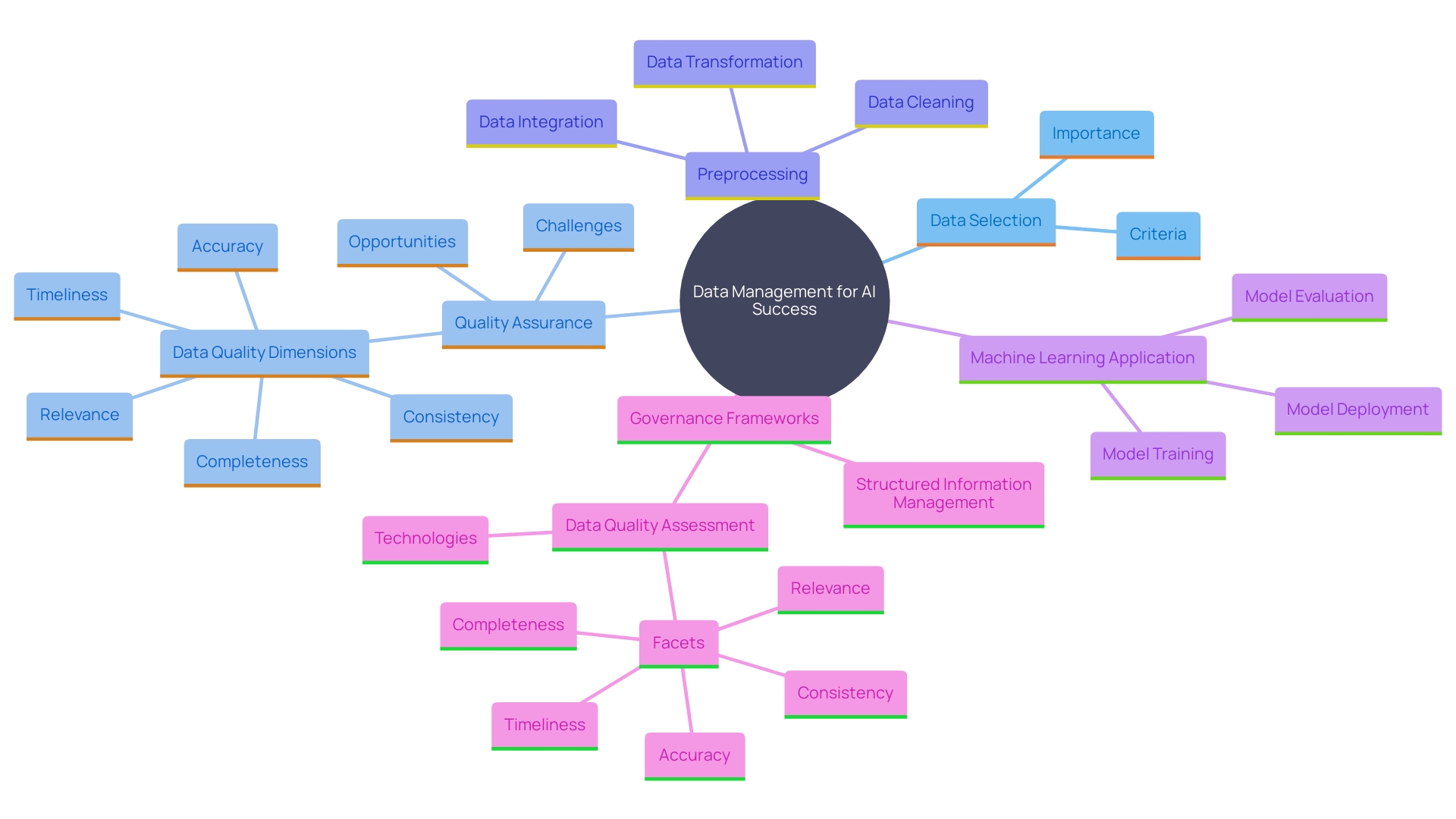
Step 3: Designing and Building an AI PoC
With a clear understanding of the problem and the necessary information in hand, the next step is to design and build the AI Proof of Concept (PoC). This involves selecting appropriate AI tools and technologies that align with the organization’s needs and defining the architecture of the solution. During this phase, it’s essential to consider performance and scalability, ensuring that the system is responsive and efficient in processing information and generating outputs, as well as capable of handling projects of varying sizes and complexities.
The development phase includes creating algorithms, training models, and iterating on the design based on initial results. For instance, the process of building a sepsis AI tool involves preparing the clinical environment, designing the user interface, and validating the machine learning model with retrospective data. This meticulous approach ensures that the AI tool is reliable and meets the intended objectives.
Collaboration with cross-functional teams is crucial during this stage to ensure that the PoC aligns with business processes and stakeholder expectations. By integrating with existing tools and systems, the AI approach can revolutionize project initiation, making the entire development process smoother and more efficient. For example, an AI requirements agent can automate the mundane parts of requirements gathering, ensuring that every piece of information is clear and actionable.
Moreover, adopting a data-centric and ethical approach in AI development solidifies trust in AI systems across all domains, particularly in mission-critical applications. The future of AI will hinge on these robust frameworks that handle complexity transparently and ethically, as highlighted by experts from the University of Notre Dame Center for Research Computing. Their extensive experience in scientific software and algorithm development highlights the significance of ethical considerations in AI applications.
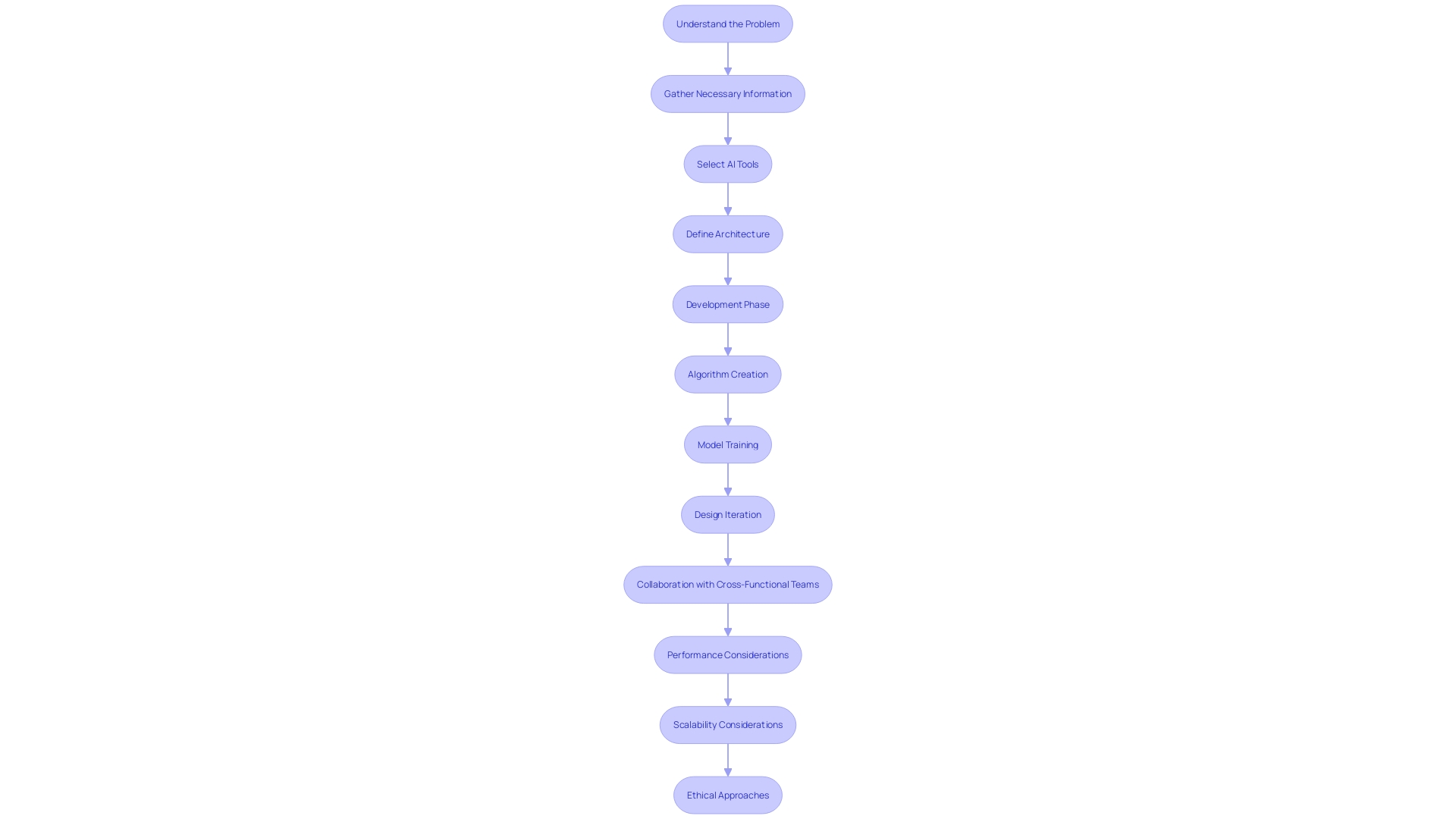
Step 4: Evaluating AI PoC Outcomes
Once the AI Proof of Concept (PoC) is developed, a thorough evaluation of its outcomes becomes crucial. This involves a comprehensive analysis of performance metrics such as accuracy, efficiency, and user feedback. By comparing these results against the initial objectives, valuable insights can be gathered regarding the effectiveness of the AI system. For instance, the Digital Technology Assessment Checklist (DTAC) is often utilized to ensure that the technology meets necessary standards, as noted by project managers who rely heavily on it during the initial review stages.
Moreover, knowledge-sharing meetings play a significant role in technical deployment activities. These sessions, which can include both in-person and hybrid formats, are essential for understanding data protection impact assessments and governance requirements, especially beneficial for team members with tight schedules. Demonstrations of the AI software in these meetings provide deeper insights into the system, serving as a precursor to formal training.
The evaluation phase also involves understanding discrepancies and analyzing statistics to identify areas needing improvement. For example, recent AI trials in UK public transport have shown significant enhancements in operational efficiency, but they also raised ethical concerns regarding privacy, highlighting the importance of a balanced approach.
As part of our Preparedness Framework, we are investing in improved evaluation methods for AI-enabled safety risks, which would benefit from broader input and community feedback. This collaborative approach aims to refine and advance the methodologies used to assess AI technologies.
By rigorously assessing the AI PoC, necessary adjustments and enhancements can be recognized and executed, ensuring the AI system is robust and prepared for full-scale deployment. This meticulous process not only validates the PoC’s value but also sets the stage for its successful integration into the operational framework.

Step 5: Scaling Up and Implementation Strategies
Once the AI PoC demonstrates positive outcomes, the next step is to develop strategies for scaling up the approach. This involves planning for integration with existing systems, ensuring compliance with data regulations, and addressing potential operational challenges. Organizations should consider change management strategies to facilitate smooth adoption among employees and stakeholders. A phased rollout can help manage risks and ensure that the AI system delivers sustained benefits.
To begin, it is crucial to set up a robust evaluation and feedback mechanism. As highlighted in our case study, establishing a continuous learning loop through human oversight allows the system to improve without jeopardizing customer satisfaction. This approach ensures that AI augments the skills of employees rather than replacing them, leading to a more effective and harmonious integration.
Furthermore, an AI@Scale approach emphasizes building projects for scalability from the outset. This means utilizing a centralized platform and methodology that can be rapidly extended to other groups within the entity. Kathrin Dufour from Wintershall Dea underscores the importance of a standardized environment for data access and collaboration, which significantly enhances the ease of scaling AI solutions across the partner ecosystem.
Furthermore, comprehending the entity’s stage of AI readiness is crucial. Organizations at the realizing stage of AI implementation were found to be significantly more successful, with 96% deriving substantial value from their AI initiatives compared to just 3% at the exploring stage. This signifies the importance of prioritizing and optimizing AI strategies based on the entity’s readiness.
Finally, it is essential to focus on long-term metrics, objectives, and key results (OKRs) to track progress and ensure sustained benefits. Establishing clear goals and regular reviews can help maintain focus and drive continuous improvement. By adopting these strategies, entities can successfully scale their AI solutions and achieve significant, sustained value.

Overcoming Challenges in AI Implementation
Implementing AI can be a complex endeavor, often presenting several challenges such as resistance to change, privacy concerns, and integration issues. To navigate these obstacles, groups must cultivate a culture of innovation and collaboration. A strategic approach to knowledge sharing, like hosting face-to-face workshops and hybrid meetings, can significantly enhance understanding and acceptance of AI technologies among employees. This method proved beneficial in a case where a project team conducted demonstrations and workshops, which included knowledge sharing on Data Protection Impact Assessments and governance requirements. Such initiatives not only foster a collaborative environment but also prepare employees for formal training, thus reducing resistance.
Furthermore, privacy concerns can be alleviated through clear communication regarding usage and strong governance frameworks. With 76% of organizations lacking comprehensive AI policies, it is crucial to address factors that erode trust, such as data privacy, sovereignty, and compliance with global regulations. Establishing clear governance structures ensures that ethical considerations like bias, fairness, and transparency are prioritized.
Integration issues can be addressed by adopting scalable AI approaches. For instance, an engineering department automated the extraction of key values from over 2,000 PDF documents, freeing up employees for more meaningful work. This solution, initially deployed in one department, quickly scaled to other business units, demonstrating the importance of scalable and flexible AI frameworks.
Finally, fostering a culture that is prepared and motivated for AI adoption is vital. Although only 21% of entities possess comprehensive change management plans, high motivation levels suggest a willingness to prioritize AI integration. By ensuring that leadership communicates AI strategies clearly and supports employees through training and resources, companies can overcome these challenges and leverage AI to enhance productivity and efficiency.
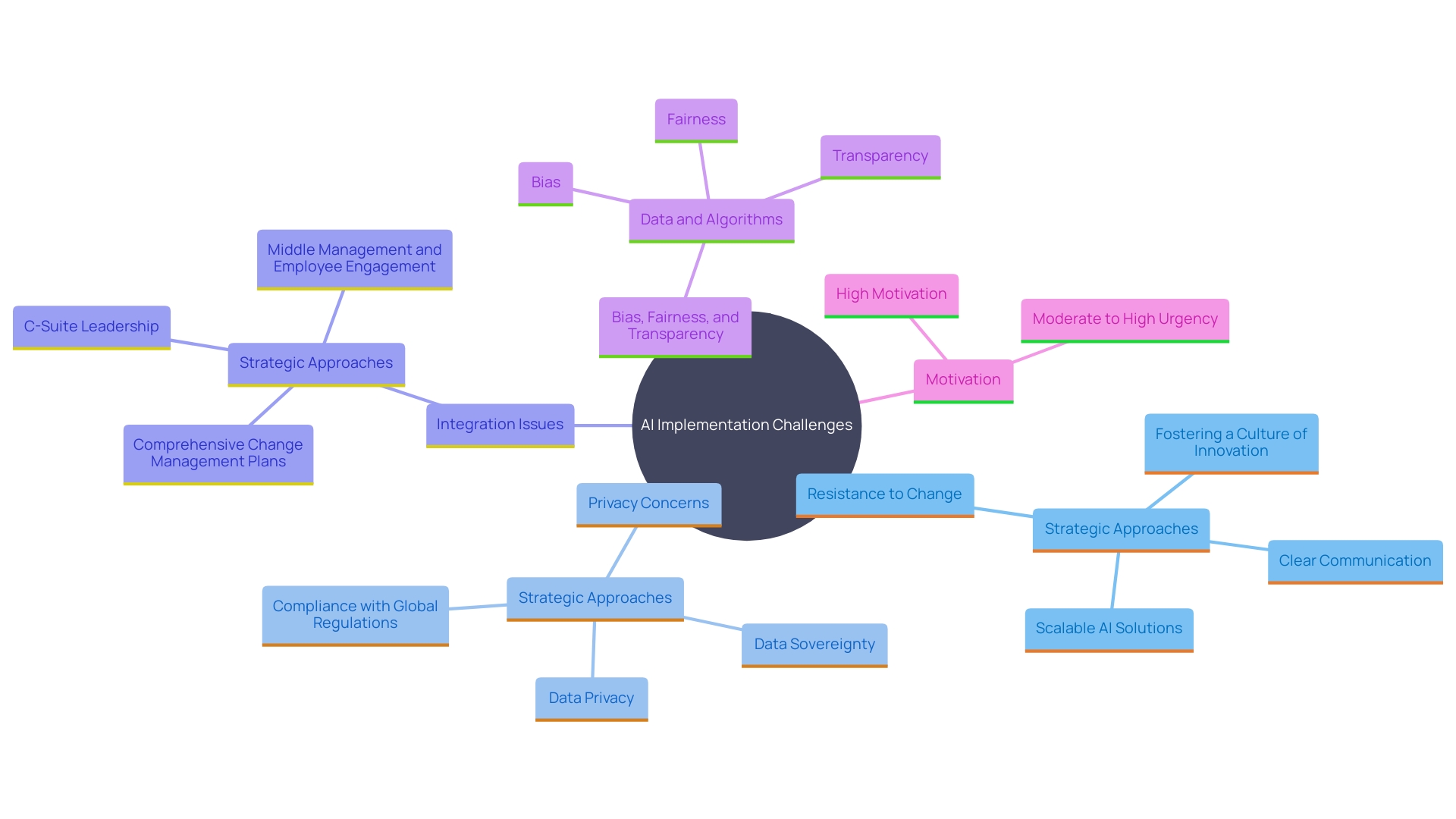
Key Considerations for Successful AI PoC Development
Successful development of an AI PoC (Proof of Concept) requires meticulous consideration of various factors. To start, entities must ensure that their AI initiatives align with their strategic goals. This alignment can be achieved by leveraging insights and predictions powered by AI, which can significantly influence and transform strategic decisions.
Investing in the right talent and technology is essential. For instance, companies like AiDo have successfully developed AI-powered virtual CSOs (Chief Strategy Officers) to validate and refine product ideas, demonstrating the practical necessity of integrating AI into strategic roles. This method is especially advantageous when small teams within a company can autonomously create and expand AI projects, as demonstrated by an engineering group that automated the retrieval of essential information from thousands of PDFs, enabling staff to concentrate on more significant tasks.
Maintaining agility throughout the AI PoC process is crucial. This can be facilitated by fostering a culture of continuous learning and adaptation. Knowledge-sharing meetings and workshops, whether in-person or hybrid, can enhance collaboration and ensure that all team members, regardless of their location or duties, are well-informed and engaged. This approach not only improves the deployment of technical solutions but also supports compliance with data protection and governance requirements.
Engaging stakeholders from various departments is another key factor. By holding inclusive meetings and workshops, groups can ensure broad support and collaboration, thus overcoming resistance to change. This engagement is vital for rethinking team dynamics and leadership in the age of AI, as entities will need to balance human and AI skills to create significant productivity and innovation gaps.
In summary, a successful AI PoC requires strategic alignment, investment in talent and technology, agility, continuous learning, and stakeholder engagement. By addressing these factors, organizations can refine their AI strategies and maximize the benefits of their AI initiatives.
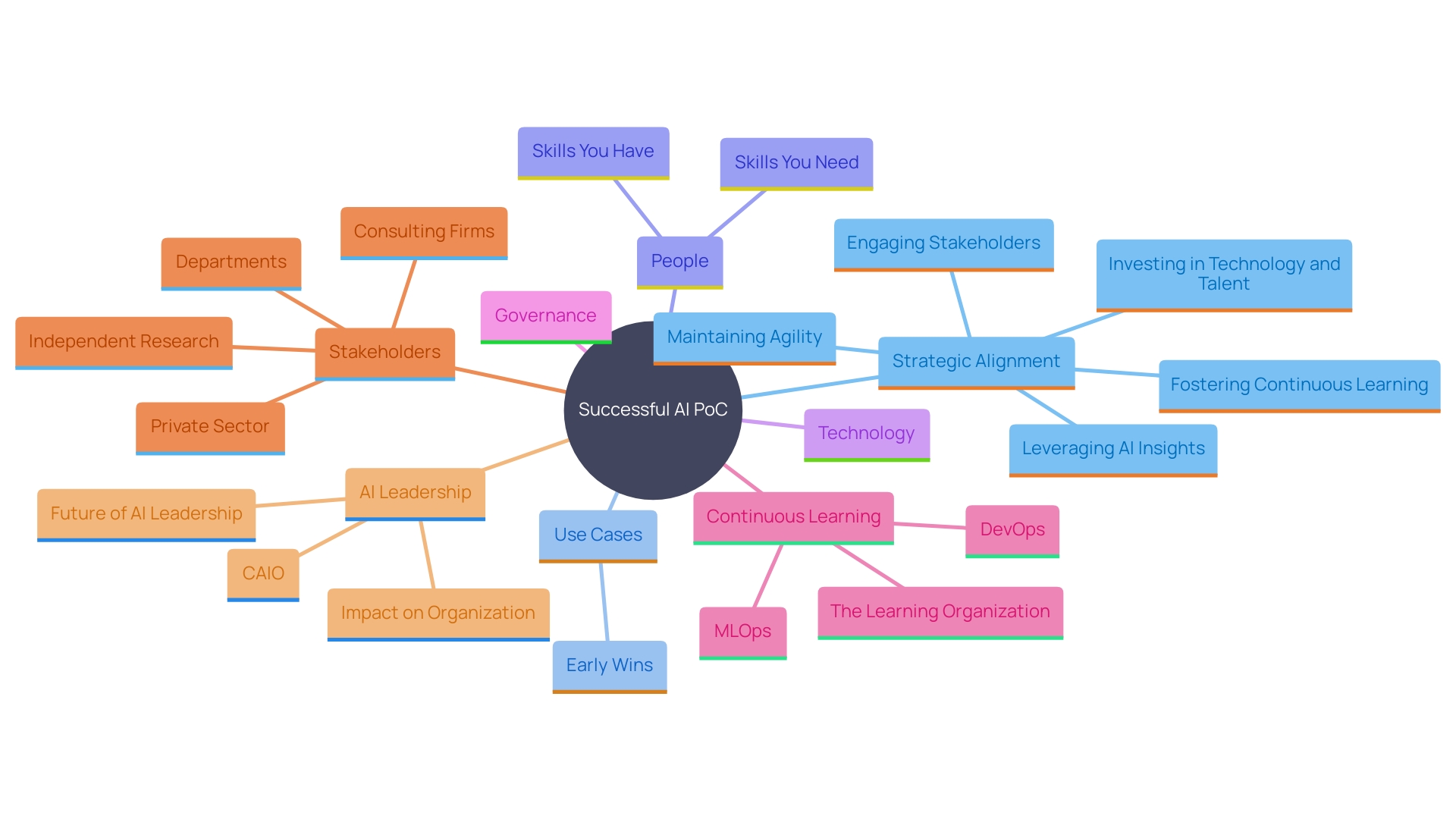
Conclusion
The implementation of an AI Proof of Concept (PoC) presents a transformative opportunity for organizations seeking to enhance their operational efficiency and innovate within their business strategies. By clearly defining problems, selecting and preparing data, designing tailored AI solutions, and rigorously evaluating outcomes, companies can create a solid foundation for successful AI integration. The process not only identifies specific areas where AI can drive efficiency and cost reduction but also fosters a culture of innovation that is essential in today’s competitive landscape.
As organizations navigate the complexities of AI implementation, they must remain vigilant in addressing challenges such as resistance to change and data privacy concerns. Establishing robust governance frameworks and fostering a collaborative environment can significantly mitigate these issues, ensuring that employees are engaged and informed throughout the transition. Moreover, understanding the organization’s readiness for AI and adopting scalable solutions will facilitate smoother integration and maximize the benefits of AI technologies.
Ultimately, the key to successful AI PoC development lies in aligning initiatives with strategic goals, investing in the right talent and technology, and maintaining agility throughout the process. By focusing on these critical components, organizations can unlock the full potential of AI, driving significant improvements in efficiency, decision-making, and overall business performance. Embracing this approach not only positions companies for immediate success but also prepares them for a future where AI will play an increasingly vital role in shaping business strategies.
Introduction
Artificial Intelligence (AI) is transforming consulting practices, offering unparalleled advantages and reshaping traditional methodologies. The integration of AI not only enhances efficiency and data analysis but also personalizes client solutions, enabling consulting firms to deliver more precise and strategic recommendations. By automating routine tasks, consultants can focus on high-value activities, optimizing resources and accelerating project timelines.
The ability of AI to process vast datasets quickly provides deep insights, driving informed decision-making and strategic forecasting. This article delves into the myriad benefits and key use cases of AI in consulting, explores AI-driven problem-solving and predictive modeling, and offers strategies for integrating AI into consulting practices. It also addresses the ethical considerations necessary for responsible AI use and examines future trends and opportunities that AI presents in the consulting industry.
Benefits of AI in Consulting
Incorporating AI into advisory practices provides numerous advantages, such as increased efficiency, better information analysis, and tailored solutions for customers. Firms leveraging AI can automate routine tasks, freeing consultants to focus on high-value activities, thereby optimizing resource allocation and accelerating project timelines. For instance, a Harvard Business School study revealed that consultants using AI tools completed tasks 25.1% faster and were 12.2% more productive than their non-AI counterparts.
AI-powered analytics enable deeper insights from vast datasets, driving informed decision-making and strategic recommendations tailored to client needs. This capability enables consultants to create predictive models that project future scenarios based on historical and real-time information, assisting businesses in anticipating market trends, customer behavior, and demand fluctuations. According to McKinsey, companies that fully leverage AI could see a 20-25% increase in cash flow.
Moreover, AI’s ability to process massive amounts of data quickly and accurately means consultants can easily extract valuable insights buried under complex datasets, providing data-driven recommendations and strategies. This leads to more informed decision-making and efficient problem-solving, particularly valuable in volatile markets.
Furthermore, AI-driven automation in advisory services can streamline various processes, such as supply chain management, logistics, and customer service through chatbots and personalized recommendations. As AI technology continues to evolve, its role in enhancing business operations and competitive advantage becomes increasingly significant. Despite concerns about the accuracy of AI outputs, it is important to note that human-based advice is also prone to errors, and all outputs should be checked for accuracy.
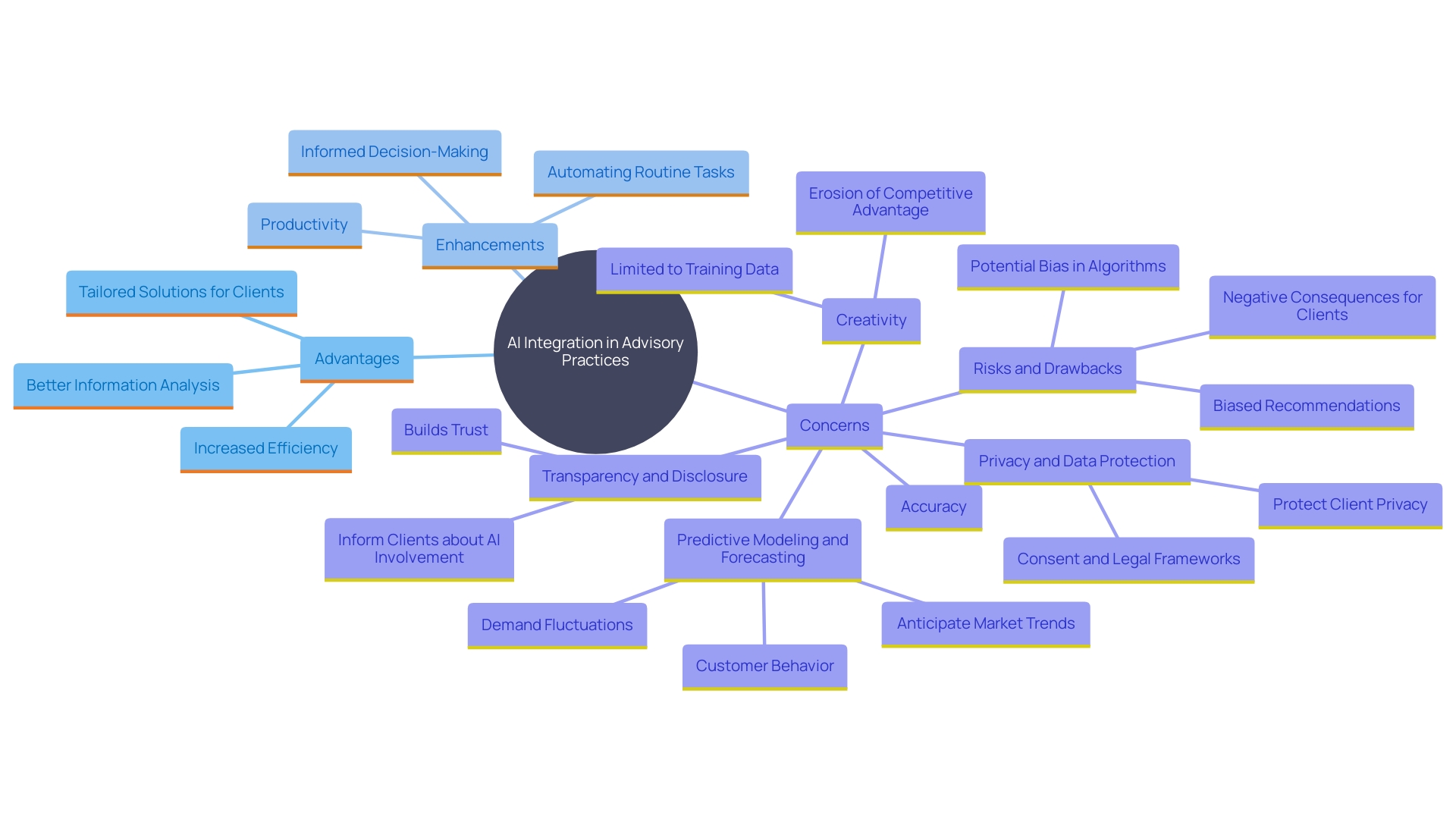
Key Use Cases for AI in Consulting
AI consulting companies are transforming multiple sectors by employing advanced AI solutions. In the financial services industry, Walles.Ai’s fraud detection algorithms have significantly reduced fraudulent activities by identifying anomalous patterns and suspicious transactions, safeguarding assets and enhancing customer trust. Similarly, in the manufacturing sector, Walles.Ai’s smart manufacturing capabilities have optimized production processes, increased employee productivity, and improved profitability by monitoring machine performance and streamlining workflows.
In healthcare, predictive analytics is enhancing patient care and optimizing resource allocation, showcasing Ai’s transformative potential. Additionally, AI-driven tools in market research provide actionable insights by analyzing consumer behavior and predicting trends. These tools allow companies to deliver targeted and measurable strategies, as shown by Marketbridge’s survey, which emphasized AI’s role in utilizing marketing and sales resources more cost-effectively.
Moreover, AI algorithms are crucial in risk evaluation and management by examining historical information to identify potential vulnerabilities. This capability is essential for businesses to anticipate market trends, customer behavior, and demand fluctuations, as noted by the Center for Economic Studies. The introduction of optimized AI applications is not only redefining efficiency but also expanding the technological frontier, empowering businesses to achieve greater operational efficiency, reduce costs, and enhance service delivery.
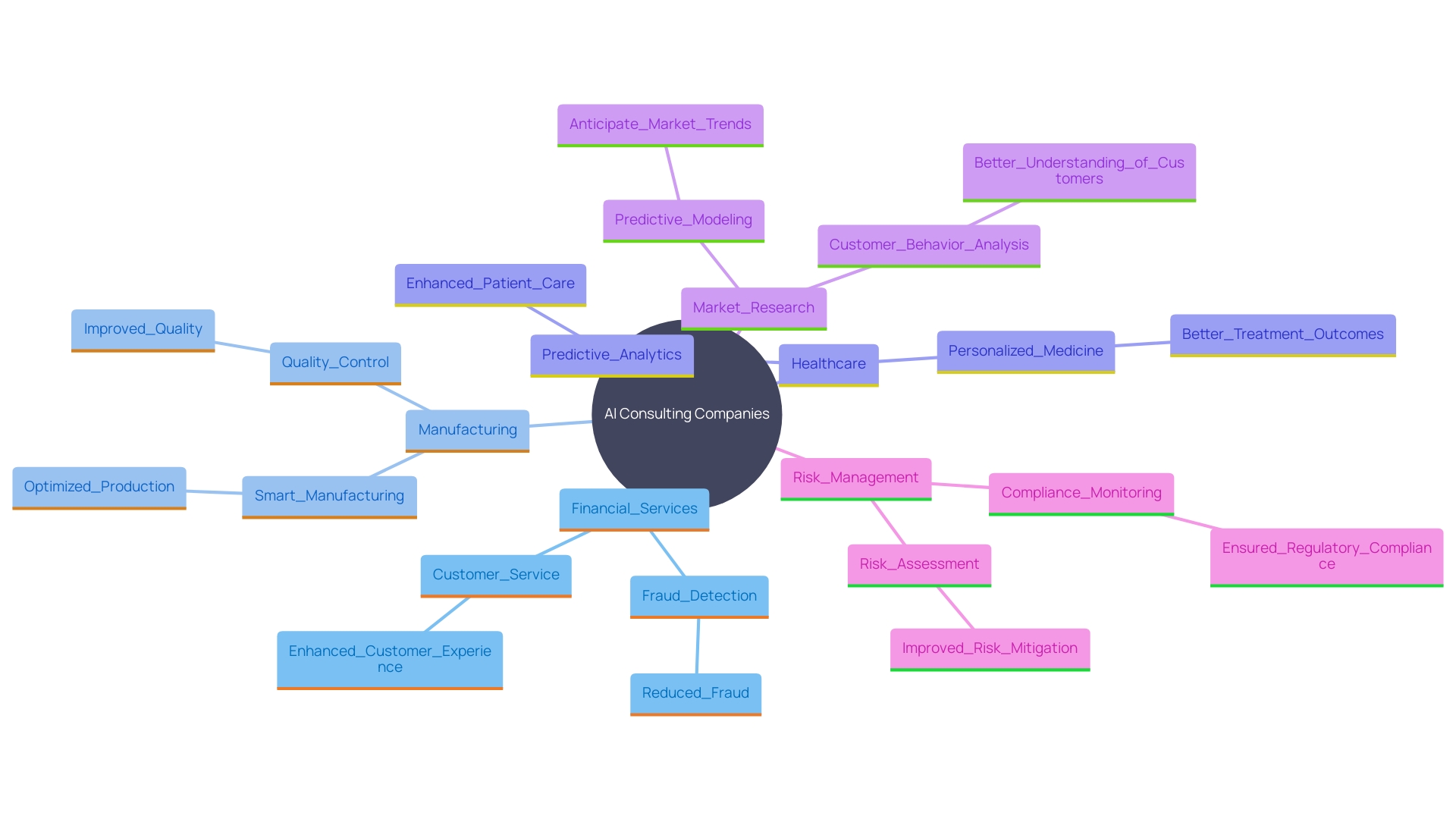
AI-Driven Problem-Solving and Predictive Modeling
‘AI technologies, such as machine learning and predictive analytics, have transformed advisory companies’ capability to address intricate issues with unmatched effectiveness.’. By leveraging predictive modeling, consultants can anticipate future scenarios based on both historical and real-time data. This empowers businesses to stay ahead of market trends, customer behavior, and demand fluctuations. For example, a professional services organization might utilize AI-based models to predict changes in market demand, allowing their customers to modify strategies in advance.
The effect of AI on advisory services is evident. In a study where consultants were tasked with developing new product ideas and writing extensive reports, those utilizing AI completed 12 percent more work at a 25 percent faster rate than their counterparts who did not use AI. This efficiency not only enhances client satisfaction but also establishes the advisory organization as a forward-thinking and trustworthy partner.
However, it’s important to note the potential risks associated with AI, such as algorithmic biases. Since AI models depend on available information, any biases within this information can be amplified, leading to skewed recommendations and decisions. Consequently, it is essential for advisory organizations to thoroughly assess their data providers to guarantee impartial and trustworthy results.
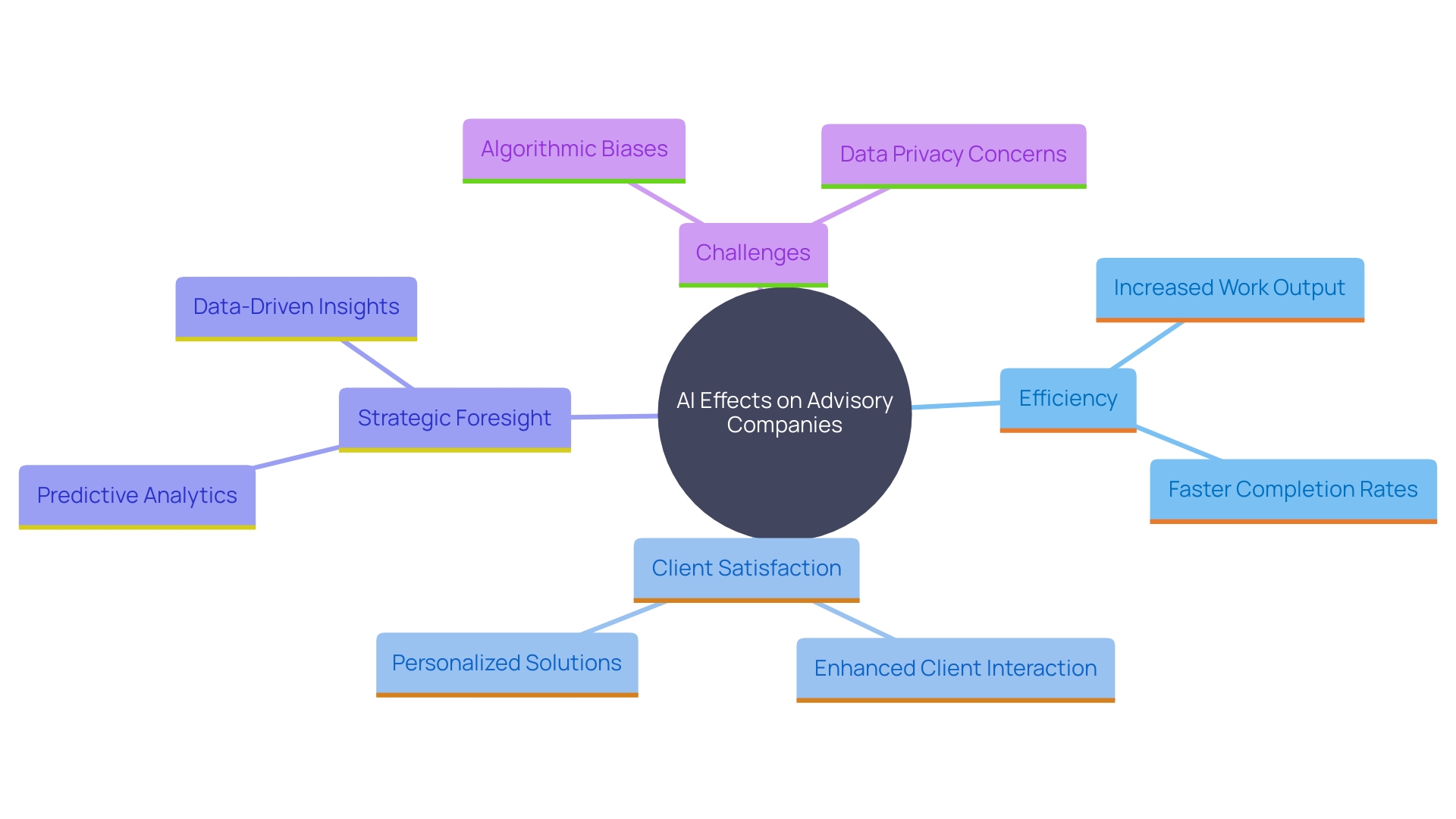
Strategies for Integrating AI in Consulting Practices
Successfully integrating AI in advisory services demands a strategic and methodical approach. At first, companies must carry out a thorough evaluation to pinpoint specific needs and identify areas where AI can provide significant value. Investing in the right AI technologies and tools is paramount, as evidenced by IBM’s success in helping over 4,000 entities transform efficiently and securely through their hybrid cloud platform and AI expertise.
Creating a culture of innovation is critical; this can be achieved through comprehensive training sessions, strategy documents, and best-practice guidelines, ensuring that employees are well-prepared to adopt AI technologies. In fact, knowledge transfer, including training and upskilling, is a fundamental component of any AI advisory engagement, equipping teams with the necessary tools and understanding to implement AI solutions effectively.
Furthermore, establishing strategic partnerships with AI technology providers can significantly enhance capabilities and expedite the implementation process. For instance, the swift adoption of AI among major companies, with 77% utilizing it to inform investment choices, highlights the significance of utilizing external expertise to enhance AI’s advantages.
By following these steps, advisory organizations can not only optimize business procedures and lower expenses but also attain a competitive advantage in their respective sectors.
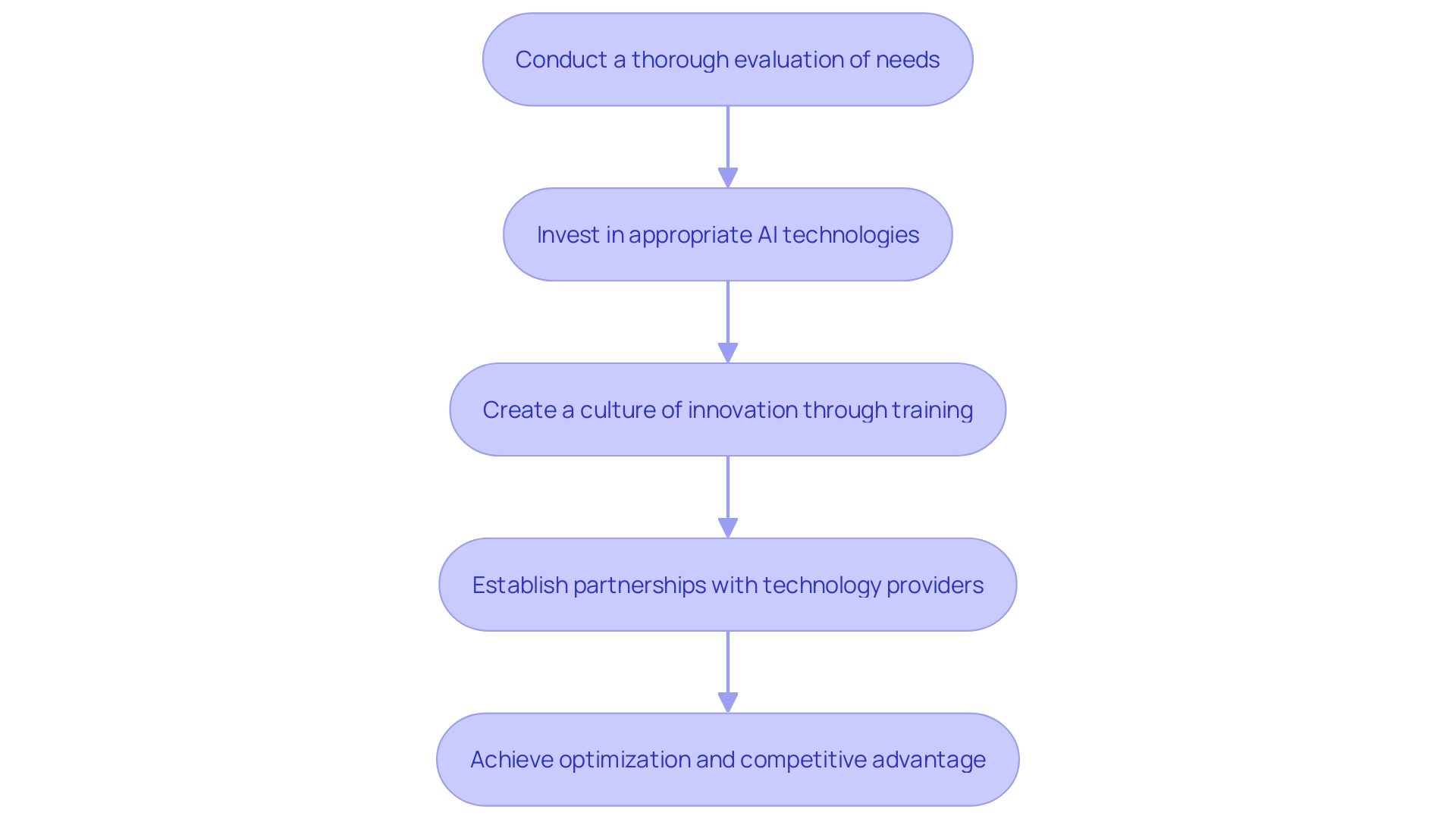
Ethical Considerations and Responsible AI Use
As consulting companies increasingly incorporate AI into their operations, ethical considerations must be at the forefront of their implementation strategies. Ensuring transparency in AI algorithms, protecting user data, and addressing bias in AI models are critical factors. To accomplish this, organizations should create thorough guidelines for responsible AI application, emphasizing ethical considerations and building trust with customers.
The importance of transparency cannot be overstated. Without clear guidelines, organizations can struggle to make informed decisions when faced with ethical challenges. For instance, Unilever’s approach involves both internal and external assessments to identify potential ethical and efficacy risks before deploying AI applications. Statistical tests are then conducted to detect any bias or fairness issues, ensuring the system’s efficacy in achieving its objectives.
Moreover, the lack of a global consensus on responsible AI principles poses a challenge. Different regions have varying ethical standards, making it difficult to establish a universal set of guidelines. This incongruence can influence the practical implementation of AI ethics within multinational firms. Companies must navigate these complexities by creating a framework that balances ethical decision-making with compliance across different jurisdictions.
Safeguarding client information is another essential facet of ethical AI deployment. As emphasized by researchers, there is an urgent requirement for increased public awareness about AI’s effect on information privacy. Companies often conceal the amount of information they gather and how it’s utilized, which can undermine public trust. Consequently, consulting firms ought to emphasize openness and responsibility in their information practices to establish and sustain trust with their customers.
Addressing bias in AI models is equally essential. Predictive modeling and generative AI can inadvertently perpetuate biases present in the training data, leading to biased recommendations and decisions. Companies must actively work to identify and mitigate these biases to ensure fair and equitable results for those they serve.
By prioritizing these ethical considerations, advisory firms can build a sustainable AI strategy that aligns with their values and fulfills customer expectations. This approach not only improves operational efficiency but also promotes long-term trust and cooperation with customers, ultimately driving success in the rapidly evolving AI landscape.
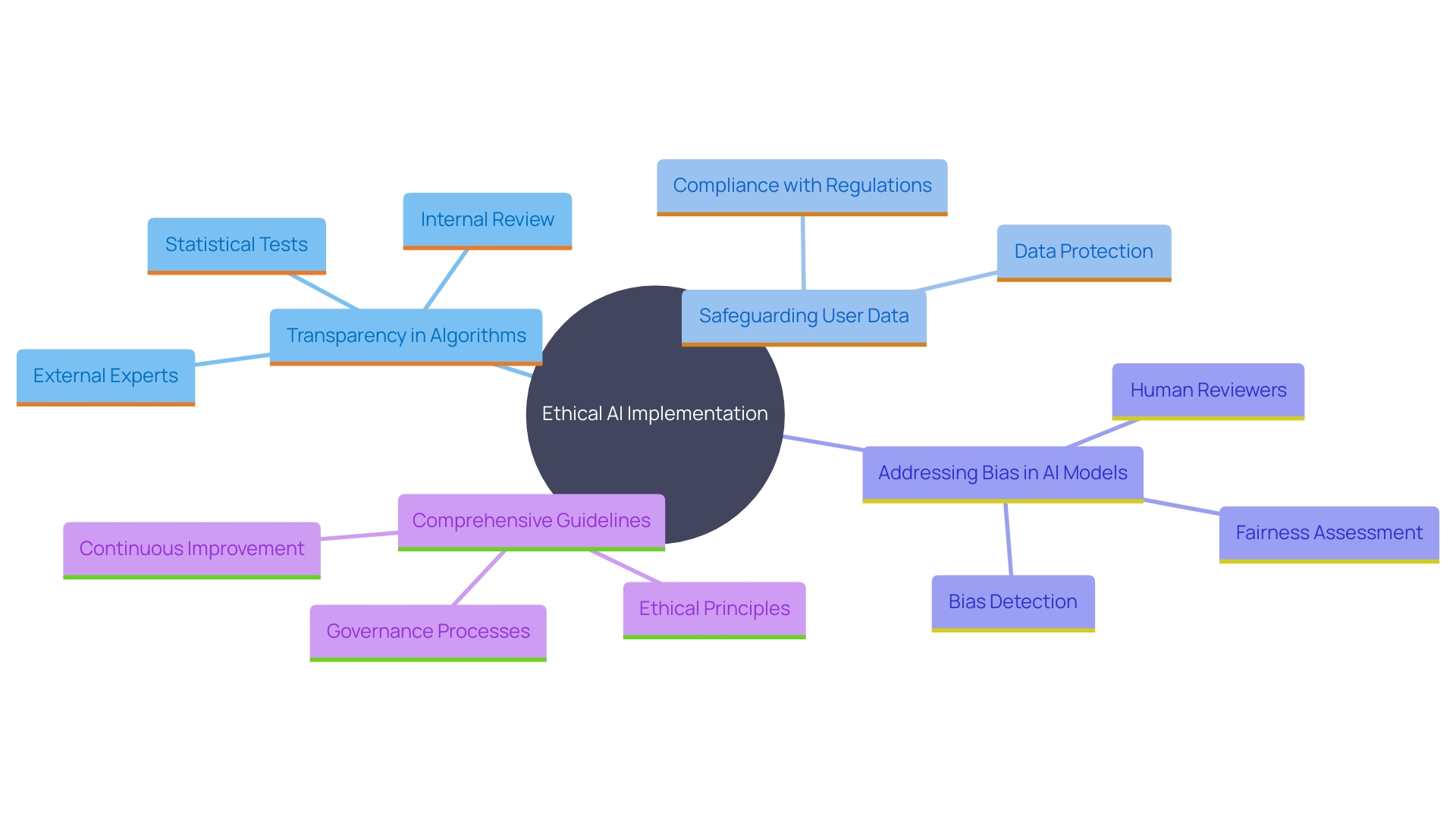
Future of AI in Consulting: Trends and Opportunities
The future of AI in advisory services is set for remarkable expansion, driven by cutting-edge technological advancements and the evolving demands of clients. As businesses navigate the complexities of globalization, digitalization, and changing regulations, AI has emerged as a pivotal tool in enhancing decision-making processes. Businesses are increasingly utilizing AI for purposes in digital transformation and sustainability, taking advantage of its capacity to analyze large volumes of information and create predictive models that anticipate future situations based on past and current data.
The introduction of generative AI models, such as OpenAI’s ChatGPT, has transformed the advisory landscape by enabling the creation of new content, such as text, images, and videos, that are virtually indistinguishable from human-generated outputs. This change has sped up the provision of advisory services, making them more efficient and innovative. However, it’s essential to address the potential biases in AI algorithms to ensure fair and accurate recommendations.
Possibilities are plentiful for advisory organizations to create AI-driven solutions that not only tackle present issues but also foresee upcoming requirements. This proactive approach positions companies as leaders in innovation and strategic advisory. ‘The integration of AI into advisory workflows requires a robust change management strategy and a willingness to embrace new approaches.’. As noted by industry leaders, developing a strategy for AI readiness is crucial for navigating the disruptive impact of technology and harnessing its potential to drive business growth and transformation.
In this dynamic environment, advisory groups that effectively implement AI technologies can achieve significant productivity gains, streamline operations, and enhance their organizational capabilities. The future of AI in consulting promises a landscape where firms that embrace these advancements will lead the way in delivering exceptional value to their clients.
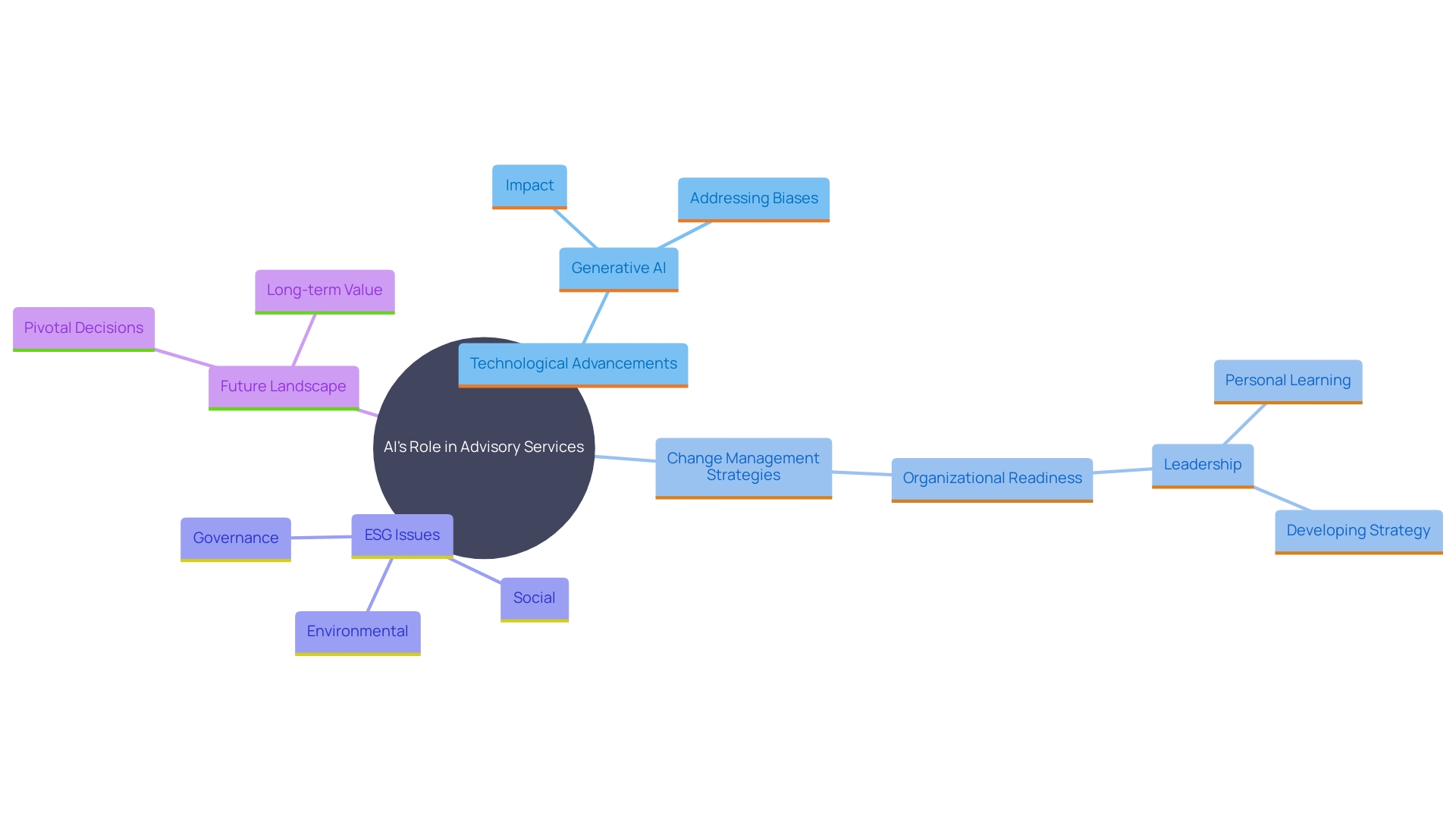
Conclusion
Integrating Artificial Intelligence into consulting practices significantly enhances efficiency, data analysis, and personalized solutions. By automating routine tasks, consultants can concentrate on high-value activities, optimizing resource allocation and accelerating project timelines. AI’s capability to analyze vast datasets provides deeper insights, leading to informed decision-making and tailored recommendations that boost productivity and client satisfaction.
Key applications of AI across sectors, such as fraud detection in finance and predictive analytics in healthcare, showcase its transformative potential. As firms rapidly adopt AI technologies, strategic partnerships and the right investments become essential for enhancing capabilities and maintaining a competitive edge.
However, the integration of AI also requires a strong focus on ethical considerations. Transparency in algorithms, data protection, and bias mitigation are critical for building trust and ensuring fair outcomes. Establishing comprehensive guidelines for responsible AI use is vital for navigating these challenges effectively.
Looking forward, the future of AI in consulting presents numerous opportunities. By embracing innovative technologies, firms can anticipate client needs and drive strategic growth. The effective implementation of AI not only promises productivity gains but also positions consulting firms as leaders in delivering exceptional value in a complex business landscape.
Introduction
In today’s rapidly evolving business landscape, the adoption of payment automation is no longer a luxury but a necessity. This transformative technology redefines financial efficiency, enabling organizations to streamline processes, reduce errors, and enhance cash flow management. By automating payments, businesses can minimize manual tasks, leading to significant time and cost savings.
This shift not only improves operational accuracy but also fosters stronger vendor relationships by ensuring timely and consistent transactions. As companies like St. James Winery and Cracker Barrel have demonstrated, integrating automation can address labor shortages, enhance security, and ultimately drive better financial performance. Moreover, the strategic implementation of automation in accounts payable and receivable processes unlocks unprecedented control and insight, empowering organizations to focus on innovation and strategic growth.
The following sections delve into the myriad benefits of payment automation, key areas for its application, and practical steps for effective implementation, illustrating how businesses can harness this powerful tool to achieve operational excellence and sustained success.
Benefits of Automating Payments
Automating transactions revolutionizes financial processes by significantly reducing the time spent on manual entries and approvals. This transformation leads to quicker payment cycles, fostering stronger vendor relationships and enhancing trust. For instance, St. James Winery, one of the leading wine producers in the U.S., experienced higher margins and improved efficiency by incorporating mechanization, addressing labor shortages, and scaling operations seamlessly. Furthermore, mechanization reduces human mistakes, which can lead to expensive errors, guaranteeing reliable and foreseeable monetary transactions.
The efficiency achieved through mechanization allows teams to concentrate on strategic initiatives rather than repetitive tasks, ultimately driving better financial performance. Companies that have embraced full AP and AR automation report significant cost savings and increased cash flow. For example, businesses that automate expect to see accurate, efficient, and streamlined processes, with over 90% anticipating improved data availability and insights within the next three years. Straight-through processing (STP) further enhances this transformation by expediting transaction processing, reducing errors, and eliminating repetitive tasks, making it a strategic business imperative in today’s fast-paced landscape.
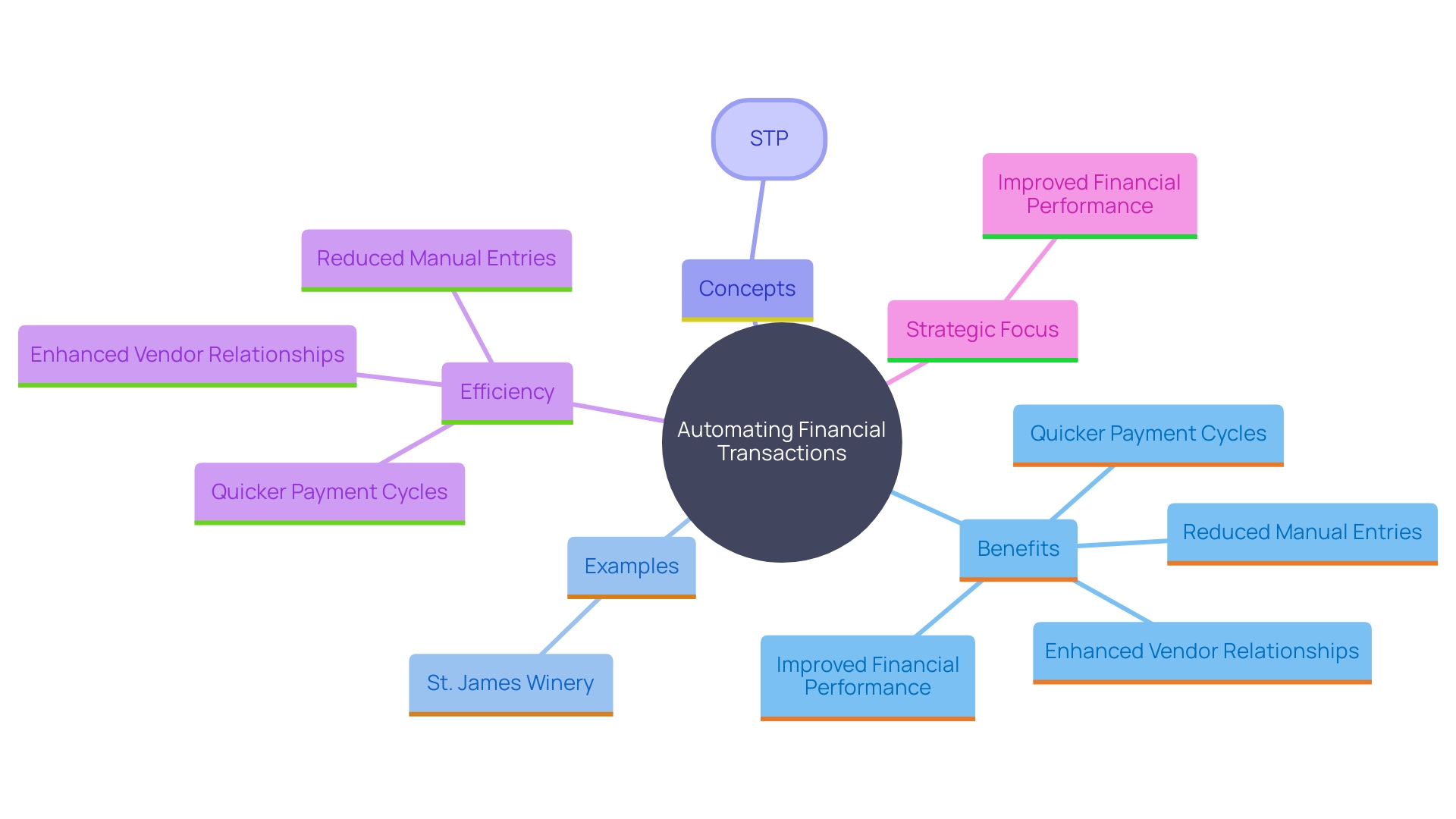
Key Areas for Payment Automation
‘Payment streamlining plays a crucial role across various stages of monetary workflows, significantly enhancing efficiency and precision.’. In invoice processing, automation captures data directly from documents, eliminating manual entry and reducing potential errors. This not only saves time but also ensures data accuracy, which is essential for maintaining monetary integrity. Automated transaction approvals leverage predefined workflows to expedite authorizations, enabling faster processing and reducing bottlenecks.
Automated reconciliation processes align transactions to invoices, simplifying monetary operations and ensuring consistency between bank statements and internal records. This integration reduces the risk of human error, as highlighted by the reduction in workload noted by companies like SeatGeek, which saw a decrease from 20 hours to just one hour per week on expense management due to AI-powered technology.
Furthermore, mechanization in reporting produces immediate insights, empowering decision-makers with current economic data for improved strategic planning. ‘Starbucks’ experiment with contactless transactions via geolocation demonstrates how automation can enhance customer experiences by reducing transaction times and errors. The integration of RPA and AI in economic systems not only improves operational efficiency but also enhances data security by minimizing manual data entry and identifying potential fraudulent activities.
Incorporating these automated solutions enables businesses to redirect valuable resources to strategic initiatives, fostering innovation and critical thinking. As banks and transaction firms modernize their platforms, the focus on security remains crucial to ensure consumer trust while delivering seamless, hassle-free transactions. The overall effect of transaction automation is significant, providing companies with unparalleled authority and understanding of their economic operations.
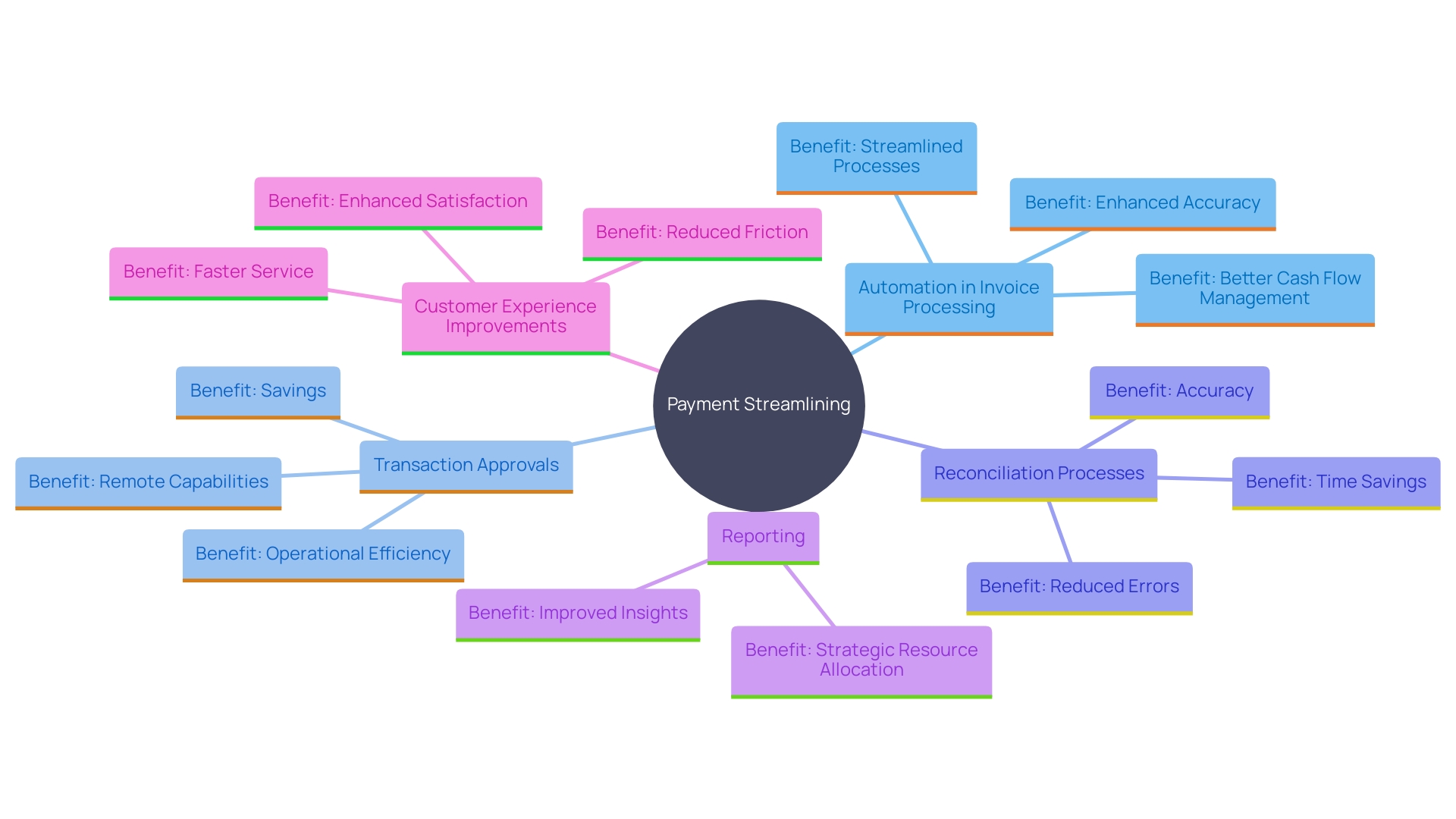
Improving Financial Efficiency with Automation
Automating payment systems can revolutionize financial efficiency for organizations. The transition from manual to automated systems significantly reduces the days payable outstanding (DPO), thereby improving cash flow management. For instance, Cracker Barrel, a restaurant and retail chain, reduced their reconciliation process from over 40 hours to under two hours per month, resulting in $15,000 annual savings on manual processing costs. This shift also eliminated credit card fraud for hotel charges, demonstrating the security benefits of automation.
Automated systems enhance transparency, enabling better tracking of expenditures and more accurate forecasting. ‘The integration of transaction solutions with existing financial systems not only streamlines operations but also optimizes resource allocation, ultimately reducing operational costs.’. As noted in a report by the Association for Financial Professionals, 46% of organizations transitioned from paper checks to electronic transactions to facilitate straight-through processing (STP), which accelerates the remittance and settlement process, minimizing errors and enhancing efficiency.
‘Real-time transaction data offers significant potential for improving business cash flow, enhancing customer experiences, and reducing costs.’. With newer transaction rails like RTP and FedNow, funds can be transferred within seconds, 24/7, providing businesses with the agility needed in today’s fast-paced environment. This increased efficiency and quality in financial transactions help organizations stay competitive and responsive to market demands.
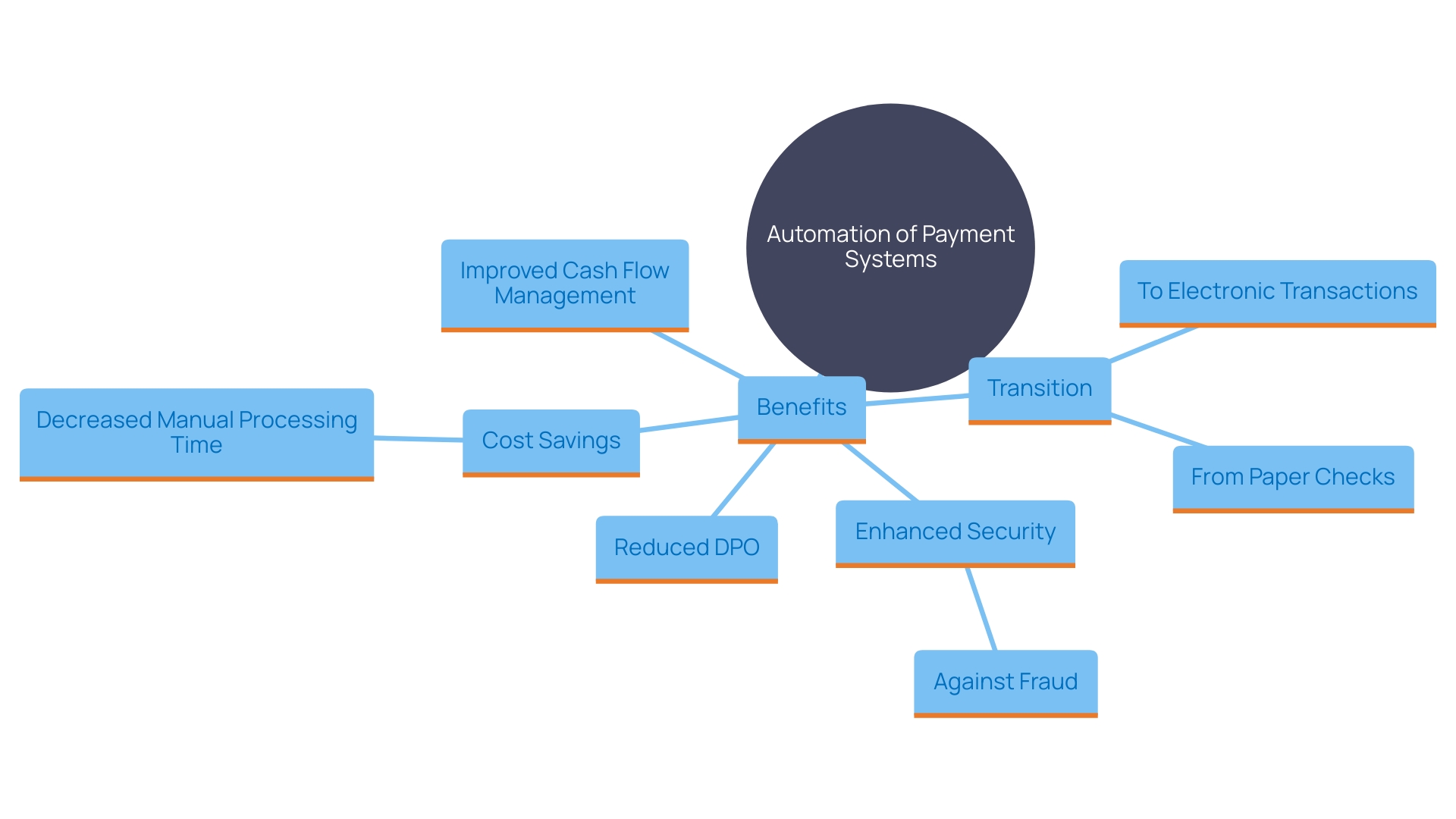
Enhancing Cash Flow Management
Automating transactions significantly enhances cash flow management by ensuring timely disbursements and minimizing delays. Organizations can implement scheduled transactions to avoid late fees and capitalize on early settlement discounts. This proactive approach allows for more accurate cash flow forecasting, helping companies allocate resources more effectively and make informed financial decisions. According to a report in collaboration with Wex, secure and streamlined transaction processes are highly valued by heads of finance in middle-market firms. Flexibility and simplicity in transaction conditions are important for 22% and 20% of respondents respectively. This focus on efficient transaction systems is crucial, especially as more than 90% of heads of finance experienced frictions when settling with suppliers in the past year. The incorporation of artificial intelligence (AI) can further improve operational efficiency, making transaction methods smoother and more dependable. As a result, firms can better manage supplier relationships and mitigate uncertainties, ensuring operational efficiency and stability.
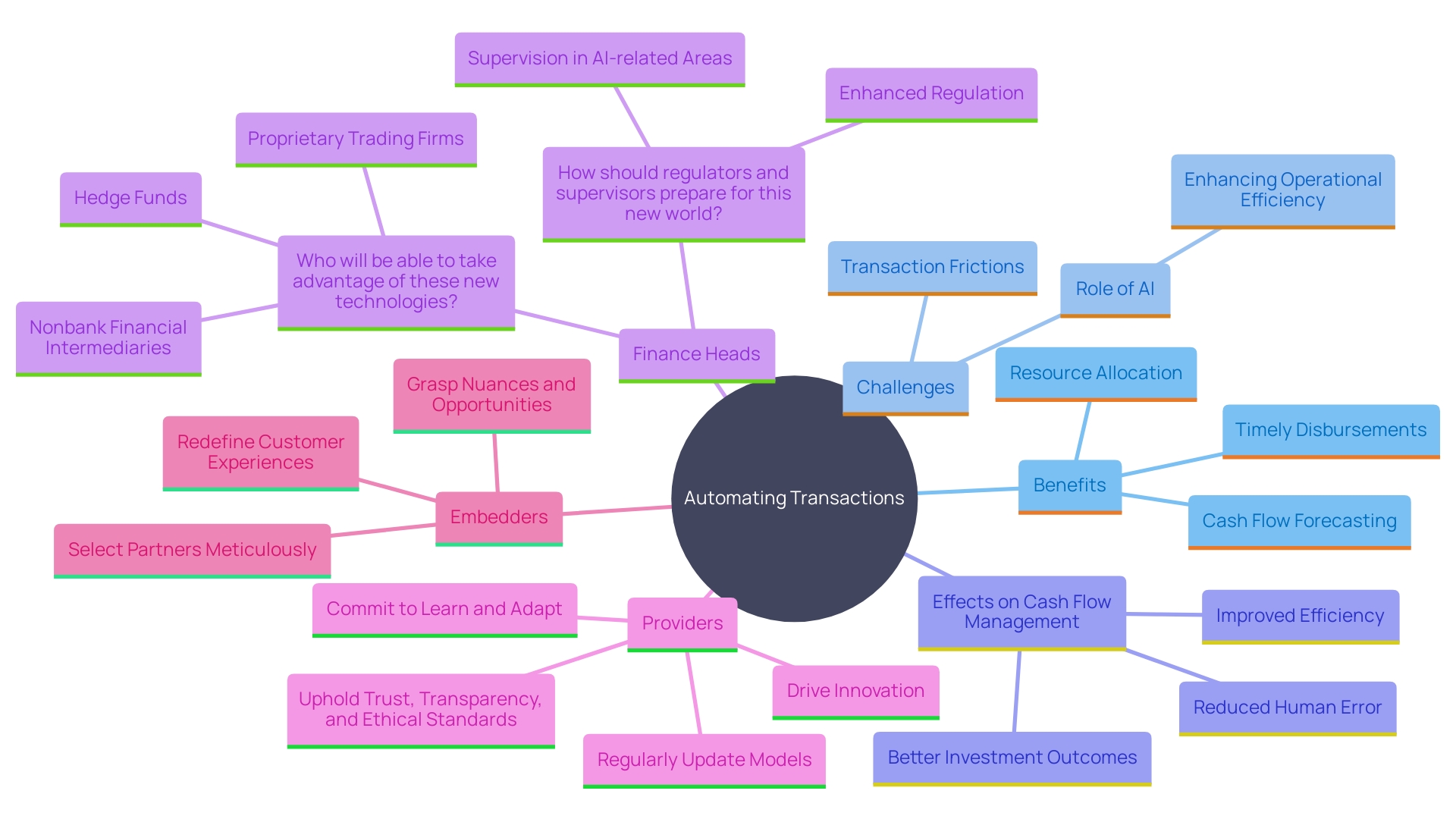
Reducing Errors and Fraud
Automated payment systems have transformed the manner in which transactions are managed, significantly lowering the risk of mistakes usually linked with manual data entry. These systems offer enhanced security measures such as multi-factor authentication and encryption, which are crucial in mitigating the risk of fraud. For instance, the implementation of real-time online transaction pre-authorization processes helps combat credit card fraud by screening transactions almost instantaneously, allowing only legitimate ones to proceed.
The integration of artificial intelligence (AI) further elevates security by analyzing transaction patterns to detect potential fraudulent activities. Visa’s new AI-driven system, Visa Provisioning Intelligence, exemplifies this by utilizing machine learning to evaluate transactions according to their probability of fraud, significantly assisting institutions in minimizing losses.
Moreover, by establishing clear protocols and audit trails, organizations can ensure compliance with regulatory standards and protect sensitive financial information. This proactive approach not only safeguards data but also provides a competitive advantage by fostering trust among customers who expect secure and seamless transactions in today’s digital age. With the added convenience and efficiency of automated systems, businesses can redirect their resources towards innovation and strategic initiatives, ultimately driving growth and resilience.
Streamlining Accounts Payable and Receivable
Automation has become a pivotal element in optimizing accounts payable (AP) and accounts receivable (AR) functions, yielding significant benefits for organizations of all sizes. In AP, automated workflows accelerate approval procedures and transactions, ensuring prompt and precise dealings. This is especially important as 66% of businesses view AP activities as vital for sustaining operational efficiency.
On the AR side, automation enhances invoicing and payment collections, reducing the time and effort required to manage outstanding payments. Automated reminders and follow-ups ensure that invoices are paid promptly, which is vital for maintaining a healthy cash flow. This synchronization between AP and AR activities not only enhances cash flow but also increases overall operational efficiency.
Based on a PYMNTS Intelligence and American Express study, 29% of companies have automated their AP and AR tasks in the past two years, influenced by remote work necessities. The advantages of mechanization, including streamlined processes, enhanced accuracy, and improved cash flow management, are evident. However, the approach to automation varies based on company size. Large companies with intricate requirements emphasize remote functionalities, while smaller businesses concentrate on transactions that provide economic benefits such as discounts for prompt returns. Mid-size companies, conversely, aim for consistent contributions to improve long-term operational effectiveness, with 42% concentrating on consistent amounts and 36% on regular intervals.
The process of streamlining can greatly lower operational expenses and enhance fiscal clarity, allowing companies to redirect savings to other essential sectors such as inventory acquisition and supplier transactions. By adopting mechanization, organizations can manage the intricacies of money handling more efficiently, ensuring ongoing business success.
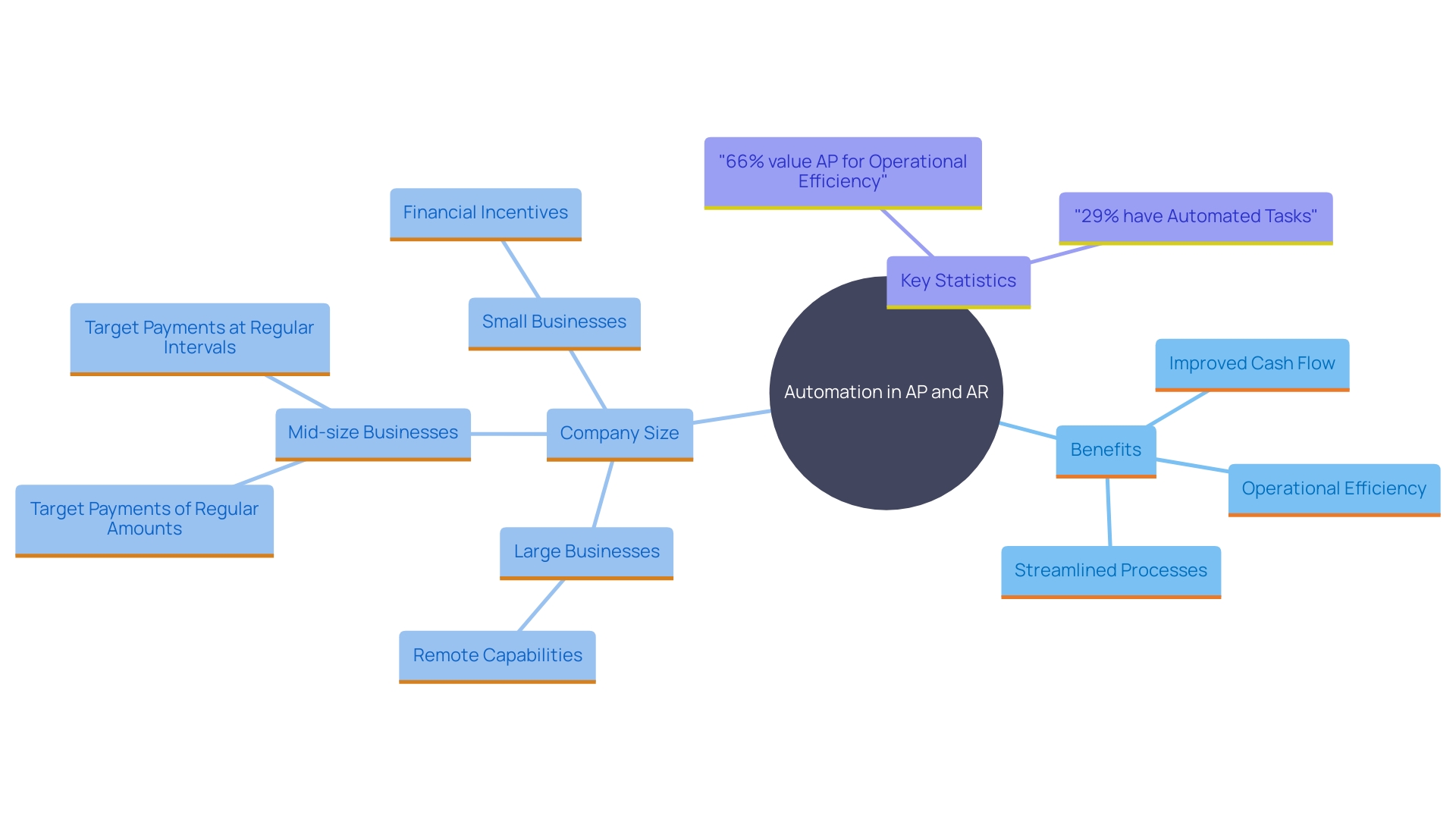
Implementing Payment Automation
Implementing payment processing effectively requires strategic planning and careful execution. Begin by thoroughly assessing current financial workflows to pinpoint inefficiencies and potential areas for improvement. Choosing the right technology that seamlessly integrates with existing systems is fundamental. For example, when a hospital network set up a new technology team, they collaborated with finance experts to reorganize workflows and create a tool that suited the new method. This partnership not only simplified processes but also liberated staff for more valuable assignments, highlighting the transformative impact of technology.
Training staff and setting up clear processes are vital for a smooth transition. This approach was evident in the case of a finance department that utilized technology to manage data more efficiently, allowing for scalability and improved handling of an increased number of transactions. Moreover, integrating automation with data analytics can help identify trends and make informed decisions, leading to more strategic resource allocation.
Safety and confidentiality are crucial in transaction technologies. Managers should invest in robust security measures and maintain transparent communication about data protection practices to build trust with users. As stated in a report from the Association for Financial Professionals, 46% of organizations transitioned to electronic transactions to enable straight-through processing (STP). This system automates the entire payment process, reducing errors and increasing efficiency.
As businesses continue to navigate the shift towards automation, it’s essential to understand that the approach may vary by company size. Large firms often require remote capabilities, while smaller firms may focus on immediate financial incentives. Mid-size companies, targeting regular payments, can achieve long-term operational efficiency, improving cash flow management and redirecting savings to optimize operations further. By integrating automation, companies not only streamline processes but also enhance security, reduce manual intervention, and ultimately improve the overall customer experience.

Conclusion
The integration of payment automation emerges as a critical strategy for organizations aiming to enhance financial efficiency and operational performance. By significantly reducing manual tasks, automating payments allows businesses to streamline workflows, minimize errors, and foster stronger relationships with vendors. As evidenced by case studies from companies like St. James Winery and Cracker Barrel, these efficiencies translate into tangible benefits, including cost savings and improved cash flow management.
Furthermore, payment automation serves multiple facets of financial operations, from invoice processing to reconciliation and reporting. The role of artificial intelligence and real-time data analytics cannot be overstated, as they empower organizations to make informed decisions and optimize resource allocation. The transition to automated systems not only mitigates risks associated with manual data entry but also enhances security, ensuring compliance and building trust among customers.
Implementing payment automation is not merely about adopting new technology; it requires strategic planning, staff training, and a focus on security measures. As organizations navigate this transformative journey, a tailored approach that considers company size and specific needs will be essential. Embracing automation will not only lead to improved operational efficiency but also position businesses for sustained growth and innovation in an increasingly competitive landscape.
